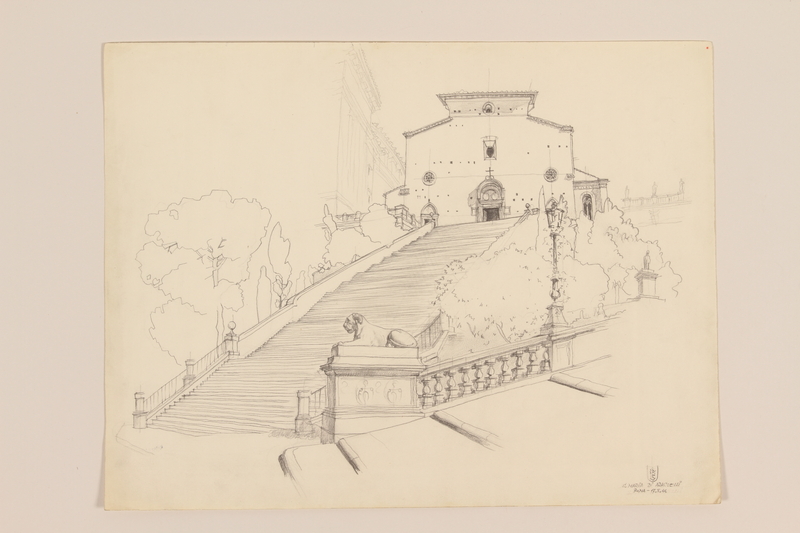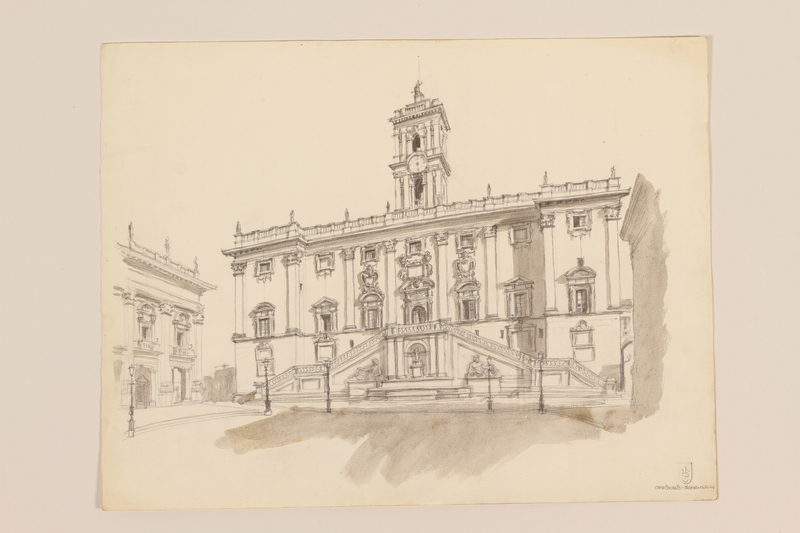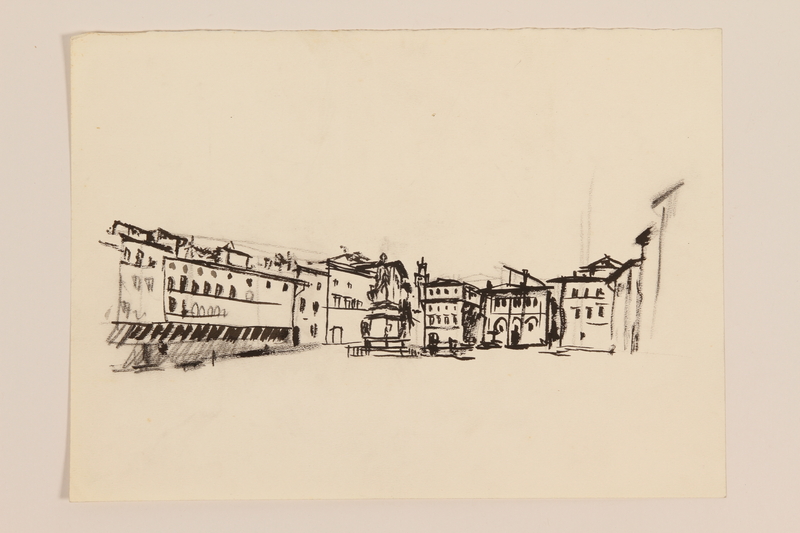Overview
- Brief Narrative
- Portfolio of 11 architectural studies of buildings in Rome created by Edward Herzbaum in 1946 when he studied architecture at the University of Rome, following service as a soldier in the 2nd Polish Corps from 1942-1945. When Edward was 19, he left Łódź, Poland, shortly after Nazi Germany occupied the country in September 1939 for Soviet controlled Lvov. In June 1940, Edward was exiled to a gulag by Soviet security police. Germany invaded the Soviet Union in June 1941. Edward was released in an amnesty of Polish prisoners. He joined the Polish Army of the East, known as Anders Army. In August 1942, the unit left Soviet territory and became the 2nd Polish Corps, British Army. In February 1944, they joined the British 8th Army in Italy. The Corps fought its way north and was honored for heroism in the Battle of Monte Cassino. They celebrated VE Day, May 8, 1945, in Italy. Edward learned that his mother died in Łódź Ghetto in 1943. He studied architecture in Rome until the British decided to allow Polish Corps veterans to immigrate to England in October 1946. He then served in the Polish Resettlement Corps for two years, completed his degree, and eventually set up his own architecture firm.
- Series Title
- Roma 1946
- Date
-
creation:
1946 October 02-1946 October 20
- Geography
-
creation:
Rome (Italy)
depiction: various buildings; Rome (Italy)
- Credit Line
- United States Holocaust Memorial Museum Collection, Gift of Krystyna Mew
- Markings
- a. cover, pastel, chalk, pencil : Roma / 1946
b. front, lower right, pencil : E monogram / S Maria di Aracoelli / Roma - 19.X.46
c. front, lower right, pencil : E monogram / Campidoglio / Roma - 11.X.46
d. front, lower right, pencil : E monogram / S. Onofrio / Roma - 5.X.46
e. front, lower right, pencil : E monogram / Castel S. Angelo / Roma - 20.X.46.
f. front, lower right, pencil : E monogram / S. Pietro / Roma - 5.X.46
g. front, lower right, pencil : E monogram / Teatro di Marcello / Roma - 19.X.46
h. front, lower right, pencil : E monogram / Castel S. Angelo / Rome - 2.X.46
i. front, lower right, pencil : E monogram / Castel S. Angelo / Rome - 5.X.46 - Contributor
-
Artist:
Edward H. Hartry
Subject: Edward H. Hartry
- Biography
-
Edward Henryk Herzbaum (later Hartry) was born on October 6, 1920, in Vienna, Austria. He was the only son of a Jewish couple, Dr. Alexander and Fanny Hermelin Herzbaum. Alexander was a chemical engineer, born in Tarnow, Poland, in February 1886 to Mendel (1855-1930) and Chana Ettinger Herzbaum, who married in 1882. They also had a daughter Gisela (1884-1912.) Chana died in 1886. In 1888, Mendel married Beila Lea Ettinger (b. August 22, 1864). Mendel and Beila had two children: Jakob (1888-1966) and Herman. Edward's mother Fanny was born in Boryslaw, Poland, near Lvov on May 30, 1890, to Samuel (d. 1922) and Chaje Sara Backenroth Hermelin. Fanny had four siblings, Rifke (b. 1883), Cirl (b. 1888), Zacharje (1884-1925), and Abraham (1885-1886.) In 1928, Edward's family moved to Poland and settled in Zawiercie. Edward had asthma and wore glasses, as he was very shortsighted. In 1934, they moved to Łódź. Alexander, 51, died in July 1937 of cancer. Edward graduated from high school in May 1938, and deferred his military service to enroll at the Warsaw Polytechnic, Faculty of Architecture. He had completed two semesters when Germany invaded Poland on September 1, 1939. Edward joined the Polish Auxiliary Forces as a volunteer and was arrested by the Germans with other paramilitary youth a few days later. Edward escaped and returned to Łódź. The Soviet Union invaded and occupied eastern Poland. German occupying authorities in Łódź enacted oppressive anti-Jewish measures. At the urging of his mother, Edward, then 19, left Łódź on December 6, 1939, and went east to Lvov, which was under Soviet control.
In Lvov, Edward lived with his maternal aunt and had an assortment of jobs, including office worker at a construction site, skiing instructor, and lifeguard at a swimming pool in a Soviet sports center. In June 1940, Edward was arrested by the NKVD (Soviet Security Police), tortured, and exiled to a gulag near Rybinsk on the Volga River. The prisoners logged and hauled trees in freezing temperatures. They worked on the construction of a reservoir and hydro-electric plant. The camp was primitive, and the inmates suffered from starvation, exhaustion, and brutal treatment from the guards. Edward spent months in the infirmary, but his poor health did not exempt him from abuse. Around this time, Edward began to keep a journal.
In June 1941, Germany invaded the USSR. The Soviets issued an amnesty of the Polish forced laborers and other Soviet prisoners. Some were needed to work in factories and agriculture to replace the Russians mobilized into the Red Army. Other prisoners were released to join the fight against the Germans. An agreement was signed between the Polish Government in Exile and the Soviet government to form a Polish Army in the East, commanded by General Wladyslaw Anders. After his release, Edward traveled south to Tatischewo (now Turkmenbasy) in Turkemenistan in September, and joined Anders Army as a soldier in the 5th Kresowa Infantry Division. It was a difficult existence, as the Soviets were unwilling to supply enough food or equipment to sustain the Polish soldiers. On August 17, 1942, they left Soviet territory, crossing the Caspian Sea to Pahlevi, Iran (now Bandar-e-Anzali.) At this point, they were placed under the control of the British government and became the Polish Second Corps, a unit of the British Army affiliated with the Polish Armed Forces in the West. The troops travelled through Bakhtaran (now Kirmanshah) then to Khanaqin, Iraq, as they received training from British forces.
Edward’s health improved as he got out of the Soviet Union, and food and supplies were plentiful. However, the increasingly horrifying news from Poland affected him deeply, and he experienced bouts of depression. Painting and drawing materials were available and Edward began to document events with sketches and watercolors. In March 1943, the Corps was in Habbaniya, Iraq, and in September, went to Nuseirat, Palestine. In February 1944, the unit moved to Quassasin, Egypt. The Polish soldiers were fully trained now and, on February 18, Edward and his division boarded the M.S. Dilwara in Port Said for Taranto, Italy, where they joined the Italian Campaign under the command of the Eighth British Army. They fought their way north through Italy, experiencing high casualties, especially in the May 1944 final Battle of Monte Cassino, the fourth assault on those German defenses since January 1944. Edward visited the cemetery at Aquafondate and saw the names of many men he knew well. Edward, although Jewish by birth, was an atheist and, for him, the comradeship and closeness between soldier’s transcended class and religion. They relied on each other completely, as they experienced the trauma of war together. In June, the Corps fought in the Adriatic Campaign, including the Battle of Ancona, capturing the city on July 18, 1944.
The war ended in early May 1945 with Germany's surrender. Many Polish soldiers did not want to return to their now communist-run country and had to wait in Italy while the British Army determined what to do. Edward learned that his mother had died in Łódź Ghetto. He was given leave to resume education and studied architecture at the University of Rome from March - September 1946. In October, Edward and other Polish veterans sailed from Naples on the SS Marine Raven, arriving in Glasgow in early November. Edward was assigned to an army camp near High Wycombe. In September 1947, he was given leave to study architecture at Polish University College in London. He was discharged as a private from the Polish forces and listed as a member of the Polish Resettlement Corps from November 1947-June 1949.
In 1949, Edward changed his name from Herzbaum to Hartry, following the example of a cousin, Ted, who had escaped to the US where he joined the US Army. Edward completed his architecture studies in June 1950. He was an architect's assistant at the London County Council. In 1952, he became a British national. In his naturalization form, he states that his mother died in 1940-1941, exact date not known. He never knew the details of her passing. Records discovered later said Fanny, 53, died of peritonitis in Łódź Ghetto on December 12, 1943. Edward established an architectural firm with two partners. In 1956, Edward, called Edek, married Teresa Jaskolska, a Polish Catholic woman. She had a daughter from a previous marriage and the couple had a daughter in 1957. Edward, 47, died on February 22, 1967, of cancer. After Teresa’s death in 2002, his daughter Krystyna Mew discovered his wartime artwork and journals, which were translated and published in 2010 as Lost between Worlds: A World War II Journey of Survival.
Physical Details
- Language
- Italian
- Classification
-
Art
- Category
-
Drawings
- Object Type
-
Architectural drawing (lcsh)
- Physical Description
- Alphabetical components for cataloging only. Most drawings are in pencil on paper. All are signed and dated in the lower right corner.
a. Handmade bifold folder, now soiled, of light gray paper with 4 glued on flap extensions to keep the 11 drawings inside. The front center has a stylized monogram E drawn in white chalk; below is Roma in red letters over the year 1946.
b. Architectural study of the facade and monumental staircase of S. Maria di Aracoeli viewed looking up from the street where the stairs intersects with the lion on a pedestal. The adjacent ornate balustrade and lamp are rendered in detail, while the shrubs and background buildings are faintly sketched. It is signed and dated in the lower right. 12.750h x 16.750w.
c. Architectural study in pencil with ink wash shading of Campidoglio facade with windows detailed. Pencil underdrawings emphasize the parallel and perpendicular lines. 12.875h x 16.750w.
d. Architectural study in pencil of S. Onofrio facade without ornamental details. 12.875h x 16.750w.
e. Architectural study in pencil of the balustrade and partial facade of Castel S. Angelo. 12.750h x 16.875w.
f. Ink sketch of an open piazza with house facades in the center back and left drawn in thick, strong, gestural strokes. 9.125h x 12.750w.
g. Architectural study in pencil of the dome of S. Pietro, with medium detail, as a perspective analysis with a tree in the foreground twice as large as the dome.
h. Architectural study in pencil of Teatro di Marcello, finely detailed with shadows, various types of brick, highlighting the vertical lines of the columns. 16.750h x 12.875w.
i. Ink study of a doorway highlighting the vertical lines. Unnamed. 15.00h x 11.250w.
j. Pencil and ink wash study of a cityscape with a detailed drawing of the dome of St. Peter's. 9.00h x 12w.
k. Pencil sketch of Castel S. Angelo. 12.875h x 16.875w.
l. Architectural study in pencil of the facade of Castel S. Angelo. 12.750h x 16.875w.
m. Architectural study in pencil of a detail of the exterior of Castel S. Angelo. 12.750h x 16.875w. - Dimensions
- overall: Height: 17.250 inches (43.815 cm) | Width: 13.250 inches (33.655 cm)
- Materials
- overall : paper, graphite, pastels, chalk, ink, ink wash
Rights & Restrictions
- Conditions on Access
- No restrictions on access
- Conditions on Use
- No restrictions on use
Keywords & Subjects
- Topical Term
- Cassino, Battle of, Cassino, Italy, 1944. Holocaust, Jewish (1939-1945)--Poland. Jewish soldiers--Poland. World War, 1939-1945--Campaigns--Italy. World War, 1939-1945--Conscript labor--Soviet Union. World War, 1939-1945--Participation, Jewish.
- Personal Name
- Hartry, Edward Henrik, 1920-1967.
Administrative Notes
- Legal Status
- Permanent Collection
- Provenance
- The portfolio was donated to the United States Holocaust Memorial Museum in 2012 by Krystyna Mew, the daughter of Edward (Herzbaum) Hartry.
- Funding Note
- The cataloging of this artifact has been supported by a grant from the Conference on Jewish Material Claims Against Germany.
- Record last modified:
- 2023-08-25 12:47:45
- This page:
- https://collections.ushmm.org/search/catalog/irn61378
Download & Licensing
In-Person Research
- By Appointment
- Request 21 Days in Advance of Visit
- Plan a Research Visit
- Request to See This Object
Contact Us
Also in Edward Herzbaum Hartry collection
The collection consists of artifacts, artwork, medals, correspondence, documents, a journal, photographs, and publications relating to the experiences of Edward Herzbaum (from 1949, Edward Hartry) during the German invasion of Poland, his imprisonment in a slave labor camp in the Soviet Union, his service in the 2nd Polish Corps, British Army (Anders Army) during World War II, and his emigration to Great Britain after the war.
Date: 1940-1949

Edward Herzbaum Hartry papers
Document
The Edward Herzbaum Hartry papers consist of biographical, photographic, and printed materials as well as diaries and short stories documenting Hartry, his pre-World War II education in Łódź and Warsaw, his imprisonment in a Russian gulag following the German and Russian partition of Poland, his military service with the Polish Second Corps and Polish Resettlement Corps, his postwar education and certification as an architect in Rome and London, and his naturalization as a British citizen in 1952. Biographical materials consist of identification papers, membership cards, and student, military, and immigration records documenting Hartry, his prewar education in Łódź and Warsaw and postwar education in Rome and London, his World War II military service with the Polish Second Corps and Polish Resettlement Corps, and his naturalization as a British citizen in 1952. Photographs depict Hartry as a child with his parents and as a soldier with the Polish Second Corps and scenes from the Middle East and Egypt. Postcards from Italy, Switzerland, France, and Wales exchange postwar messages among Hartry and his friends. Printed materials include illustrations by Hartry for 1945 issues of Uwaga Nadchodzi!: Miesiecznik Artylerii Przeciwlotniczej, a Polish military magazine identifying allied and enemy aircraft, as well as issues of the magazine including Hartry’s illustrations, a newspaper supplement mapping the theaters of war, and a 1946 issue of Parada: Illustrated Fortnightly for the Polish Forces. Writings primarily consist of Hartry’s 1940- 1945 original, recopied, and revised journal entries documenting his experiences from the September 1939 invasion, his imprisonment in a slave labor camp in Vologda district, release and mobilization to newly formed Polish Army in September 1941, travel and training in Iran, Iraq, Palestine, and Egypt, and combat in Italy, including at Monte Cassino. These entries were later published in 2010 as Lost between Worlds: A World War II Journey of Survival. This series also includes Hartry’s notes taken during his military training and short stories he drafted.

Briar billiard pipe used by a Jewish soldier, 2nd Polish Corps
Object
Briar billiard pipe used by Edward Herzbaum, a soldier in the 5th Krestowa, 2nd Polish Corps, British Army. Edward, 19, left Łódź, Poland, shortly after Nazi Germany occupied the country in September 1939 for Soviet controlled Lvov. In June 1940, he was exiled to a gulag by Soviet security police. Germany invaded the Soviet Union in June 1941. Edward was released in an amnesty of Polish prisoners. He joined the Polish Forces of the East, known as Anders Army. In August 1942, the unit left Soviet territory and became the 2nd Polish Corps. In February 1944, they joined the British 8th Army in Italy. The Corps fought its way north and was honored for its heroism in the Battle of Monte Cassino. They were in Italy on May 7, 1945, when the war ended. Edward learned that his mother died in Łódź Ghetto in 1943. He studied architecture in Rome until the British decided to allow Polish Corps veterans to immigrate to England in October 1946. He then served in the Polish Resettlement Corps for two years and completed his degree.

Cherry churchwarden pipe used by a Jewish soldier, 2nd Polish Corps
Object
Cherry wood churchwarden pipe used by Edward Herzbaum, a soldier in the 5th Krestowa, 2nd Polish Corps, British Army. Edward, age 19, left Łódź, Poland, shortly after Nazi Germany occupied the country in September 1939 for Soviet controlled Lvov. In June 1940, he was exiled to a gulag by Soviet security police. Germany invaded the Soviet Union in June 1941. Edward was released in an amnesty of Polish prisoners. He headed south to join the Polish Forces of the East, known as Anders Army. In August 1942, the unit left Soviet territory and became the 2nd Polish Corps. In February 1944, they joined the British 8th Army in Italy. The Corps fought its way north and was honored for its heroism in the Battle of Monte Cassino. They were in Italy on May 7, 1945, when the war ended. Edward learned that his mother died in Łódź Ghetto in 1943. He studied architecture in Rome until the British decided to allow Polish Corps veterans to immigrate to England in October 1946. He then served in the Polish Resettlement Corps for two years and completed his degree.
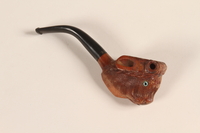
Bent pipe with a briar bison shaped bowl used by a Jewish soldier, 2nd Polish Corps
Object
Bent pipe with a carved briar wood buffalo shaped bowl made in Italy and used by Edward Herzbaum, a soldier in the 5th Krestowa, 2nd Polish Corps, British Army. Edward, age 19, left Łódź, Poland, shortly after Nazi Germany occupied the country in September 1939 for Soviet controlled Lvov. In June 1940, he was exiled to a gulag by Soviet security police. Germany invaded the Soviet Union in June 1941. Edward was released in an amnesty of Polish prisoners. He headed south to join the Polish Forces of the East, known as Anders Army. In August 1942, the unit left Soviet territory and became the 2nd Polish Corps. In February 1944, they joined the British 8th Army in Italy. The Corps fought its way north and was honored for its heroism in the Battle of Monte Cassino. They were in Italy on May 7, 1945, when the war ended. Edward learned that his mother died in Łódź Ghetto in 1943. He studied architecture in Rome until the British decided to allow Polish Corps veterans to immigrate to England in October 1946. He then served in the Polish Resettlement Corps for two years and completed his degree.
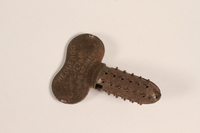
Terry's Hedgehog pipe reamer used by a Jewish soldier, 2nd Polish Corps
Object
Terry's Hedgehog metal pipe cleaner used by Edward Herzbaum, a soldier in the 5th Krestowa, 2nd Polish Corps, British Army. Edward, age 19, left Łódź, Poland, shortly after Nazi Germany occupied the country in September 1939 for Soviet controlled Lvov. In June 1940, he was exiled to a gulag by Soviet security police. Germany invaded the Soviet Union in June 1941. Edward was released in an amnesty of Polish prisoners. He headed south to join the Polish Forces of the East, known as Anders Army. In August 1942, the unit left Soviet territory and became the 2nd Polish Corps. In February 1944, they joined the British 8th Army in Italy. The Corps fought its way north and was honored for its heroism in the Battle of Monte Cassino. They were in Italy on May 7, 1945, when the war ended. Edward learned that his mother died in Łódź Ghetto in 1943. He studied architecture in Rome until the British decided to allow Polish Corps veterans to immigrate to England in October 1946. He then served in the Polish Resettlement Corps for two years and completed his degree.

Tan woolen pouch used by a Jewish soldier, 2nd Polish Corps
Object
Tan drawstring pouch used by Edward Herzbaum, a soldier in the 5th Krestowa, 2nd Polish Corps, British Army. Edward, age 19, left Łódź, Poland, shortly after Nazi Germany occupied the country in September 1939 for Soviet controlled Lvov. In June 1940, he was exiled to a gulag by Soviet security police. Germany invaded the Soviet Union in June 1941. Edward was released in an amnesty of Polish prisoners. He headed south to join the Polish Forces of the East, known as Anders Army. In August 1942, the unit left Soviet territory and became the 2nd Polish Corps. In February 1944, they joined the British 8th Army in Italy. The Corps fought its way north and was honored for its heroism in the Battle of Monte Cassino. They were in Italy on May 7, 1945, when the war ended. Edward learned that his mother died in Łódź Ghetto in 1943. He studied architecture in Rome until the British decided to allow Polish Corps veterans to immigrate to England in October 1946. He then served in the Polish Resettlement Corps for two years and completed his degree.
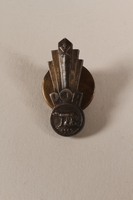
POA button cover with a Roman she-wolf owned by a Jewish soldier, 2nd Polish Corps
Object
POA lapel button cover with the Roman she-wolf, Romulus and Remus, and the year 1947 owned by Edward Herzbaum, who served as a soldier in the 2nd Polish Corps from 1942-1945. The source of the acronym is not known. In late 1946, Edward left Rome, where he was studying architecture at the University of Rome, for England. When Edward was 19, he left Łódź, Poland, shortly after Nazi Germany occupied the country in September 1939 for Soviet controlled Lvov. In June 1940, Edward was exiled to a gulag by Soviet security police. Germany invaded the Soviet Union in June 1941. Edward was released in an amnesty of Polish prisoners. He joined the Polish Army of the East, known as Anders Army. In August 1942, the unit left Soviet territory and became the 2nd Polish Corps, British Army. In February 1944, they joined the British 8th Army in Italy. The Corps fought its way north and was honored for heroism in the Battle of Monte Cassino. They celebrated VE Day, May 8, 1945, in Italy. Edward learned that his mother died in Łódź Ghetto in 1943. He studied architecture in Rome until the British decided to allow Polish Corps veterans to immigrate to England in October 1946. He then served in the Polish Resettlement Corps for two years, completed his degree, and eventually set up his own architecture firm.
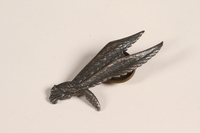
Polish paratrooper badge given to a Jewish soldier, 2nd Polish Corps
Object
Polish paratrooper diving eagle clutchback badge earned by Polish soldier Andrzej Służewski (later Andrew Sluzewski), and given to fellow 2nd Polish Corps soldier Edward Herzbaum (later Hartry) after World War II. Edward served as a soldier in the Polish Armed Forces, 5th Kresowa Infantry Division, 2nd Polish Corps, British Army, from 1942-1945, and Andrzej served as a specially trained paratrooper in the 3rd Carpathian Rifle Division, 2nd Polish Corps, British Army during World War II. When Edward was 19, he left Łódź, Poland, shortly after Nazi Germany occupied the country in September 1939 for Soviet controlled Lvov. In June 1940, Edward was exiled to a gulag by Soviet security police. Germany invaded the Soviet Union in June 1941. Edward was released in an amnesty of Polish prisoners. He joined the Polish Army of the East, known as Anders Army. In August 1942, the unit left Soviet territory and became the 2nd Polish Corps, British Army. In February 1944, they joined the British 8th Army in Italy. The Corps fought its way north and was honored for heroism in the Battle of Monte Cassino. They celebrated VE Day, May 8, 1945, in Italy. Edward learned that his mother died in Łódź Ghetto in 1943. He studied architecture in Rome until the British decided to allow Polish Corps veterans to immigrate to England in October 1946. He then served in the Polish Resettlement Corps for two years, completed his degree, and eventually set up his own architecture firm, where Andrew Sluzewski worked.

5th Kresowa Infantry bison shoulder patch worn by a Jewish soldier, 2nd Polish Corps
Object
Gold and brown bison shield shoulder patch issued to Edward Herzbaum, a soldier in the Polskie Siły Zbrojne, 5 Kresowa Dywizja Piechoty [Polish Armed Forces, 5th Kresowa Infantry Division], 2nd Polish Corps, British Army, from 1942-1945. When Edward was 19, he left Łódź, Poland, shortly after Nazi Germany occupied the country in September 1939 for Soviet controlled Lvov. In June 1940, Edward was exiled to a gulag by Soviet security police. Germany invaded the Soviet Union in June 1941. Edward was released in an amnesty of Polish prisoners. He joined the Polish Army of the East, known as Anders Army. In August 1942, the unit left Soviet territory and became the 2nd Polish Corps, British Army. In February 1944, they joined the British 8th Army in Italy. The Corps fought its way north and was honored for heroism in the Battle of Monte Cassino. They celebrated VE Day, May 8, 1945, in Italy. Edward learned that his mother died in Łódź Ghetto in 1943. He studied architecture in Rome until the British decided to allow Polish Corps veterans to immigrate to England in October 1946. He then served in the Polish Resettlement Corps for two years, completed his degree, and eventually set up his own architecture firm.

5th Kresowa Infantry bison shoulder patch worn by a Jewish soldier, 2nd Polish Corps
Object
Gold and brown bison shield shoulder patch issued to Edward Herzbaum, a soldier in the Polskie Siły Zbrojne, 5 Kresowa Dywizja Piechoty [Polish Armed Forces, 5th Kresowa Infantry Division], 2nd Polish Corps, British Army, from 1942-1945. When Edward was 19, he left Łódź, Poland, shortly after Nazi Germany occupied the country in September 1939 for Soviet controlled Lvov. In June 1940, Edward was exiled to a gulag by Soviet security police. Germany invaded the Soviet Union in June 1941. Edward was released in an amnesty of Polish prisoners. He joined the Polish Army of the East, known as Anders Army. In August 1942, the unit left Soviet territory and became the 2nd Polish Corps, British Army. In February 1944, they joined the British 8th Army in Italy. The Corps fought its way north and was honored for heroism in the Battle of Monte Cassino. They celebrated VE Day, May 8, 1945, in Italy. Edward learned that his mother died in Łódź Ghetto in 1943. He studied architecture in Rome until the British decided to allow Polish Corps veterans to immigrate to England in October 1946. He then served in the Polish Resettlement Corps for two years, completed his degree, and eventually set up his own architecture firm.
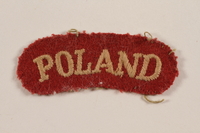
Poland military patch worn by a Jewish soldier, 2nd Polish Corps
Object
Poland military uniform patch issued to Edward Herzbaum, a soldier in the Polskie Siły Zbrojne, 5 Kresowa Dywizja Piechoty [Polish Armed Forces, 5th Kresowa Infantry Division], 2nd Polish Corps, British Army, from 1942-1945. When Edward was 19, he left Łódź, Poland, shortly after Nazi Germany occupied the country in September 1939 for Soviet controlled Lvov. In June 1940, Edward was exiled to a gulag by Soviet security police. Germany invaded the Soviet Union in June 1941. Edward was released in an amnesty of Polish prisoners. He joined the Polish Army of the East, known as Anders Army. In August 1942, the unit left Soviet territory and became the 2nd Polish Corps, British Army. In February 1944, they joined the British 8th Army in Italy. The Corps fought its way north and was honored for heroism in the Battle of Monte Cassino. They celebrated VE Day, May 8, 1945, in Italy. Edward learned that his mother died in Łódź Ghetto in 1943. He studied architecture in Rome until the British decided to allow Polish Corps veterans to immigrate to England in October 1946. He then served in the Polish Resettlement Corps for two years, completed his degree, and eventually set up his own architecture firm.

Poland military patch worn by a Jewish soldier, 2nd Polish Corps
Object
Poland military uniform patch issued to Edward Herzbaum, a soldier in the Polskie Siły Zbrojne, 5 Kresowa Dywizja Piechoty [Polish Armed Forces, 5th Kresowa Infantry Division], 2nd Polish Corps, British Army, from 1942-1945. When Edward was 19, he left Łódź, Poland, shortly after Nazi Germany occupied the country in September 1939 for Soviet controlled Lvov. In June 1940, Edward was exiled to a gulag by Soviet security police. Germany invaded the Soviet Union in June 1941. Edward was released in an amnesty of Polish prisoners. He joined the Polish Army of the East, known as Anders Army. In August 1942, the unit left Soviet territory and became the 2nd Polish Corps, British Army. In February 1944, they joined the British 8th Army in Italy. The Corps fought its way north and was honored for heroism in the Battle of Monte Cassino. They celebrated VE Day, May 8, 1945, in Italy. Edward learned that his mother died in Łódź Ghetto in 1943. He studied architecture in Rome until the British decided to allow Polish Corps veterans to immigrate to England in October 1946. He then served in the Polish Resettlement Corps for two years, completed his degree, and eventually set up his own architecture firm.
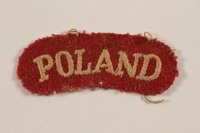
Poland military patch worn by a Jewish soldier, 2nd Polish Corps
Object
Poland military uniform patch issued to Edward Herzbaum, a soldier in the Polskie Siły Zbrojne, 5 Kresowa Dywizja Piechoty [Polish Armed Forces, 5th Kresowa Infantry Division], 2nd Polish Corps, British Army, from 1942-1945. When Edward was 19, he left Łódź, Poland, shortly after Nazi Germany occupied the country in September 1939 for Soviet controlled Lvov. In June 1940, Edward was exiled to a gulag by Soviet security police. Germany invaded the Soviet Union in June 1941. Edward was released in an amnesty of Polish prisoners. He joined the Polish Army of the East, known as Anders Army. In August 1942, the unit left Soviet territory and became the 2nd Polish Corps, British Army. In February 1944, they joined the British 8th Army in Italy. The Corps fought its way north and was honored for heroism in the Battle of Monte Cassino. They celebrated VE Day, May 8, 1945, in Italy. Edward learned that his mother died in Łódź Ghetto in 1943. He studied architecture in Rome until the British decided to allow Polish Corps veterans to immigrate to England in October 1946. He then served in the Polish Resettlement Corps for two years, completed his degree, and eventually set up his own architecture firm.
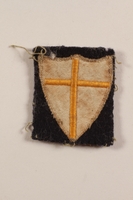
British 8th Army sleeve badge worn by a Jewish soldier, 2nd Polish Corps
Object
British 8th Army gold cross shield shoulder sleeve badge awarded to Edward Herzbaum, an honorary distinction for his participation in the Battle for Monte Cassino, January - May 1944. The design originated as the emblem of Operation Crusader in North Africa. The 2nd Polish Corps led the mountain assault in the May 1944 victory, the fourth battle waged by Allied forces to break through German defenses. Edward was a soldier in the 5th Kresowa Infantry Division, 2nd Polish Corps, attached to the British 8th Army during the Italian campaign, 1944-1945. When Edward was 19, he left Łódź, Poland, shortly after Nazi Germany occupied the country in September 1939 for Soviet controlled Lvov. In June 1940, Edward was exiled to a forced labor camp by Soviet security police. Germany invaded the Soviet Union in June 1941. Edward was released in an amnesty granted to Polish prisoners to fight the Germans. He joined the Polish Army of the East, known as Anders Army. In August 1942, the unit left Soviet territory and became the 2nd Polish Corps. In February 1944, they joined the British 8th Army in Italy. The Corps fought its way north and was honored for heroism at Monte Cassino. They celebrated VE Day, May 8, 1945, in Italy. Edward learned that his mother died in Łódź Ghetto in 1943. He studied architecture in Rome until the British decided to allow Polish Corps veterans to immigrate to England in October 1946. He then served in the Polish Resettlement Corps for two years, completed his degree, and set up his own architecture firm.
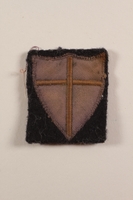
British 8th Army sleeve badge worn by a Jewish soldier, 2nd Polish Corps
Object
British 8th Army gold cross shield shoulder sleeve badge awarded to Edward Herzbaum, an honorary distinction for his participation in the Battle for Monte Cassino, January - May 1944. The design originated as the emblem of Operation Crusader in North Africa. The 2nd Polish Corps led the mountain assault in the May 1944 victory, the fourth battle waged by Allied forces to break through German defenses. Edward was a soldier in the 5th Kresowa Infantry Division, 2nd Polish Corps, attached to the British 8th Army during the Italian campaign, 1944-1945. When Edward was 19, he left Łódź, Poland, shortly after Nazi Germany occupied the country in September 1939 for Soviet controlled Lvov. In June 1940, Edward was exiled to a forced labor camp by Soviet security police. Germany invaded the Soviet Union in June 1941. Edward was released in an amnesty granted to Polish prisoners to fight the Germans. He joined the Polish Army of the East, known as Anders Army. In August 1942, the unit left Soviet territory and became the 2nd Polish Corps. In February 1944, they joined the British 8th Army in Italy. The Corps fought its way north and was honored for heroism at Monte Cassino. They celebrated VE Day, May 8, 1945, in Italy. Edward learned that his mother died in Łódź Ghetto in 1943. He studied architecture in Rome until the British decided to allow Polish Corps veterans to immigrate to England in October 1946. He then served in the Polish Resettlement Corps for two years, completed his degree, and set up his own architecture firm.
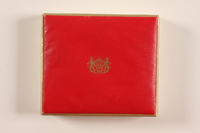
Red gift box owned by a Jewish soldier, 2nd Polish Corps
Object
Red cardboard gift box owned by Edward Herzbaum, a soldier in the Polskie Siły Zbrojne, 5 Kresowa Dywizja Piechoty, [Polish Armed Forces, 5th Kresowa Infantry Division], 2nd Polish Corps, British Army, from 1942-1945. When Edward was 19, he left Łódź, Poland, shortly after Nazi Germany occupied the country in September 1939 for Soviet controlled Lvov. In June 1940, Edward was exiled to a forced labor camp by Soviet security police. Germany invaded the Soviet Union in June 1941. Edward was released in an amnesty of Polish prisoners and joined the Polish Army of the East, known as Anders Army. In August 1942, the unit left Soviet territory and became the 2nd Polish Corps. In February 1944, they joined the British 8th Army in Italy. The Corps fought its way north and was honored for heroism in the Battle of Monte Cassino. They celebrated VE Day, May 8, 1945, in Italy. Edward learned that his mother died in Łódź Ghetto in 1943. He studied architecture in Rome until the British decided to allow Polish Corps veterans to immigrate to England in October 1946. He then served in the Polish Resettlement Corps for two years, completed his degree, and set up his own architecture firm.

War Medal 1939-1945, ribbon and box awarded to a Jewish soldier, 2nd Polish Corps
Object
British issued War Medal 1939-1945 with striped ribbon and box of issue awarded to Edward Herzbaum for his service in World War II. Edward was a soldier in the 5th Krestowa Infantry, 2nd Polish Corps, British Army from 1942-1945, and in combat with the British 8th Army in Italy from February 1944-May 7, 1945. The medal was received by his daughter in 1990 on his behalf. Many Polish soldiers refused their British medals as a protest against the government for excluding them from the Victory Parade of 1946 due to pressure from Stalin. Edward, 19, left Łódź, Poland, shortly after Nazi Germany occupied the country in September 1939 for Soviet controlled Lvov. In June 1940, he was exiled to a forced labor camp by Soviet security police. Germany invaded the Soviet Union in June 1941. Edward was released in an amnesty of Polish prisoners. He joined Anders Army, a Polish voluntary military unit. In August 1942, the unit left Soviet territory and became the 2nd Polish Corps. In February 1944, they joined the 8th British Army in Italy. The Corps fought its way north and was honored for heroism in the Battle of Monte Cassino. They were in Italy on VE Day, May 8, 1945. Edward learned that his mother died in Łódź Ghetto in 1943. He studied architecture in Rome until the British decided to allow Polish Corps veterans to immigrate to England in October 1946. He then served in the Polish Resettlement Corps for two years, completed his degree, and set up his own architecture firm.

Italy Star 1943-1945 medal, ribbon, and box awarded to a Jewish soldier, 2nd Polish Corps
Object
British issued Italy Star (1943-1945) with striped ribbon and box of issue awarded to Edward Herzbaum for honor and gallantry during his service in the Allied campaign in Italy. Edward was a soldier in the 5th Krestowa Infantry, 2nd Polish Corps, British Army from 1942-1945, and in combat with the British 8th Army in Italy from February 1944-May 8, 1945. The medal was received by his daughter in 1990 on his behalf. Many Polish soldiers refused their British medals as a protest against the government for excluding them from the Victory Parade of 1946 due to pressure from Stalin. Edward, 19, left Łódź, Poland, shortly after Nazi Germany occupied the country in September 1939 for Soviet controlled Lvov. In June 1940, he was exiled to a forced labor camp by Soviet security police. Germany invaded the Soviet Union in June 1941. Edward was released in an amnesty of Polish prisoners. He joined Anders Army, a Polish voluntary military unit. In August 1942, the unit left Soviet territory and became the 2nd Polish Corps, British Army. In February 1944, they joined the 8th British Army in Italy. The Corps fought its way north and was honored for heroism in the Battle of Monte Cassino. They were in Italy on VE Day, May 8, 1945. Edward learned that his mother had died in Łódź Ghetto in 1943. He studied architecture in Rome until the British decided to allow Polish Corps veterans to immigrate to England in October 1946. He then served in the Polish Resettlement Corps for two years, completed his degree, and set up his own architecture firm.

1939-1945 Star medal, ribbon and box awarded to a Jewish soldier, 2nd Polish Corps
Object
British issued 1939-1945 Star Medal with striped ribbon and box of issue awarded to Edward Herzbaum for his service in the 2nd Polish Corps, British Army, during World War II. Edward was a soldier in the 5th Kresowa Infantry Division, 2nd Polish Corps, British Army from 1942-1945, and in combat with the British 8th Army in Italy from February 1944-May 8, 1945. The medal was received by his daughter in 1990 on his behalf. Many Polish soldiers refused their British medals as a protest against the government for excluding them from the Victory Parade of 1946 due to pressure from Stalin. Edward, age 19, left Łódź, Poland, shortly after Nazi Germany occupied the country in September 1939 for Soviet controlled Lvov. In June 1940, he was exiled to a forced labor camp by Soviet security police. Germany invaded the Soviet Union in June 1941. Edward was released in an amnesty of Polish prisoners. He joined Anders Army, a Polish voluntary military unit. In August 1942, the unit left Soviet territory and became the 2nd Polish Corps, British Army. In February 1944, they joined the 8th British Army in Italy. The Corps fought its way north and was honored for heroism in the Battle of Monte Cassino. They were in Italy on VE Day, May 8, 1945. Edward learned that his mother had died in Łódź Ghetto in 1943. He studied architecture in Rome until the British decided to allow Polish Corps veterans to immigrate to England in October 1946. He then served in the Polish Resettlement Corps for two years, completed his degree, and set up his own architecture firm.
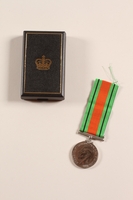
Defence Medal 1939-1945, ribbon and box awarded to Jewish soldier, 2nd Polish Corps
Object
British issued Defence Medal (1939-1945) with striped ribbon and box of issue awarded to Edward Herzbaum for his service in the 2nd Polish Corps, British Army, during World War II. Edward was a soldier in the 5th Kresowa Infantry Division, 2nd Polish Corps from 1942-1945, and in combat with the British 8th Army in Italy from February 1944-May 8, 1945. The medal was received by his daughter in 1990 on his behalf. Many Polish soldiers refused their British medals as a protest against the government for excluding them from the Victory Parade of 1946 due to pressure from Stalin. Edward, age 19, left Łódź, Poland, shortly after Nazi Germany occupied the country in September 1939 for Soviet controlled Lvov. In June 1940, he was exiled to a forced labor camp by Soviet security police. Germany invaded the Soviet Union in June 1941. Edward was released in an amnesty of Polish prisoners. He joined the Polish Army of the East, known as Anders Army. In August 1942, the unit left Soviet territory and became the 2nd Polish Corps. In February 1944, they joined the 8th British Army in Italy. The Corps fought its way north and was honored for its heroism in the Battle of Monte Cassino. They were in Italy on VE Day, May 8, 1945. Edward learned that his mother died in Łódź Ghetto in 1943. He studied architecture in Rome until the British decided to allow Polish Corps veterans to immigrate to England in October 1946. He then served in the Polish Resettlement Corps for two years, completed his degree, and set up his own architecture firm.
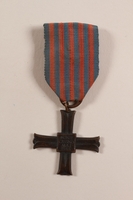
Monte Cassino Commemorative Cross awarded to a Jewish soldier, 2nd Polish Corps
Object
Monte Cassino Commemorative Cross [Krzyż Pamiątkowy Monte Cassino] awarded to Edward Herzbaum, a soldier in the 2nd Polish Corps, for participation in the Battle of Monte Cassino, as well as Piedimonte and Passo Corno in Italy. The 2nd Polish Corps led the mountain assault in the May 1944 victory, the fourth battle waged by Allied forces since January 1944 to break through German defenses. Edward, age 19, had left Łódź, Poland, shortly after Germany occupied the country in September 1939 to stay with family in Soviet controlled Lvov. In June 1940, he was arrested by Soviet security police and exiled to a forced labor camp. Germany invaded the Soviet Union in June 1941. Edward was released due to an amnesty granted to Polish prioners. He went south to join the Polish Army of the East, formed by General Anders per agreement with Stalin. In August 1942, the unit left Soviet territory and became the 2nd Polish Corps of the British Army. In February 1944, they deployed to join the 8th British Army in the Italian Campaign. The Corps fought its way north and was honored for its heroism in the Battle of Monte Cassino. They were in Italy on VE Day, May 8, 1945 when the war ended. Edward learned that his mother had died in the Łódź Ghetto in 1943. He studied architecture in Rome until the British decided to allow Polish Corps veterans to immigrate to England in October 1946. He then served in the Polish Resettlement Corps for two years and completed his degree.

Virtuti Militari - Wound Badge ribbon with star awarded to a Jewish soldier, 2nd Polish Corps
Object
Virtuti Militari black and blue ribbon bar, or undress ribbon, with one star awarded to Edward Herzbaum, a soldier in the 5th Kresowa Infantry Division, 2nd Polish Corps, British Army, from 1942-1945. The single star recognizes that the awardee was wounded once in combat. When Edward was 19, he left Łódź, Poland, shortly after Nazi Germany occupied the country in September 1939 for Soviet controlled Lvov. In June 1940, Edward was exiled to a gulag by Soviet security police. Germany invaded the Soviet Union in June 1941. Edward was released in an amnesty of Polish prisoners to fight the Germans. He joined the Polish Army of the East, known as Anders Army. In August 1942, the unit left Soviet territory and became the 2nd Polish Corps. In February 1944, they joined the British 8th Army in Italy. The Corps fought its way north and was honored for heroism in the Battle of Monte Cassino. They celebrated VE Day, May 8, 1945, in Italy. Edward learned that his mother died in Łódź Ghetto in 1943. He studied architecture in Rome until the British decided to allow Polish Corps veterans to immigrate to England in October 1946. He then served in the Polish Resettlement Corps for two years, completed his degree, and set up his own architecture firm.
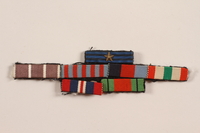
Riband bar with seven ribbons awarded to a Jewish soldier, 2nd Polish Corps
Object
Riband bar, also known as an undress ribbon, with ribbon colors for seven medals awarded by the British and Polish governments to Edward Herzbaum, a soldier in the 5th Kresowa Infantry Division, 2nd Polish Corps, British Army, from 1942-1945. He was in combat with the British 8th Army in Italy from February 1944-May 8, 1945, and awarded for heroism. When Edward was 19, he left Łódź, Poland, shortly after Nazi Germany occupied the country in September 1939 for Soviet controlled Lvov. In June 1940, Edward was exiled to a gulag by Soviet security police. Germany invaded the Soviet Union in June 1941. Edward was released in an amnesty of Polish prisoners to fight the Germans. He joined the Polish Army of the East, known as Anders Army. In August 1942, the unit left Soviet territory and became the 2nd Polish Corps. In February 1944, they joined the British 8th Army in Italy. The Corps fought its way north and was honored for heroism in the Battle of Monte Cassino. They celebrated VE Day, May 8, 1945, in Italy. Edward learned that his mother died in Łódź Ghetto in 1943. He studied architecture in Rome until the British decided to allow Polish Corps veterans to immigrate to England in October 1946. He then served in the Polish Resettlement Corps for two years, completed his degree, and set up his own architecture firm.
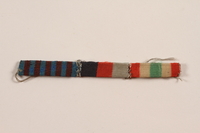
Riband bar with three ribbons awarded to a Jewish soldier, 2nd Polish Corps
Object
Riband bar, or undress ribbon, with sections of ribbon for three medals awarded by the British to Edward Herzbaum, a soldier in the 5th Kresowa Infantry Division, 2nd Polish Corps, British Army, from 1942-1945. He was in combat with the British 8th Army in Italy from February 1944-May 8, 1945, and awarded for heroism. When Edward was 19, he left Łódź, Poland, shortly after Nazi Germany occupied the country in September 1939 for Soviet controlled Lvov. In June 1940, Edward was exiled to a gulag by Soviet security police. Germany invaded the Soviet Union in June 1941. Edward was released in an amnesty of Polish prisoners to fight the Germans. He joined the Polish Army of the East, known as Anders Army. In August 1942, the unit left Soviet territory and became the 2nd Polish Corps. In February 1944, they joined the British 8th Army in Italy. The Corps fought its way north and was honored for heroism in the Battle of Monte Cassino. They celebrated VE Day, May 8, 1945, in Italy. Edward learned that his mother died in Łódź Ghetto in 1943. He studied architecture in Rome until the British decided to allow Polish Corps veterans to immigrate to England in October 1946. He then served in the Polish Resettlement Corps for two years, completed his degree, and set up his own architecture firm.
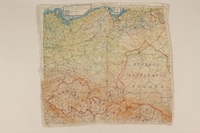
2-sided silk escape map of Central/ East Europe owned by Jewish soldier, 2nd Polish Corps
Object
Topographical silk escape map of Germany with September 1943 borders owned by Edward Herzbaum, a soldier in the 5th Kresowa Infantry Division, 2nd Polish Corps, British Army, from 1942-1945. The front details the region between northern Italy and Germany; the reverse continues to Germany, including Poland, which is marked as German territory. Escape and evasion maps were issued to help troops find their way to safety if caught behind enemy lines. Silk maps were easy to conceal, could withstand wet weather and wear, and made no noise in use. Edward, age 19, left Łódź, Poland, after Germany invaded in September 1939 for Soviet controlled Lvov. In June 1940, he was exiled to a gulag by Soviet secret police. After Germany invaded the Soviet Union in June 1941, he was released in an amnesty of Polish prisoners. He joined join Anders Army, a volunteer Polish military unit. In August 1942, the unit left Soviet territory and became the 2nd Polish Corps, British Army. In February 1944, they joined the 8th British Army in Italy. The Corps fought its way north and was honored for heroism in the Battle of Monte Cassino. They were in Italy on VE Day, May 8, 1945, when the war ended. Edward learned that his mother died in Łódź Ghetto in 1943. He studied architecture in Rome until the British decided to allow Polish Corps veterans to immigrate to England in October 1946. He then served in the Polish Resettlement Corps for two years and completed his degree.
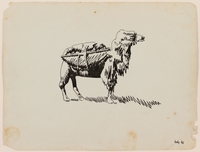
Drawing of a shaggy camel with pack created by a Jewish soldier, 2nd Polish Corps
Object
Black ink drawing of a camel created by 22 year old Edward Herzbaum in Kyrgyzstan in February 1942. It was one of the first works he drew following his release from a Soviet labor camp and his voluntary enlistment in the Polish Armed Forces of the East, later the 2nd Polish Corps. Edward, age 19, left Łódź, Poland, shortly after Nazi Germany occupied the country in September 1939 to stay with family in Soviet controlled Lvov. In June 1940, he was arrested by Soviet security police and exiled to a forced labor camp. Germany invaded the Soviet Union in June 1941. Edward was released as part of an amnesty granted to Polish prisoners. He headed south to join the new voluntary army, known as Anders Army. In August 1942, the unit left Soviet territory and became the 2nd Polish Corps, British Army. In February 1944, they deployed to join the 8th British Army in the Italian Campaign. The Corps fought its way north and was honored for heroism in the 1944 Battle of Monte Cassino. They were in Italy on VE Day, May 8, 1945, when the war ended. Edward learned that his mother had died in the Łódź Ghetto in 1943. He studied architecture in Rome until the British decided to allow Polish Corps veterans to immigrate to England in October 1946. He then served in the Polish Resettlement Corps for two years and completed his degree.
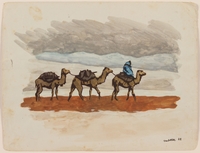
Watercolor of 3 camels with packs and rider created by a Jewish soldier, 2nd Polish Corps
Object
Watercolor of three packed camels with a cloaked rider created by 22 year old Edward Herzbaum in March 1942. Edward had recently joined the Polish Armed Forces of the East, later the 2nd Polish Corps, now in Kyrgyzstan, following his release from a Soviet labor camp. Edward, age 19, left Łódź, Poland, shortly after Nazi Germany occupied the country in September 1939 to stay with family in Soviet controlled Lvov. In June 1940, he was arrested by Soviet security police and exiled to a forced labor camp. Germany invaded the Soviet Union in June 1941. Edward was released as part of an amnesty granted to Polish prisoners. He headed south to join the new voluntary army, known as Anders Army. In August 1942, the unit left Soviet territory and became the 2nd Polish Corps, British Army. In February 1944, they deployed to join the 8th British Army in the Italian Campaign. The Corps fought its way north and was honored for heroism in the 1944 Battle of Monte Cassino. They were in Italy on VE Day, May 8, 1945, when the war ended. Edward learned that his mother had died in the Łódź Ghetto in 1943. He studied architecture in Rome until the British decided to allow Polish Corps veterans to immigrate to England in October 1946. He then served in the Polish Resettlement Corps for two years and completed his degree.

Watercolor of snowy mountains created by a Jewish soldier, 2nd Polish Corps
Object
Watercolor study of snow capped mountains created by 22 year old Edward Herzbaum in late May 1942 in Dzhalalabad, Soviet Union, (now Jalal-Abad (Kyrgyzstan)]. Edward was with the Polish Armed Forces of the East, later the 2nd Polish Corps, traveling south toward British territory in Iraq. Edward, age 19, left Łódź, Poland, shortly after Nazi Germany occupied the country in September 1939 to stay with family in Soviet controlled Lvov. In June 1940, Edward was arrested by Soviet security police and exiled to a forced labor camp. Germany invaded the Soviet Union in June 1941. Edward was released as part of an amnesty granted to Polish forced laborers. He headed south to join the voluntary Polish Army of the East, newly formed and known as Anders Army. In August 1942, the unit left Soviet territory and became the 2nd Polish Corps, British Army. In February 1944, they deployed to join the 8th British Army in the Italian Campaign. The Corps fought its way north and was honored for heroism in the 1944 Battle of Monte Cassino. They were in Italy on May 7, 1945, when the war ended. Edward learned that his mother had died in the Łódź Ghetto in 1943. He studied architecture in Rome until the British decided to allow Polish Corps veterans to immigrate to England in October 1946. He then served in the Polish Resettlement Corps for two years and completed his degree.

Watercolor of a wooded grove created by a Jewish soldier, 2nd Polish Corps
Object
Abstract watercolor of a distant woods, mountains, and sky created by 22 year old Edward Herzbaum in late May 1942 in Blagoveshchenskoye, Soviet Union, (now Blagoveshenka, Kyrgyzstan]. Edward was with the Polish Armed Forces of the East, later the 2nd Polish Corps, traveling south toward British territory in Iraq. Edward, age 19, left Łódź, Poland, shortly after Nazi Germany occupied the country in September 1939 to stay with family in Soviet controlled Lvov. In June 1940, Edward was arrested by Soviet security police and exiled to a forced labor camp. Germany invaded the Soviet Union in June 1941. Edward was released as part of an amnesty granted to Polish forced laborers. He headed south to join the voluntary Polish Army of the East, newly formed and known as Anders Army. In August 1942, the unit left Soviet territory and became the 2nd Polish Corps, British Army. In February 1944, they deployed to join the 8th British Army in the Italian Campaign. The Corps fought its way north and was honored for heroism in the 1944 Battle of Monte Cassino. They were in Italy on May 7, 1945, when the war ended. Edward learned that his mother had died in the Łódź Ghetto in 1943. He studied architecture in Rome until the British decided to allow Polish Corps veterans to immigrate to England in October 1946. He then served in the Polish Resettlement Corps for two years and completed his degree.
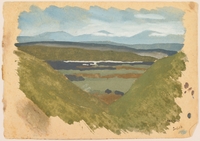
Watercolor of a green valley near mountain lookout created by a Jewish soldier, 2nd Polish Corps
Object
Watercolor of a distant green valley viewed between two mountains created by 22 year old Edward Herzbaum in late May 1942 in Susok Dzhalalabad Blagoveshchenskoye, Soviet Union, (now Blagoveshenka, Kyrgyzstan]. When assigned to lookout duty, he would climb very high up in the mountains enjoy this view. Edward was with the Polish Armed Forces of the East, later the 2nd Polish Corps, traveling south toward British territory in Iraq. Edward, age 19, left Łódź, Poland, shortly after Nazi Germany occupied the country in September 1939 to stay with family in Soviet controlled Lvov. In June 1940, Edward was arrested by Soviet security police and exiled to a forced labor camp. Germany invaded the Soviet Union in June 1941. Edward was released as part of an amnesty granted to Polish prisoners. He headed south to join the voluntary Polish Army of the East, newly formed and known as Anders Army. In August 1942, the unit left Soviet territory and became the 2nd Polish Corps, British Army. In February 1944, they deployed to join the 8th British Army in the Italian Campaign. The Corps fought its way north and was honored for heroism in the 1944 Battle of Monte Cassino. They were in Italy on May 7, 1945, when the war ended. Edward learned that his mother had died in the Łódź Ghetto in 1943. He studied architecture in Rome until the British decided to allow Polish Corps veterans to immigrate to England in October 1946. He then served in the Polish Resettlement Corps for two years and completed his degree.
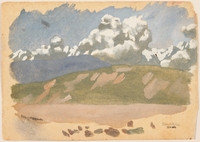
Watercolor of puffy clouds over distant mountains by a Jewish soldier, 2nd Polish Corps
Object
Watercolor sketch of dense gray-white clouds towering over a mountain range painted by 22 year old Edward Herzbaum in late May 1942 in Blagoveshchenskoye, Soviet Union, (now Blagoveshenka (Kyrgyzstan.] Edward was with the Polish Armed Forces of the East, later the 2nd Polish Corps, traveling south toward British territory in Iraq. Edward was with the Polish Armed Forces of the East, later the 2nd Polish Corps, traveling south toward British territory in Iraq. Edward, age 19, left Łódź, Poland, shortly after Nazi Germany occupied the country in September 1939 to stay with family in Soviet controlled Lvov. In June 1940, Edward was arrested by Soviet security police and exiled to a forced labor camp. Germany invaded the Soviet Union in June 1941. Edward was released as part of an amnesty granted to Polish prisoners. He headed south to join the voluntary Polish Army of the East, newly formed and known as Anders Army. In August 1942, the unit left Soviet territory and became the 2nd Polish Corps, British Army. In February 1944, they deployed to join the 8th British Army in the Italian Campaign. The Corps fought its way north and was honored for heroism in the 1944 Battle of Monte Cassino. They were in Italy on May 7, 1945, when the war ended. Edward learned that his mother had died in the Łódź Ghetto in 1943. He studied architecture in Rome until the British decided to allow Polish Corps veterans to immigrate to England in October 1946. He then served in the Polish Resettlement Corps for two years and completed his degree.
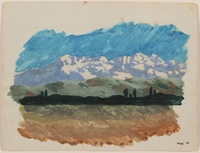
Watercolor of gold and green fields leading to snow-covered mountains created by a Jewish soldier, 2nd Polish Corps
Object
Watercolor painting of gray/white clouds towering over a mountain range painted by 22 year old Edward Herzbaum in May 1942 in Blagoveshchenskoye, Soviet Union, (now Blagoveshenka (Kyrgyzstan.] Edward was with the Polish Armed Forces of the East, later the 2nd Polish Corps, traveling south toward British territory in Iraq. Edward, age 19, left Łódź, Poland, shortly after Nazi Germany occupied the country in September 1939 to stay with family in Soviet controlled Lvov. In June 1940, Edward was arrested by Soviet security police and exiled to a forced labor camp. Germany invaded the Soviet Union in June 1941. Edward was released as part of an amnesty granted to Polish forced laborers. He headed south to join the newly formed voluntary Polish Army of the East, known as Anders Army. In August 1942, the unit left Soviet territory and became the 2nd Polish Corps, British Army. In February 1944, they deployed to join the 8th British Army in the Italian Campaign. The Corps fought its way north and was honored for heroism in the 1944 Battle of Monte Cassino. They were in Italy on May 7, 1945, when the war ended. Edward learned that his mother had died in the Łódź Ghetto in 1943. He studied architecture in Rome until the British decided to allow Polish Corps veterans to immigrate to England in October 1946. He then served in the Polish Resettlement Corps for two years and completed his degree.
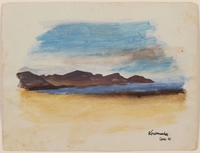
Watercolor of mountains and a shoreline painted by a Jewish soldier, 2nd Polish Corps
Object
Watercolor study of dark brown mountains along the Caspian Sea created by 22 year old Edward Herzbaum in July 1942 in Krasnovodsk, Soviet Union, (now Turkmenbashy, Turkmenistan]. Edward was with the Polish Armed Forces of the East, later the 2nd Polish Corps, traveling south toward British territory in Iraq. Edward, 19, left Łódź, Poland, shortly after Nazi Germany occupied the country in September 1939 to stay with family in Soviet controlled Lvov. In June 1940, Edward was arrested by Soviet security police and exiled to a forced labor camp. Germany invaded the Soviet Union in June 1941. Edward was released as part of an amnesty granted to Polish prisoners. He headed south to join the Polish Army of the East, a newly formed volunteer Polish force known as Anders Army. In August 1942, the unit left Soviet territory and became the 2nd Polish Corps in the British Army. In February 1944, they deployed to join the 8th British Army in the Italian Campaign. The Corps fought its way north and was honored for heroism in the 1944 Battle of Monte Cassino. They were in Italy on May 7, 1945, when the war ended. Edward learned that his mother had died in the Łódź Ghetto in 1943. He studied architecture in Rome until the British decided to allow Polish Corps veterans to immigrate to England in October 1946. He then served in the Polish Resettlement Corps for two years and completed his degree.

Watercolor of purple hued mountains and colored landscape by a Jewish soldier, 2nd Polish Corps
Object
Vividly colored watercolor of purplish mountains viewed across tree lined fields painted by 22 year old Edward Herzbaum in August 1942 in Khanaqin, Iraq. The style is similar to 2012.471.32, painted in May, suggesting a view of the same mountains from different sides of the border. Edward had traveled south with the Polish Armed Forces of the East, later the 2nd Polish Corps, from the Soviet Union to British territory in Iraq. Edward, 19, left Łódź, Poland, shortly after Nazi Germany occupied the country in September 1939 to stay with family in Soviet controlled Lvov. In June 1940, Edward was arrested by Soviet security police and exiled to a forced labor camp. Germany invaded the Soviet Union in June 1941. Edward was released as part of an amnesty granted to Polish prisoners. He joined the Polish Army of the East, a newly formed volunteer Polish force known as Anders Army. In August 1942, the unit left Soviet territory and became the 2nd Polish Corps in the British Army. In February 1944, they deployed to join the 8th British Army in the Italian Campaign. The Corps fought its way north and was honored for heroism in the 1944 Battle of Monte Cassino. They were in Italy on May 7, 1945, when the war ended. Edward learned that his mother had died in the Łódź Ghetto in 1943. He studied architecture in Rome until the British decided to allow Polish Corps veterans to immigrate to England in October 1946. He then served in the Polish Resettlement Corps for two years and completed his degree.

Watercolor of receding green mountains under a blue sky by a Jewish soldier, 2nd Polish Corps
Object
Watercolor of three dark green mountain ranges against a light blue sky painted by 22 year old Edward Herzbaum in August 1942 in Khanaqin, Iraq. Edward had traveled south with the Polish Armed Forces of the East, later the 2nd Polish Corps, from the Soviet Union to British territory in Iraq. Edward, 19, left Łódź, Poland, shortly after Nazi Germany occupied the country in September 1939 to stay with family in Soviet controlled Lvov. In June 1940, Edward was arrested by Soviet security police and exiled to a forced labor camp. Germany invaded the Soviet Union in June 1941. Edward was released as part of an amnesty granted to Polish prisoners. He joined the Polish Army of the East, a newly formed volunteer Polish force known as Anders Army. In August 1942, the unit left Soviet territory and became the 2nd Polish Corps in the British Army. In February 1944, they deployed to join the 8th British Army in the Italian Campaign. The Corps fought its way north and was honored for heroism in the 1944 Battle of Monte Cassino. They were in Italy on May 7, 1945, when the war ended. Edward learned that his mother had died in the Łódź Ghetto in 1943. He studied architecture in Rome until the British decided to allow Polish Corps veterans to immigrate to England in October 1946. He then served in the Polish Resettlement Corps for two years and completed his degree.
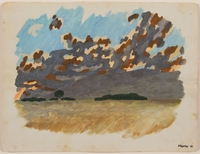
Watercolor of a yellow field leading to blue and gray mountains created by a young Jewish soldier, 2nd Polish Corps
Object
Watercolor sketch of a fields and mountains beneath an abstract sky painted by 22 year old Edward Herzbaum in August 1942 in Khanaqin, Iraq. Edward had traveled south with the Polish Armed Forces of the East, soon to be the 2nd Polish Corps, from the Soviet Union to British territory in Iraq. They met British forces at the large base and field hospital near this Iraqi border town where many died after the long, arduous march from Russia. There were oil fields near the city and it was also along a major Muslim pilgrimage route. Edward, 19, left Łódź, Poland, shortly after Nazi Germany occupied the country in September 1939 to stay with family in Soviet controlled Lvov. In June 1940, Edward was arrested by Soviet security police and exiled to a forced labor camp. Germany invaded the Soviet Union in June 1941. Edward was released as part of an amnesty granted to Polish prisoners. He joined the Polish Army of the East, a newly formed volunteer Polish force known as Anders Army. In August 1942, the unit left Soviet territory and became the 2nd Polish Corps in the British Army. In February 1944, they deployed to join the 8th British Army in the Italian Campaign. The Corps fought its way north and was honored for heroism in the 1944 Battle of Monte Cassino. They were in Italy on May 7, 1945, when the war ended. Edward learned that his mother had died in the Łódź Ghetto in 1943. He studied architecture in Rome until the British decided to allow Polish Corps veterans to immigrate to England in October 1946. He then served in the Polish Resettlement Corps for two years and completed his degree.

Watercolor of purple and white mountains under a blue sky by a Jewish soldier, 2nd Polish Corps
Object
Watercolor study of snow capped mountains created by 21 year old Edward Herzbaum in June 1942 in Blagoveshchenskoye, Soviet Union, (now Blagoveshenka (Kyrgyzstan]. Edward was with the Polish Armed Forces of the East, later the 2nd Polish Corps, traveling south toward British territory in Iraq. Edward, 19, left Łódź, Poland, shortly after Nazi Germany occupied the country in September 1939 to stay with family in Soviet controlled Lvov. In June 1940, Edward was arrested by Soviet security police and exiled to a forced labor camp. Germany invaded the Soviet Union in June 1941. Edward was released as part of an amnesty granted to Polish prisoners. He headed south to join the Polish Army of the East, a newly formed volunteer Polish force known as Anders Army, commanded by General Anders. In August 1942, the unit left Soviet territory and became the 2nd Polish Corps in the British Army. In February 1944, they deployed to join the 8th British Army in the Italian Campaign. The unit fought its way north and was honored for heroism in the May 1944 Battle of Monte Cassino. They were in Italy on May 7, 1945, when the war ended. Edward learned that his mother had died in the Łódź Ghetto in 1943. He studied architecture in Rome until the British decided to allow Polish Corps veterans to immigrate to England in October 1946. He then served in the Polish Resettlement Corps for two years and completed his degree.
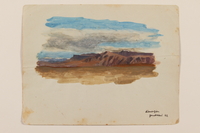
Watercolor of craggy mountain range with a cloud-filled sky by a young Jewish soldier, 2nd Polish Corps
Object
Watercolor of a landscape with craggy mountains created by 22 year old Edward Herzbaum in December 1942 in Kanaqin (Khanaqin), Iraq. This city near the Iranian border is where the Polish Army of the East joined British forces. They met at the large base and field hospital where many died after the long, arduous march from Russia. There were oil fields near the city and it was also along a major Muslim pilgrimage route. Edward now was a soldier in the 2nd Polish Corps, attached to the British Army. The Corps next was stationed near Habbiniya, Iraq, from March-September 1943 to receive artillery and other military training. Edward, age 19, left Łódź, Poland, shortly after Nazi Germany occupied the country in September 1939 to stay with family in Soviet controlled Lvov. In June 1940, he was arrested by Soviet security police and exiled to a forced labor camp. Germany invaded the Soviet Union in June 1941. Edward was released as part of an amnesty granted to Polish prisoners. He joined Anders Army, a Polish military unit formed by General Anders per agreement with Stalin. In August 1942, the unit left Soviet territory and became the 2nd Polish Corps, British Army. In February 1944, they deployed to join the 8th British Army in the Italian Campaign. The Corps fought its way north and was honored for heroism in the May 1944 Battle of Monte Cassino. The unit was in Italy on May 7, 1945, when the war ended. Edward learned that his mother had died in the Łódź Ghetto in 1943. He studied architecture in Rome until the British decided to allow Polish Corps veterans to immigrate to England in October 1946. He then served in the Polish Resettlement Corps for two years and completed his degree.

Sketch of a young man in a cap created by a young Jewish soldier, 2nd Polish Corps
Object
Ink portrait sketch of a young man in a cap created by 22 year old Edward Herzbaum circa 1942 in Uzbekistan. Edward was a soldier in the 2nd Polish Corps, now attached to the British Army. The Corps was next stationed near Habbiniya, Iraq, from March-September 1943 receiving artillery and other military training. Edward, age 19, left Łódź, Poland, shortly after Nazi Germany occupied the country in September 1939. He went to stay with family in Soviet controlled Lvov. In June 1940, Edward was arrested by Soviet security police and exiled to a forced labor camp. Germany invaded the Soviet Union in June 1941. Edward was released as part of an amnesty granted to Polish forced laborers. He headed south to join Anders Army, a Polish military unit formed by General Anders per agreement with Stalin. In August 1942, the unit left Soviet territory and became the 2nd Polish Corps in the British Army. In February 1944, they deployed to join the 8th British Army in the Italian Campaign. They fought their way north and were in Italy in May 1945 when the war ended. Edward learned that his mother had died in the Łódź Ghetto in 1943. He resumed the study of architecture in Rome until the British decided to allow Polish Corps veterans to immigrate to England in October 1946. He studied architecture in Rome until the British decided to allow Polish Corps veterans to immigrate to England in October 1946. He then served in the Polish Resettlement Corps for two years and completed his degree.

Watercolor of a blue/green sea created by a young Jewish soldier, 2nd Polish Corps
Object
Watercolor with a blue green body of water painted by 22 year old Edward Herzbaum circa September 1942 in Khanaqin, Iraq. Edward had traveled south with the Polish Armed Forces of the East, later the 2nd Polish Corps, from the Soviet Union to British territory in Iraq. Edward, 19, left Łódź, Poland, shortly after Nazi Germany occupied the country in September 1939 to stay with family in Soviet controlled Lvov. In June 1940, Edward was arrested by Soviet security police and exiled to a forced labor camp. Germany invaded the Soviet Union in June 1941. Edward was released as part of an amnesty granted to Polish prisoners. He joined the Polish Army of the East, a newly formed volunteer Polish force known as Anders Army. In August 1942, the unit left Soviet territory and became the 2nd Polish Corps in the British Army. In February 1944, they deployed to join the 8th British Army in the Italian Campaign. The Corps fought its way north and was honored for heroism in the 1944 Battle of Monte Cassino. They were in Italy on May 7, 1945, when the war ended. Edward learned that his mother had died in the Łódź Ghetto in 1943. He studied architecture in Rome until the British decided to allow Polish Corps veterans to immigrate to England in October 1946. He then served in the Polish Resettlement Corps for two years and completed his degree.

Watercolor of a British Army truck painted in camouflage created by a young Jewish soldier, 2nd Polish Corps
Object
Watercolor of a camouflaged British military truck created by Edward Herzbaum in Iraq circa 1943 where the 2nd Polish Corps was training with the British Army. Edward was a soldier in the Polish Army of the East which had marched south from the Soviet Union to join the British Army in Iraq. They journeyed to Kanaqin where the British had a large military base and field hospital. Many died there after the long, arduous march from Russia. The Corps next went to Habbiniya where from March-September 1943 they received artillery and other military training. Edward was in the 5th Kresowa Infantry Division, 2nd Polish Corps, British Army. Edward, age 19, left Łódź, Poland, shortly after Nazi Germany occupied the country in September 1939 to stay with family in Soviet controlled Lvov. In June 1940, Edward was arrested by Soviet security police and exiled to a forced labor camp. Germany invaded the Soviet Union in June 1941. Edward was released as part an amnesty granted to Polish prisoners. He headed south to join the Polish Army of the East, known as Anders Army, a volunteer Polish military unit formed by Generals Sikorski and Anders per agreement with Stalin. In August 1942, the unit left Soviet territory and became the 2nd Polish Corps, British Army. In February 1944, they deployed to join the 8th British Army in the Italian Campaign. The Corps fought its way north and was honored for their bravery in the May 1944 Battle of Monte Cassino. They were in Italy on May 7, 1945, when the war ended. Edward learned that his mother had died in the Łódź Ghetto in 1943. He studied architecture in Rome until the British decided to allow Polish Corps veterans to immigrate to England in October 1946. He then served in the Polish Resettlement Corps for two years and completed his degree.
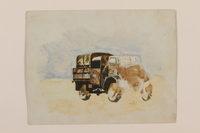
Watercolor sketch of a military transport truck created by a young Jewish soldier, 2nd Polish Corps
Object
Watercolor of a brown British military transport on yellow sand created by Edward Herzbaum in Iraq circa 1943 where the 2nd Polish Corps was training with the British Army. Edward was a soldier in the Polish Army of the East which had marched south from the Soviet Union to join the British Army in Iraq. They journeyed to Kanaqin where the British had a large military base and field hospital. Many died there after the long, arduous march from Russia. The Corps next went to Habbiniya where from March-September 1943 they received artillery and other military training. Edward was in the 5th Kresowa Infantry Division, 2nd Polish Corps. At age 19, he left Łódź, Poland, shortly after Nazi Germany occupied it in September 1939 for Soviet controlled Lvov. In June 1940, Edward was arrested by Soviet security police and exiled to a forced labor camp. Germany invaded the Soviet Union in June 1941. Edward was released in an amnesty of Polish prisoners and joined the Polish Army of the East, known as Anders Army. In August 1942, the unit left Soviet territory and became the 2nd Polish Corps. In February 1944, they deployed to join the 8th British Army in Italy. The Corps fought its way north and was honored for bravery at Monte Cassino. They were in Italy on May 7, 1945, when the war ended. Edward learned that his mother had died in Łódź Ghetto in 1943. He studied architecture in Rome until the British decided to allow Polish Corps veterans to immigrate to England in October 1946. He then served in the Polish Resettlement Corps for two years and completed his degree.

Watercolor of a large tent with a military vehicle created by a young Jewish soldier, 2nd Polish Corps
Object
Watercolor of a large tent and a military vehicle in the desert created by Edward Herzbaum in Iraq circa 1943 where the 2nd Polish Corps was training with the British Army. Edward was a soldier in the Polish Army of the East which had marched south from the Soviet Union to join the British Army in Iraq. They journeyed to Kanaqin where the British had a large military base and field hospital. Many died there after the long, arduous march from Russia. The Corps next went to Habbiniya where from March-September 1943 they received artillery and other military training. Edward was in the 5th Kresowa Infantry Division, 2nd Polish Corps, British Army. Edward, age 19, left Łódź, Poland, shortly after Nazi Germany occupied the country in September 1939 to stay with family in Soviet controlled Lvov. In June 1940, Edward was arrested by Soviet security police and exiled to a forced labor camp. Germany invaded the Soviet Union in June 1941. Edward was released as part an amnesty granted to Polish prisoners. He headed south to join the Polish Army of the East, known as Anders Army, a volunteer Polish military unit formed by Generals Sikorski and Anders per agreement with Stalin. In August 1942, the unit left Soviet territory and became the 2nd Polish Corps, British Army. In February 1944, they deployed to join the 8th British Army in the Italian Campaign. The Corps fought its way north and was honored for their bravery in the May 1944 Battle of Monte Cassino. They were in Italy on May 7, 1945, when the war ended. Edward learned that his mother had died in the Łódź Ghetto in 1943. He studied architecture in Rome until the British decided to allow Polish Corps veterans to immigrate to England in October 1946. He then served in the Polish Resettlement Corps for two years and completed his degree.
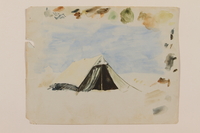
Watercolor of a soldier's tent created by a young Jewish soldier, 2nd Polish Corps
Object
Watercolor drawing of a soldier's tent created by 23 year old Edward Herzbaum in 1943 in Iraq. Edward was a soldier in the Polish Army of the East which had marched south from the Soviet Union to join the British Army in Iraq. They journeyed to Kanaqin where the British had a large military base and field hospital. Many died there after the long, arduous march from Russia. The Corps next went to Habbiniya where from March-September 1943 they received artillery and other military training. Edward, age 19, left Łódź, Poland, shortly after Nazi Germany occupied the country in September 1939. He went to stay with family in Soviet controlled Lvov. In June 1940, Edward was arrested by Soviet security police and exiled to a forced labor camp. Germany invaded the Soviet Union in June 1941. Edward was released as part of an amnesty granted to Polish prisoners. He headed south to join Anders Army, a Polish military unit formed by General Anders per agreement with Stalin. In August 1942, the unit left Soviet territory and became the 2nd Polish Corps in the British Army. In February 1944, they deployed to join the 8th British Army in the Italian Campaign. The Corps fought its way north and was honored for their bravery in the May 1944 Battle of Monte Cassino. They were in Italy on May 7, 1945, when the war ended. Edward learned that his mother had died in the Łódź Ghetto in 1943. He studied architecture in Rome until the British decided to allow Polish Corps veterans to immigrate to England in October 1946. He then served in the Polish Resettlement Corps for two years and completed his degree.
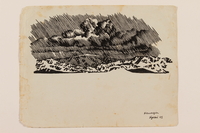
Ink drawing of a heavy rainfall in the mountains created by a Jewish soldier, 2nd Polish Corps
Object
Ink illustration of a rainstorm over a mountaintop created by 23 year old Edward Herzbaum in January 1943 in Kanaqin (Khanaqin), Iraq. Edward was a soldier in the Polish Army of the East which had marched south from the Soviet Union to join the British Army in Iraq. They journeyed to Kanaqin where the British had a large military base and field hospital; many died there after the long, arduous march from Russia. The Corps next went to Habbiniya where from March-September 1943 they received artillery and other military training. Edward, age 19, left Łódź, Poland, shortly after Nazi Germany occupied the country in September 1939. He went to stay with family in Soviet controlled Lvov. In June 1940, Edward was arrested by Soviet security police and exiled to a forced labor camp. Germany invaded the Soviet Union in June 1941. Edward was released as part of an amnesty granted to Polish prisoners. He headed south to join Anders Army, a Polish military unit formed by General Anders per agreement with Stalin. In August 1942, the unit left Soviet territory and became the 2nd Polish Corps in the British Army. In February 1944, they deployed to join the 8th British Army in the Italian Campaign. The Corps fought its way north and was honored for their bravery in the May 1944 Battle of Monte Cassino. They were in Italy on May 7, 1945, when the war ended. Edward learned that his mother had died in the Łódź Ghetto in 1943. He studied architecture in Rome until the British decided to allow Polish Corps veterans to immigrate to England in October 1946. He then served in the Polish Resettlement Corps for two years and completed his degree.

Pencil portrait of a young man in profile created by Jewish soldier, 2nd Polish Corps
Object
Portrait sketch of a young man created by 23 year old Edward Herzbaum in January 1943 in Iraq. Edward was a soldier in the Polish Army of the East which had marched south from the Soviet Union to join the British Army in Iraq. They journeyed to Kanaqin where the British had a large military base and field hospital where many died after the long, arduous march from Russia. The Corps next went to Habbiniya where from March-September 1943 they received artillery and other military training. Edward, age 19, left Łódź, Poland, shortly after Nazi Germany occupied the country in September 1939. He went to stay with family in Soviet controlled Lvov. In June 1940, Edward was arrested by Soviet security police and exiled to a forced labor camp. Germany invaded the Soviet Union in June 1941. Edward was released as part of an amnesty granted to Polish prisoners. He headed south to join Anders Army, a Polish military unit formed by General Anders per agreement with Stalin. In August 1942, the unit left Soviet territory and became the 2nd Polish Corps in the British Army. In February 1944, they deployed to join the 8th British Army in the Italian Campaign. The Corps fought its way north and was honored for their bravery in the May 1944 Battle of Monte Cassino. They were in Italy on May 7, 1945, when the war ended. Edward learned that his mother had died in the Łódź Ghetto in 1943. He studied architecture in Rome until the British decided to allow Polish Corps veterans to immigrate to England in October 1946. He then served in the Polish Resettlement Corps for two years and completed his degree.
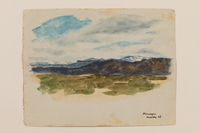
Watercolor of distant snowy mountains created by a Jewish soldier, 2nd Polish Corps
Object
Watercolor of distant snow topped mountains created by 23 year old Edward Herzbaum in March 1943 in Kanaqin (Khanaqin), Iraq. Edward was a soldier in the Polish Army of the East which had marched south from the Soviet Union to join the British Army in Iraq. They journeyed to the border town of Kanaqin where the British had a large military base and field hospital where many died after the long, arduous march from Russia. There were oil fields near the city and it was also along a major Muslim pilgrimage route. The Corps next went to Habbiniya where from March-September 1943 they received artillery and other military training. Edward, age 19, left Łódź, Poland, shortly after Nazi Germany occupied the country in September 1939. He went to stay with family in Soviet controlled Lvov. In June 1940, Edward was arrested by Soviet security police and exiled to a forced labor camp. Germany invaded the Soviet Union in June 1941. Edward was released as part of an amnesty granted to Polish prisoners. He headed south to join Anders Army, a Polish military unit formed by General Anders per agreement with Stalin. In August 1942, the unit left Soviet territory and became the 2nd Polish Corps in the British Army. In February 1944, they deployed to join the 8th British Army in the Italian Campaign. The Corps fought its way north and was honored for their bravery in the May 1944 Battle of Monte Cassino. They were in Italy on May 7, 1945, when the war ended. Edward learned that his mother had died in the Łódź Ghetto in 1943. He studied architecture in Rome until the British decided to allow Polish Corps veterans to immigrate to England in October 1946. He then served in the Polish Resettlement Corps for two years and completed his degree.
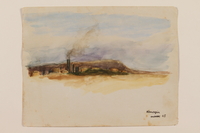
Watercolor of an oil refinery created by a young Jewish soldier, 2nd Polish Corps
Object
Watercolor painting of an oil refinery in the desert created by 23 year old Edward Herzbaum in March 1943 in Kanaqin (Khanaqin), Iraq. Edward was a soldier in the Polish Army of the East which had marched south from the Soviet Union to join the British Army in Iraq as the Polish 2nd Corps. They journeyed to the border town of Kanaqin where the British had a large military base and field hospital where many died after the long, arduous march from Russia. There were oil fields near the city and it was also along a major Muslim pilgrimage route. The Corps next went to Habbiniya where from March-September 1943 they received artillery and other military training. Edward, age 19, left Łódź, Poland, shortly after Nazi Germany occupied the country in September 1939 for Soviet controlled Lvov. In June 1940, Edward was arrested by Soviet security police and exiled to a forced labor camp. Germany invaded the Soviet Union in June 1941. Edward was released in an amnesty of Polish prisoners and joined Anders Army. In August 1942, the unit left Soviet territory and became the 2nd Polish Corps. In February 1944, they deployed to join the 8th British Army in Italy. The Corps fought its way north and was honored for their bravery in the May 1944 Battle of Monte Cassino. They were in Italy on May 7, 1945, when the war ended. Edward learned that his mother had died in Łódź Ghetto in 1943. He studied architecture in Rome until the British decided to allow Polish Corps veterans to immigrate to England in October 1946. He then served in the Polish Resettlement Corps for two years and completed his degree.
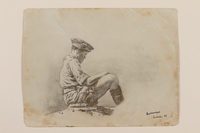
Pencil portrait of a Polish soldier seated on a rock created by a young Jewish soldier, 2nd Polish Corps
Object
Realistic full figure portrait of a young, uniformed Polish soldier seated on a rock created by 23 year old Edward Herzbaum in April 1943 in Habbinaya, Iraq. Habbinaya was an RAF (British Royal Air Force) base and colonial town where Edward often went to swim and see movies. Edward was a soldier in the 2nd Polish Corps, British Army, which was stationed near Habbiniya from March-September 1943 receiving artillery and other military training. Edward, age 19, had left Łódź, Poland, shortly after Nazi Germany occupied the country in September 1939 to stay with family in Soviet controlled Lvov. In June 1940, he was arrested by Soviet security police and exiled to a forced labor camp. Germany invaded the Soviet Union in June 1941. Edward was released as part an amnesty granted to Polish prisoners. He headed south to join Anders Army, a Polish military unit formed by General Anders per agreement with Stalin. In August 1942, the unit left Soviet territory and became the 2nd Polish Corps, British Army. In February 1944, they deployed to join the 8th British Army in the Italian Campaign. The Corps fought its way north and was honored for heroism in the May 1944 Battle of Monte Cassino. The unit was in Italy on May 7, 1945, when the war ended. Edward learned that his mother had died in the Łódź Ghetto in 1943. He studied architecture in Rome until the British decided to allow Polish Corps veterans to immigrate to England in October 1946. He then served in the Polish Resettlement Corps for two years and completed his degree.

Pencil portrait of the head of a young Polish soldier in right profile created by a Jewish soldier, 2nd Polish Corps
Object
Portrait of the head of a young man, probably a felllow Polish soldier, created by 23 year old Edward Herzbaum in April 1943 in Habbinaya, Iraq. Habbinaya was an RAF (British Royal Air Force) base and colonial town 40 miles east of Baghdad where Edward often went to swim and see movies. Edward was a soldier in the 2nd Polish Corps, British Army, which was stationed near Habbiniya from March-September 1943 receiving artillery and other military training. Edward, age 19, had left Łódź, Poland, shortly after Nazi Germany occupied the country in September 1939 to stay with family in Soviet controlled Lvov. In June 1940, he was arrested by Soviet security police and exiled to a forced labor camp. Germany invaded the Soviet Union in June 1941. Edward was released as part an amnesty granted to Polish prisoners. He headed south to join Anders Army, a Polish military unit formed by General Anders per agreement with Stalin. In August 1942, the unit left Soviet territory and became the 2nd Polish Corps, British Army. In February 1944, they deployed to join the 8th British Army in the Italian Campaign. The Corps fought its way north and was honored for heroism in the May 1944 Battle of Monte Cassino. The unit was in Italy on May 7, 1945, when the war ended. Edward learned that his mother had died in the Łódź Ghetto in 1943. He studied architecture in Rome until the British decided to allow Polish Corps veterans to immigrate to England in October 1946. He then served in the Polish Resettlement Corps for two years and completed his degree.
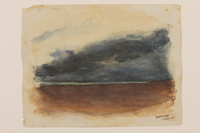
Watercolor of a blue lake, brown sands and a deep blue sky created by a Jewish soldier, 2nd Polish Corps
Object
Watercolor of a distant view of Lake Habbaniyah, Irag, created by 23 year old Edward Herzbaum in April 1943. Habbinaya was an RAF (British Royal Air Force) base and colonial town 40 miles east of Baghdad where Edward often went to swim and see movies. Edward was a soldier in the 2nd Polish Corps, now attached to the British Army. The Corps was stationed near Habbiniya from March-September 1943 receiving artillery and other military training. Edward, age 19, had left Łódź, Poland, shortly after Nazi Germany occupied the country in September 1939 to stay with family in Soviet controlled Lvov. In June 1940, he was arrested by Soviet security police and exiled to a forced labor camp. Germany invaded the Soviet Union in June 1941. Edward was released as part an amnesty granted to Polish prisoners. He headed south to join Anders Army, a Polish military unit formed by General Anders per agreement with Stalin. In August 1942, the unit left Soviet territory and became the 2nd Polish Corps in the British Army. In February 1944, they deployed to join the 8th British Army in the Italian Campaign. The Corps fought its way north and was honored for heroism in the May 1944 Battle of Monte Cassino. The unit was in Italy on May 7, 1945, when the war ended. Edward learned that his mother had died in the Łódź Ghetto in 1943. He studied architecture in Rome until the British decided to allow Polish Corps veterans to immigrate to England in October 1946. He then served in the Polish Resettlement Corps for two years and completed his degree.
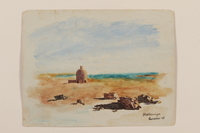
Watercolor of a domed building in the desert near blue green Lake Habbiniyah created by a Jewish soldier, 2nd Polish Corps
Object
Watercolor of an imposing domed building near Lake Habbaniyah, Irag, created by 23 year old Edward Herzbaum in April 1943. Habbinaya was an RAF (British Royal Air Force) base and colonial town 40 miles east of Baghdad where Edward often went to swim and see movies. Edward was a soldier in the 2nd Polish Corps, now attached to the British Army. The Corps was stationed near Habbiniya from March-September 1943 receiving artillery and other military training. Edward, age 19, had left Łódź, Poland, shortly after Nazi Germany occupied the country in September 1939 to stay with family in Soviet controlled Lvov. In June 1940, he was arrested by Soviet security police and exiled to a forced labor camp. Germany invaded the Soviet Union in June 1941. Edward was released as part an amnesty granted to Polish prisoners. He headed south to join Anders Army, a Polish military unit formed by General Anders per agreement with Stalin. In August 1942, the unit left Soviet territory and became the 2nd Polish Corps in the British Army. In February 1944, they deployed to join the 8th British Army in the Italian Campaign. The Corps fought its way north and was honored for heroism in the May 1944 Battle of Monte Cassino. The unit was in Italy on May 7, 1945, when the war ended. Edward learned that his mother had died in the Łódź Ghetto in 1943. He studied architecture in Rome until the British decided to allow Polish Corps veterans to immigrate to England in October 1946. He then served in the Polish Resettlement Corps for two years and completed his degree.

Pencil drawing of two tents created by a Jewish soldier, 2nd Polish Corps
Object
Pencil drawing of two tents created by 23 year old Edward Herzbaum in Habbinaya, Iraq, in April 1943. See 2012.471.54 for a similar scene in watercolor. Habbinaya was an RAF (British Royal Air Force) base and colonial town 40 miles east of Baghdad where Edward often went to swim and see movies. Edward was a soldier in the 2nd Polish Corps, now attached to the British Army. The Corps was stationed near Habbiniya from March-September 1943 receiving artillery and other military training. Edward, age 19, had left Łódź, Poland, shortly after Nazi Germany occupied the country in September 1939 to stay with family in Soviet controlled Lvov. In June 1940, he was arrested by Soviet security police and exiled to a forced labor camp. Germany invaded the Soviet Union in June 1941. Edward was released as part an amnesty granted to Polish prisoners. He headed south to join Anders Army, a Polish military unit formed by General Anders per agreement with Stalin. In August 1942, the unit left Soviet territory and became the 2nd Polish Corps in the British Army. In February 1944, they deployed to join the 8th British Army in the Italian Campaign. The Corps fought its way north and was honored for heroism in the May 1944 Battle of Monte Cassino. The unit was in Italy on May 7, 1945, when the war ended. Edward learned that his mother had died in the Łódź Ghetto in 1943. He studied architecture in Rome until the British decided to allow Polish Corps veterans to immigrate to England in October 1946. He then served in the Polish Resettlement Corps for two years and completed his degree.
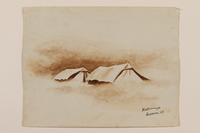
Brown hued watercolor of two tents in a desert windstorm created by a Jewish soldier, 2nd Polish Corps
Object
Watercolor of two tents in a sandstorm created by 23 year old Edward Herzbaum in Habbinaya (Habbaniyah), Iraq, in April 1943. See 2012.471.53 for a similar scene in pencil. Habbinaya was an RAF (British Royal Air Force) base and colonial town 40 miles east of Baghdad where Edward often went to swim and see movies. Edward was a soldier in the 2nd Polish Corps, now attached to the British Army. The Corps was stationed near Habbiniya from March-September 1943 receiving artillery and other military training. Edward, age 19, had left Łódź, Poland, shortly after Nazi Germany occupied the country in September 1939 to stay with family in Soviet controlled Lvov. In June 1940, he was arrested by Soviet security police and exiled to a forced labor camp. Germany invaded the Soviet Union in June 1941. Edward was released as part an amnesty granted to Polish prisoners. He headed south to join Anders Army, a Polish military unit formed by General Anders per agreement with Stalin. In August 1942, the unit left Soviet territory and became the 2nd Polish Corps in the British Army. In February 1944, they deployed to join the 8th British Army in the Italian Campaign. The Corps fought its way north and was honored for heroism in the May 1944 Battle of Monte Cassino. The unit was in Italy on May 7, 1945, when the war ended. Edward learned that his mother had died in the Łódź Ghetto in 1943. He studied architecture in Rome until the British decided to allow Polish Corps veterans to immigrate to England in October 1946. He then served in the Polish Resettlement Corps for two years and completed his degree.
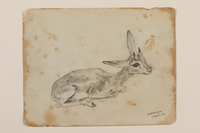
Pencil drawing of a young Dorcas gazelle created by a Jewish soldier, 2nd Polish Corps
Object
Realistic pencil drawing of a young Dorcas gazelle at rest drawn by 23 year old Edward Herzbaum in Habbinaya (Habbaniyah), Iraq, in August 1943. Habbinaya was an RAF (British Royal Air Force) base and colonial town 40 miles east of Baghdad where Edward often went to swim and see movies. Edward was a soldier in the 2nd Polish Corps, now attached to the British Army. The Corps was stationed near Habbiniya from March-September 1943 receiving artillery and other military training. Edward, age 19, had left Łódź, Poland, shortly after Nazi Germany occupied the country in September 1939 to stay with family in Soviet controlled Lvov. In June 1940, he was arrested by Soviet security police and exiled to a forced labor camp. Germany invaded the Soviet Union in June 1941. Edward was released as part an amnesty granted to Polish prisoners. He headed south to join Anders Army, a Polish military unit formed by General Anders per agreement with Stalin. In August 1942, the unit left Soviet territory and became the 2nd Polish Corps in the British Army. In February 1944, they deployed to join the 8th British Army in the Italian Campaign. The Corps fought its way north and was honored for heroism in the May 1944 Battle of Monte Cassino. The unit was in Italy on May 7, 1945, when the war ended. Edward learned that his mother had died in the Łódź Ghetto in 1943. He studied architecture in Rome until the British decided to allow Polish Corps veterans to immigrate to England in October 1946. He then served in the Polish Resettlement Corps for two years and completed his degree.

Pencil sketch of a horned bull drawn by a Jewish soldier, 2nd Polish Corps
Object
Pencil drawing of a horned bull created by 23 year old Edward Herzbaum circa 1943. Edward was a soldier in the Polish Army of the East which had marched south in 1941-1942 from the Soviet Union to join the British Army in Iraq. They journeyed to the border town of Kanaqin where the British had a large military base and field hospital where many died after the long, arduous march from Russia. There were oil fields near the city and it was also along a major Muslim pilgrimage route. The Corps next went to Habbiniya where from March-September 1943 they received artillery and other military training. Edward, age 19, left Łódź, Poland, shortly after Nazi Germany occupied the country in September 1939. He went to stay with family in Soviet controlled Lvov. In June 1940, Edward was arrested by Soviet security police and exiled to a forced labor camp. Germany invaded the Soviet Union in June 1941. Edward was released as part of an amnesty granted to Polish prisoners. He headed south to join Anders Army, a Polish military unit formed by General Anders per agreement with Stalin. In August 1942, the unit left Soviet territory and became the 2nd Polish Corps in the British Army. In February 1944, they deployed to join the 8th British Army in the Italian Campaign. The Corps fought its way north and was honored for their bravery in the May 1944 Battle of Monte Cassino. They were in Italy on May 7, 1945, when the war ended. Edward learned that his mother had died in the Łódź Ghetto in 1943. He studied architecture in Rome until the British decided to allow Polish Corps veterans to immigrate to England in October 1946. He then served in the Polish Resettlement Corps for two years and completed his degree.

Line drawing of a young woman and a mustached man drawn by a Jewish soldier, 2nd Polish Corps
Object
Small line drawing in ink of a young woman and a mustached man created by 23 year old Edward Herzbaum circa 1943. Edward was a soldier in the Polish Army of the East which had marched south in 1941-1942 from the Soviet Union to join the British Army in Iraq. They journeyed to the border town of Kanaqin where the British had a large military base and field hospital where many died after the long, arduous march from Russia. There were oil fields near the city and it was also along a major Muslim pilgrimage route. The Corps next went to Habbiniya where from March-September 1943 they received artillery and other military training. Edward, age 19, left Łódź, Poland, shortly after Nazi Germany occupied the country in September 1939. He went to stay with family in Soviet controlled Lvov. In June 1940, Edward was arrested by Soviet security police and exiled to a forced labor camp. Germany invaded the Soviet Union in June 1941. Edward was released as part of an amnesty granted to Polish prisoners. He headed south to join Anders Army, a Polish military unit formed by General Anders per agreement with Stalin. In August 1942, the unit left Soviet territory and became the 2nd Polish Corps in the British Army. In February 1944, they deployed to join the 8th British Army in the Italian Campaign. The Corps fought its way north and was honored for their bravery in the May 1944 Battle of Monte Cassino. They were in Italy on May 7, 1945, when the war ended. Edward learned that his mother had died in the Łódź Ghetto in 1943. He studied architecture in Rome until the British decided to allow Polish Corps veterans to immigrate to England in October 1946. He then served in the Polish Resettlement Corps for two years and completed his degree.
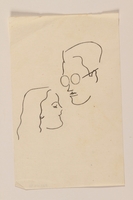
Line drawing of a man with glasses and a woman drawn by a young Jewish soldier, 2nd Polish Corps
Object
Small line drawing in ink of a young woman and a man with glasses created by Edward Herzbaum circa 1943. Edward was a soldier in the Polish Army of the East which had marched south in 1941-1942 from the Soviet Union to join the British Army in Iraq. They journeyed to the border town of Kanaqin where the British had a large military base and field hospital where many died after the long, arduous march from Russia. There were oil fields near the city and it was also along a major Muslim pilgrimage route. The Corps next went to Habbiniya where from March-September 1943 they received artillery and other military training. Edward, age 19, left Łódź, Poland, shortly after Nazi Germany occupied the country in September 1939. He went to stay with family in Soviet controlled Lvov. In June 1940, Edward was arrested by Soviet security police and exiled to a forced labor camp. Germany invaded the Soviet Union in June 1941. Edward was released as part of an amnesty granted to Polish prisoners. He headed south to join Anders Army, a Polish military unit formed by General Anders per agreement with Stalin. In August 1942, the unit left Soviet territory and became the 2nd Polish Corps in the British Army. In February 1944, they deployed to join the 8th British Army in the Italian Campaign. The Corps fought its way north and was honored for their bravery in the May 1944 Battle of Monte Cassino. They were in Italy on May 7, 1945, when the war ended. Edward learned that his mother had died in the Łódź Ghetto in 1943. He studied architecture in Rome until the British decided to allow Polish Corps veterans to immigrate to England in October 1946. He then served in the Polish Resettlement Corps for two years and completed his degree.

Small pencil lin drawing portrait of a woman wearing lipstick by a Jewish soldier, 2nd Polish Corps
Object
Pencil drawing of a woman's face, nearly a caricature, created by 23 year old Edward Herzbaum in 1943-1944. Edward was a soldier in the Polish Army of the East which had marched south in 1941-1942 from the Soviet Union to join the British Army in Iraq. They journeyed to the border town of Kanaqin where the British had a large military base and field hospital where many died after the long, arduous march from Russia. There were oil fields near the city and it was also along a major Muslim pilgrimage route. The Corps next went to Habbiniya where from March-September 1943 they received artillery and other military training. Edward, age 19, left Łódź, Poland, shortly after Nazi Germany occupied the country in September 1939. He went to stay with family in Soviet controlled Lvov. In June 1940, Edward was arrested by Soviet security police and exiled to a forced labor camp. Germany invaded the Soviet Union in June 1941. Edward was released as part of an amnesty granted to Polish prisoners. He headed south to join Anders Army, a Polish military unit formed by General Anders per agreement with Stalin. In August 1942, the unit left Soviet territory and became the 2nd Polish Corps in the British Army. In February 1944, they deployed to join the 8th British Army in the Italian Campaign. The Corps fought its way north and was honored for their bravery in the May 1944 Battle of Monte Cassino. They were in Italy on May 7, 1945, when the war ended. Edward learned that his mother had died in the Łódź Ghetto in 1943. He studied architecture in Rome until the British decided to allow Polish Corps veterans to immigrate to England in October 1946. He then served in the Polish Resettlement Corps for two years and completed his degree.

Small line drawing of a woman and a soldier dancing by a young Jewsh soldier, 2nd Polish Corps
Object
Small pencilled line drawing of a man in uniform and a woman dancing created by Edward Herzbaum circa 1943-1944. Edward was a soldier in the Polish Army of the East which had marched south in 1941-1942 from the Soviet Union to join the British Army in Iraq. They journeyed to the border town of Kanaqin where the British had a large military base and field hospital where many died after the long, arduous march from Russia. There were oil fields near the city and it was also along a major Muslim pilgrimage route. The Corps next went to Habbiniya where from March-September 1943 they received artillery and other military training. Edward, age 19, left Łódź, Poland, shortly after Nazi Germany occupied the country in September 1939. He went to stay with family in Soviet controlled Lvov. In June 1940, Edward was arrested by Soviet security police and exiled to a forced labor camp. Germany invaded the Soviet Union in June 1941. Edward was released as part of an amnesty granted to Polish prisoners. He headed south to join Anders Army, a Polish military unit formed by General Anders per agreement with Stalin. In August 1942, the unit left Soviet territory and became the 2nd Polish Corps in the British Army. In February 1944, they deployed to join the 8th British Army in the Italian Campaign. The Corps fought its way north and was honored for their bravery in the May 1944 Battle of Monte Cassino. They were in Italy on May 7, 1945, when the war ended. Edward learned that his mother had died in the Łódź Ghetto in 1943. He studied architecture in Rome until the British decided to allow Polish Corps veterans to immigrate to England in October 1946. He then served in the Polish Resettlement Corps for two years and completed his degree.
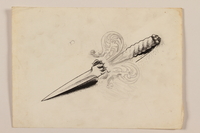
Sketch of a straight, double edged dagger with a scrollwork crossguard by a Jewish soldier, 2nd Polish Corps
Object
Ink and pencil drawing of a dagger with an elaborate guard and coiled handle created by 23 year old Edward Herzbaum circa 1943-1944. Edward was a soldier in the Polish Army of the East which had marched south in 1941-1942 from the Soviet Union to join the British Army in Iraq. They journeyed to the border town of Kanaqin where the British had a large military base and field hospital where many died after the long, arduous march from Russia. There were oil fields near the city and it was also along a major Muslim pilgrimage route. The Corps next went to Habbiniya where from March-September 1943 they received artillery and other military training. Edward, age 19, left Łódź, Poland, shortly after Nazi Germany occupied the country in September 1939. He went to stay with family in Soviet controlled Lvov. In June 1940, Edward was arrested by Soviet security police and exiled to a forced labor camp. Germany invaded the Soviet Union in June 1941. Edward was released as part of an amnesty granted to Polish prisoners. He headed south to join Anders Army, a Polish military unit formed by General Anders per agreement with Stalin. In August 1942, the unit left Soviet territory and became the 2nd Polish Corps in the British Army. In February 1944, they deployed to join the 8th British Army in the Italian Campaign. The Corps fought its way north and was honored for their bravery in the May 1944 Battle of Monte Cassino. They were in Italy on May 7, 1945, when the war ended. Edward learned that his mother had died in the Łódź Ghetto in 1943. He studied architecture in Rome until the British decided to allow Polish Corps veterans to immigrate to England in October 1946. He then served in the Polish Resettlement Corps for two years and completed his degree.
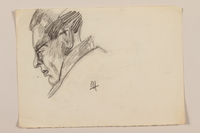
Self portrait drawing created by a Jewish soldier, 2nd Polish Corps
Object
Self portrait pencil sketch created by 24 year old Edward Herzbaum circa 1943-1944 when, as a soldier in the 5th Kresowa, 2nd Polish Corps, he was training with the British Army in the Middle East. Edward was a soldier in the Polish Army of the East which had marched south in 1941-1942 from the Soviet Union to join the British Army in Iraq. They journeyed to the border town of Kanaqin where the British had a large military base and field hospital where many died after the long, arduous march from Russia. There were oil fields near the city and it was also along a major Muslim pilgrimage route. The Corps next went to Habbiniya where from March-September 1943 they received artillery and other military training. Edward, age 19, left Łódź, Poland, shortly after Nazi Germany occupied the country in September 1939. He went to stay with family in Soviet controlled Lvov. In June 1940, Edward was arrested by Soviet security police and exiled to a forced labor camp. Germany invaded the Soviet Union in June 1941. Edward was released as part of an amnesty granted to Polish prisoners. He headed south to join Anders Army, a Polish military unit formed by General Anders per agreement with Stalin. In August 1942, the unit left Soviet territory and became the 2nd Polish Corps in the British Army. In February 1944, they deployed to join the 8th British Army in the Italian Campaign. The Corps fought its way north and was honored for their bravery in the May 1944 Battle of Monte Cassino. They were in Italy on May 7, 1945, when the war ended. Edward learned that his mother had died in the Łódź Ghetto in 1943. He studied architecture in Rome until the British decided to allow Polish Corps veterans to immigrate to England in October 1946. He then served in the Polish Resettlement Corps for two years and completed his degree.

Portrait drawing of a young man in left profile by a Jewish soldier, 2nd Polish Corps
Object
Pencil portrait of a young man in left profile created by 23 year old Edward Herzbaum in 1943-1944 when, as a soldier in the 5th Kresowa, 2nd Polish Corps, he was training with the British Army in the Middle East. Edward was a soldier in the Polish Army of the East which had marched south in 1941-1942 from the Soviet Union to join the British Army in Iraq. They journeyed to the border town of Kanaqin where the British had a large military base and field hospital where many died after the long, arduous march from Russia. There were oil fields near the city and it was also along a major Muslim pilgrimage route. The Corps next went to Habbiniya where from March-September 1943 they received artillery and other military training. Edward, age 19, left Łódź, Poland, shortly after Nazi Germany occupied the country in September 1939. He went to stay with family in Soviet controlled Lvov. In June 1940, Edward was arrested by Soviet security police and exiled to a forced labor camp. Germany invaded the Soviet Union in June 1941. Edward was released as part of an amnesty granted to Polish prisoners. He headed south to join Anders Army, a Polish military unit formed by General Anders per agreement with Stalin. In August 1942, the unit left Soviet territory and became the 2nd Polish Corps in the British Army. In February 1944, they deployed to join the 8th British Army in the Italian Campaign. The Corps fought its way north and was honored for their bravery in the May 1944 Battle of Monte Cassino. They were in Italy on May 7, 1945, when the war ended. Edward learned that his mother had died in the Łódź Ghetto in 1943. He studied architecture in Rome until the British decided to allow Polish Corps veterans to immigrate to England in October 1946. He then served in the Polish Resettlement Corps for two years and completed his degree.

Pencil portrait of a middle aged uniformed officer by a Jewish soldier, 2nd Polish Corps
Object
Realistic pencil portrait of an older man in uniform created by Edward Herzbaum in 1943-1944 when, as a soldier in the 5th Kresowa, 2nd Polish Corps, he was training with the British Army in the Middle East. Edward was a soldier in the Polish Army of the East which had marched south in 1941-1942 from the Soviet Union to join the British Army in Iraq. They journeyed to the border town of Kanaqin where the British had a large military base and field hospital where many died after the long, arduous march from Russia. There were oil fields near the city and it was also along a major Muslim pilgrimage route. The Corps next went to Habbiniya where from March-September 1943 they received artillery and other military training. Edward, age 19, left Łódź, Poland, shortly after Nazi Germany occupied the country in September 1939. He went to stay with family in Soviet controlled Lvov. In June 1940, Edward was arrested by Soviet security police and exiled to a forced labor camp. Germany invaded the Soviet Union in June 1941. Edward was released as part of an amnesty granted to Polish prisoners. He headed south to join Anders Army, a Polish military unit formed by General Anders per agreement with Stalin. In August 1942, the unit left Soviet territory and became the 2nd Polish Corps in the British Army. In February 1944, they deployed to join the 8th British Army in the Italian Campaign. The Corps fought its way north and was honored for their bravery in the May 1944 Battle of Monte Cassino. They were in Italy on May 7, 1945, when the war ended. Edward learned that his mother had died in the Łódź Ghetto in 1943. He studied architecture in Rome until the British decided to allow Polish Corps veterans to immigrate to England in October 1946. He then served in the Polish Resettlement Corps for two years and completed his degree.

Brown and orange watercolor of the corpse of a German soldier near Monte Cassino by a Jewish soldier, 2nd Polish Corps
Object
Brown and orange shaded watercolor of a dead German soldier lying in a field painted by 24 year old Edward Herzbaum. It depicts a sight he witnessed on June 1, 1944, after a battle near Portella, Italy. Edward was a soldier in the 5th Kresowa, 2nd Polish Corps, formerly the Polish Army of the East which had marched south in 1941-1942 from the Soviet Union to join the British Army in Iraq. In February 1944, they deployed to join the 8th British Army in the Italian Campaign. The Corps fought its way north and was honored for their bravery in the May 1944 Battle of Monte Cassino. Edward, age 19, had left Łódź, Poland, shortly after Nazi Germany occupied the country in September 1939 to stay with family in Soviet controlled Lvov. In June 1940, he was arrested by Soviet security police and exiled to a forced labor camp. Germany invaded the Soviet Union in June 1941. Edward was released as part of an amnesty granted to Polish prisoners. He headed south to join Anders Army, a Polish military unit formed by General Anders per agreement with Stalin. In August 1942, the unit left Soviet territory and became the 2nd Polish Corps, British Army. They were in Italy on May 7, 1945, when the war ended. Edward learned that his mother had died in the Łódź Ghetto in 1943. He studied architecture in Rome until the British decided to allow Polish Corps veterans to immigrate to England in October 1946. He then served in the Polish Resettlement Corps for two years and completed his degree.
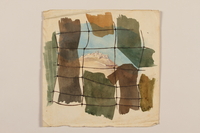
View of Monte Cassino abbey through camouflage netting by a Jewish soldier, 2nd Polish Corps
Object
Watercolor study of the ruins of Monte Cassino abbey viewed through camouflage netting painted by 24 year old Edward Herzbaum on May 31, 1944. Edward was a soldier in the 5th Kresowa, 2nd Polish Corps, which was honored for their bravery during the four month long 1944 Battle of Monte Cassino in Italy. The Allies bombed the 1349 abbey in February and the resulting ruins provided protected defensive positions for German troops. The 2nd Polish Corps led the mountain assault in the May 1944 victory, the fourth battle waged by Allied forces to break through the German stronghold blocking the way north. Edward, 19, had left Łódź, Poland, shortly after Germany occupied the country in September 1939 to stay with family in Soviet controlled Lvov. In June 1940, he was arrested by Soviet security police and exiled to a forced labor camp. Germany invaded the Soviet Union in June 1941. Edward was released as part of an amnesty granted to Polish prisoners. He headed south to join the Polish Army of the East, known as Anders Army, a volunteer unit formed by General Anders per agreement with Stalin. In August 1942, the unit left Soviet territory and became the 2nd Polish Corps, British Army. In February 1944, they deployed to join the 8th British Army in the Italian Campaign. They fought their way north and were in Italy in May 1945 when the war ended. Edward learned that his mother had died in the Łódź Ghetto in 1943. He studied architecture in Rome until the British decided to allow Polish Corps veterans to immigrate to England in October 1946. He then worked for two years for the Polish Resettlement Corps and completed his degree.

Study of soldiers preparing for the Battle of Monte Cassino by a Jewish soldier, 2nd Polish Corps
Object
Preliminary study with two jeeps carrying soldiers with a sketch of a cliff created by Edward Herzbaum, 24, on May 31, 1944. Several works created by Edward were published during the war in military produced magazines. Edward was a soldier in the 2nd Polish Corps, British Army, which was honored for bravery during the four month 1944 Battle of Monte Cassino in Italy. The Allies bombed the 1349 abbey in February and the resulting ruins provided protected defensive positions for German troops, blocking the northward progress of the Allies. The 2nd Polish Corps led the mountain assault in the May victory, the fourth battle waged to break through the German stronghold. Edward, 19, left Łódź, Poland, shortly after Germany occupied the country in September 1939 for Soviet controlled Lvov. In June 1940, he was exiled to a gulag by Soviet security police. Germany invaded the Soviet Union in June 1941. Edward was released in an amnesty of Polish prisoners. He headed south to join the Polish Army of the East, known as Anders Army. In August 1942, the unit left Soviet territory and became the 2nd Polish Corps. In February 1944, they joined the 8th British Army in Italy. They were in Italy on VE Day, May 8, 1945 when the war ended. Edward learned that his mother died in Łódź Ghetto in 1943. He studied architecture in Rome until the British decided to allow Polish Corps veterans to immigrate to England in October 1946. He then worked for two years for the Polish Resettlement Corps and completed his degree.

Watercolor of Monte Cassino abbey ruins by a young Jewish soldier, 2nd Polish Corps
Object
Watercolor of Monte Cassino abbey ruins created by 24 year old Edward Herzbaum on May 31, 1944. Edward was a soldier in the 2nd Polish Corps, who participated in the four month long Battle of Monte Cassino in Italy from January - May 1944. The Allies bombed the 1349 abbey in February and the resulting ruins provided protected defensive positions for German troops. The 2nd Polish Corps led the mountain assault in the May 1944 victory, the fourth battle by Allied forces since January to break through German defenses. Edward, 19, had left Łódź, Poland, shortly after Germany occupied the country in September 1939 to stay with family in Soviet controlled Lvov. In June 1940, he was arrested by Soviet security police and exiled to a forced labor camp. Germany invaded the Soviet Union in June 1941. Edward was released as part of an amnesty granted to Polish prisoners. He headed south to join the Polish Army of the East, known as Anders Army, a volunteer unit formed by General Anders per agreement with Stalin. In August 1942, the unit left Soviet territory and became the 2nd Polish Corps, British Army. In February 1944, they deployed to join the 8th British Army in the Italian Campaign. They fought their way north and were in Italy in May 1945 when the war ended. Edward learned that his mother had died in the Łódź Ghetto in 1943. He studied architecture in Rome until the British decided to allow Polish Corps veterans to immigrate to England in October 1946. He then worked for two years for the Polish Resettlement Corps and completed his degree.

Ink drawing of soldiers on a camouflaged tank by a young Jewish soldier, 2nd Polish Corps
Object
Silhouette style ink drawing of soldiers around the gun turret of a tank advancing through Bologna, Italy, created by 25 year old Edward Herzbaum for a Polish soldiers' magazine, "Uwaga Nadchodzi!" after the April 1945 battle in Bologna, Italy. Edward was a soldier in the 2nd Polish Corps which joined the British 8th Army for the Italian campaign in 1944. He participated in the four month long Battle of Monte Cassino in Italy from January -May 1944, during which the 2nd Polish Corps led the mountain assault in the May 1944 victory. Edward, 19, left Łódź, Poland, shortly after Germany occupied the country in September 1939 to stay with family in Soviet controlled Lvov. In June 1940, he was arrested by Soviet security police and exiled to a forced labor camp. Germany invaded the Soviet Union in June 1941. Edward was released as part of an amnesty granted to Polish prisoners. He headed south to join the Polish Army of the East, known as Anders Army, a volunteer unit formed by General Anders per agreement with Stalin. In August 1942, the unit left Soviet territory and became the 2nd Polish Corps, British Army. In February 1944, they deployed to join the 8th British Army in Italy. They fought their way north and were in Italy in May 1945 when the war ended. Edward learned that his mother had died in the Łódź Ghetto in 1943. He studied architecture in Rome until the British decided to allow Polish Corps veterans to immigrate to England in October 1946. He then worked for two years for the Polish Resettlement Corps and completed his degree.
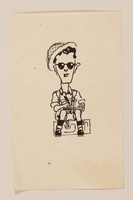
Self portrait caricature of a soldier sketching by a Jewish soldier, 2nd Polish Corps
Object
Self portrait cartoon in ink of a young soldier sketching created by 25 year old Edward Herzbaum in Italy circa 1945, after the war. Edward was a soldier in the 2nd Polish Corps which joined the British 8th Army for the Italian campaign in 1944. He participated in the four month long Battle of Monte Cassino in Italy from January - May 1944, during which the 2nd Polish Corps led the mountain assault in the May 1944 victory. Edward, 19, left Łódź, Poland, shortly after Germany occupied the country in September 1939 to stay with family in Soviet controlled Lvov. In June 1940, he was arrested by Soviet security police and exiled to a forced labor camp. Germany invaded the Soviet Union in June 1941. Edward was released as part of an amnesty granted to Polish prisoners. He headed south to join the Polish Army of the East, known as Anders Army, a volunteer unit formed by General Anders per agreement with Stalin. In August 1942, the unit left Soviet territory and became the 2nd Polish Corps, British Army. In February 1944, they deployed to join the 8th British Army in Italy. They fought their way north and were in Italy in May 1945 when the war ended. Edward learned that his mother had died in the Łódź Ghetto in 1943. He studied architecture in Rome until the British decided to allow Polish Corps veterans to immigrate to England in October 1946. He then worked for two years for the Polish Resettlement Corps and completed his degree.
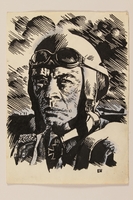
Ink portrait of a grimfaced German pilot by a Jewish soldier, 2nd Polish Corps
Object
Ink portrait of a German pilot with helmet and goggles created by 24 year old Edward Herzbaum for a Polish soldiers' magazine, "Uwaga Nadchodzi!" in 1944 while in Italy. Edward was a soldier in the 2nd Polish Corps which joined the British 8th Army for the Italian campaign in 1944. He participated in the four month long Battle of Monte Cassino, during which the 2nd Polish Corps led the mountain assault in the May 1944 victory. Edward, 19, left Łódź, Poland, shortly after Germany occupied the country in September 1939. He went to stay with family in Soviet controlled Lvov. In June 1940, Edward was arrested by Soviet security police and exiled to a forced labor camp. Germany invaded the Soviet Union in June 1941. Edward was released as part of an amnesty granted to Polish forced laborers. He headed south to join the Polish Army of the East, known as Anders Army, a volunteer unit formed by General Anders per agreement with Stalin. In August 1942, the unit left Soviet territory and became the 2nd Polish Corps in the British Army. In February 1944, they deployed to join the 8th British Army in Italy. They fought their way north and were in Italy in May 1945 when the war ended. Edward learned that his mother had died in the Łódź Ghetto in 1943. He resumed the study of architecture in Rome until the British decided to allow Polish Corps veterans to immigrate to England in October 1946. He then worked for two years for the Polish Resettlement Corps and completed his degree.

Illustration of a mortar explosion as soldiers hit the beach by a Jewish soldier, 2nd Polish Corps
Object
Ink illustration of a mortar shell exploding in the water with soldiers lying on the beach created by 24 year old Edward Herzbaum for a Polish soldiers' magazine, "Uwaga Nadchodzi!" circa 1944. It was based on the Allied offensive in Portella, Italy, on May 23, 1944. Edward was a soldier in the 2nd Polish Corps which joined the British 8th Army for the Italian campaign in 1944. He participated in the four month long Battle of Monte Cassino during which the 2nd Polish Corps led the mountain assault in the May 1944 victory. Edward, 19, left Łódź, Poland, shortly after Germany occupied the country in September 1939 to stay with family in Soviet controlled Lvov. In June 1940, he was arrested by Soviet security police and exiled to a forced labor camp. Germany invaded the Soviet Union in June 1941. Edward was released as part of an amnesty granted to Polish prisoners. He headed south to join the Polish Army of the East, known as Anders Army, a volunteer unit formed by General Anders per agreement with Stalin. In August 1942, the unit left Soviet territory and became the 2nd Polish Corps in the British Army. In February 1944, they deployed to join the 8th British Army in Italy. They fought their way north and were in Italy in May 1945 when the war ended. Edward learned that his mother had died in the Łódź Ghetto in 1943. He studied architecture in Rome until the British decided to allow Polish Corps veterans to immigrate to England in October 1946. He then worked for two years for the Polish Resettlement Corps and completed his degree.
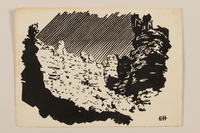
Ink drawing of mountain cliffs in Italy by a young Jewish soldier, 2nd Polish Corps
Object
Ink illustration of steep mountain cliffs in Italy created by 24 year old Edward Herzbaum for a Polish soldiers' magazine, "Uwaga Nadchodzi!" circa 1944. Edward was a soldier in the 2nd Polish Corps which joined the British 8th Army for the Italian campaign in 1944. He participated in the four month long Battle of Monte Cassino in Italy from January - May 1944, during which the 2nd Polish Corps led the mountain assault in the May 1944 victory. Edward, 19, left Łódź, Poland, shortly after Germany occupied the country in September 1939 to stay with family in Soviet controlled Lvov. In June 1940, he was arrested by Soviet security police and exiled to a forced labor camp. Germany invaded the Soviet Union in June 1941. Edward was released as part of an amnesty granted to Polish prisoners. He headed south to join the Polish Army of the East, known as Anders Army, a volunteer unit formed by General Anders per agreement with Stalin. In August 1942, the unit left Soviet territory and became the 2nd Polish Corps in the British Army. In February 1944, they deployed to join the 8th British Army in Italy. They fought their way north and were in Italy in May 1945 when the war ended. Edward learned that his mother had died in the Łódź Ghetto in 1943. He studied architecture in Rome until the British decided to allow Polish Corps veterans to immigrate to England in October 1946. He then worked for two years for the Polish Resettlement Corps and completed his degree.

Autobiographical drawing of a forced laborer at a hydroelectric plant by a young Jewish soldier, 2nd Polish Corps
Object
Illustration created by 24 year old Edward Herzbaum in Italy in 1944 of a memorable encounter he had when he was an inmate in a Soviet forced labor camp in 1941. The drawing depicts the hydroelectric plant in Szeksna (now Rybinsk, Russia) where Edward worked on a boat pump. He often went to the pier to swim. This day, August 27, 1941, he watched unseen as a young female laborer washed herself, then cried briefly, before noticing and reacting to his presence. See 2012.471.75 and.76 for other versions. It was drawn in 1943-1944 when his unit, the 2nd Polish Corps, was training with the British Army in the Middle East. Edward, 19, left Łódź, Poland, shortly after Germany occupied the country in September 1939 to stay with family in Soviet controlled Lvov. In June 1940, Edward was arrested by Soviet security police and exiled to a forced labor camp. Germany invaded the Soviet Union in June 1941. Edward was released as part of an amnesty granted to Polish prisoners. He headed south to join the Polish Army of the East, known as Anders Army. In August 1942, the unit left Soviet territory and became the 2nd Polish Corps in the British Army. In February 1944, they deployed to join the 8th British Army in the Italian Campaign. They fought their way north and were in Italy in May 1945 when the war ended. Edward learned that his mother had died in the Łódź Ghetto in 1943. He resumed the study of architecture in Rome until the British decided to allow Polish Corps veterans to immigrate to England in October 1946. He then worked for two years with the Polish Resettlement Corps and completed his degree.

Autobiographical drawing of a forced laborer at a hydroelectric plant by a young Jewish soldier, 2nd Polish Corps
Object
Illustration created by 24 year old Edward Herzbaum in Italy in 1944 of a memorable encounter he had when he was an inmate in a Soviet forced labor camp in 1941. The drawing depicts the hydroelectric plant and reservoir in Szeksna (now Rybinsk, Russia) where Edward worked on a boat pump. He often went to the pier to swim. This day, August 27, 1941, he watched unseen as a young female laborer washed herself, then cried briefly, before noticing and reacting to his presence. See 2012.471.74 and.76 for other versions. It was drawn in 1943-1944 when his unit, the 2nd Polish Corps, was training with the British Army in the Middle East. Edward, 19, left Łódź, Poland, shortly after Germany occupied the country in September 1939 to stay with family in Soviet controlled Lvov. In June 1940, Edward was arrested by Soviet security police and exiled to a forced labor camp. Germany invaded the Soviet Union in June 1941. Edward was released as part of an amnesty granted to Polish prisoners. He headed south to join the Polish Army of the East, known as Anders Army. In August 1942, the unit left Soviet territory and became the 2nd Polish Corps in the British Army. In February 1944, they deployed to join the 8th British Army in the Italian Campaign. They fought their way north and were in Italy in May 1945 when the war ended. Edward learned that his mother had died in the Łódź Ghetto in 1943. He resumed the study of architecture in Rome until the British decided to allow Polish Corps veterans to immigrate to England in October 1946. He then worked for two years with the Polish Resettlement Corps and completed his degree.
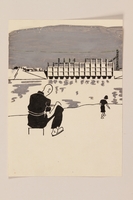
Autobiographical drawing of a forced laborer at a hydroelectric plant by a young Jewish soldier, 2nd Polish Corps
Object
Illustration drawn by 24 year old Edward Herzbaum in Italy in 1944 of a memorable encounter he had when he was an inmate in a Soviet forced labor camp in 1941. The drawing depicts the hydroelectric plant in Szeksna (now Rybinsk, Russia) where Edward worked on a boat pump. He often went to the pier to swim. This day, August 27, 1941, he watched unseen as a young female laborer washed herself, then cried briefly, before noticing and reacting to his presence. See 2012.471.74 and.75 for other versions. It was drawn in 1943-1944 when his unit, the 2nd Polish Corps, was training with the British Army in the Middle East. Edward, 19, left Łódź, Poland, shortly after Germany occupied the country in September 1939 to stay with family in Soviet controlled Lvov. In June 1940, Edward was arrested by Soviet security police and exiled to a forced labor camp. Germany invaded the Soviet Union in June 1941. Edward was released as part of an amnesty granted to Polish prisoners. He headed south to join the Polish Army of the East, known as Anders Army. In August 1942, the unit left Soviet territory and became the 2nd Polish Corps in the British Army. In February 1944, they deployed to join the 8th British Army in the Italian Campaign. They fought their way north and were in Italy in May 1945 when the war ended. Edward learned that his mother had died in the Łódź Ghetto in 1943. He resumed the study of architecture in Rome until the British decided to allow Polish Corps veterans to immigrate to England in October 1946. He then worked for two years with the Polish Resettlement Corps and completed his degree.

Drawing of a 3 donkeys with packs in the mountains created by a Jewish soldier, 2nd Polish Corps
Object
Black ink drawing of three donkeys carrying bundles of cotton created by 22 year old Edward Herzbaum depicting a February 1942 scene from Kyrgyzstan and created in Italy in 1944 for a Polish soldiers' magazine, "Uwaga Nadchodzi!." He arrived in Kyrgyzstan shortly after his release from a Soviet labor camp and his voluntary enlistment in the Polish Armed Forces of the East, later the 2nd Polish Corps, British Army. Edward, 19, left Łódź, Poland, shortly after Nazi Germany occupied the country in September 1939 to stay with family in Soviet controlled Lvov. In June 1940, he was arrested by Soviet security police and exiled to a forced labor camp. Germany invaded the Soviet Union in June 1941. Edward was released as part of an amnesty granted to Polish prisoners. He headed south to join the Polish Army of the East, know as Anders Army, a newly formed volunteer unit commanded by General Anders. In August 1942, the unit left Soviet territory and became the 2nd Polish Corps, British Army. In February 1944, they deployed to join the 8th British Army in the Italian Campaign. The unit fought its way north and was honored for bravery in the May 1944 Battle of Monte Cassino. They were in Italy in May 1945 when the war ended. Edward learned that his mother had died in the Łódź Ghetto in 1943. He studied architecture in Rome until the British decided to allow Polish Corps veterans to immigrate to England in October 1946. He then served in the Polish Resettlement Corps for two years and completed his degree.

Drawing of a donkey with pack and guide in the mountains created by a Jewish soldier, 2nd Polish Corps
Object
Black ink drawing of a donkey with a bundle of cotton and its driver created by 24 year old Edward Herzbaumn in Italy around 1944 for a Polish soldiers' magazine, "Uwaga Nadchodzi!." It is based upon his experiences in Kyrgyzstan around February 1942. He arrived there shortly after his release from a Soviet labor camp and his voluntary enlistment in the Polish Armed Forces of the East, later the 2nd Polish Corps. Edward, 19, left Łódź, Poland, shortly after Nazi Germany occupied the country in September 1939 to stay with family in Soviet controlled Lvov. In June 1940, Edward was arrested by Soviet security police and exiled to a forced labor camp. Germany invaded the Soviet Union in June 1941. Edward was released as part of an amnesty granted to Polish prisoners. He headed south to join the Polish Army of the East, know as Anders Army, a newly formed volunteer unit commanded by General Anders. In August 1942, the unit left Soviet territory and became the 2nd Polish Corps in the British Army. In February 1944, they deployed to join the 8th British Army in the Italian Campaign. They fought their way north and were honered for their bravery in the May 1944 Battle of Monte Cassino. They were in Italy in May 1945 when the war ended. Edward learned that his mother had died in the Łódź Ghetto in 1943. He resumed the study of architecture in Rome until the British decided to allow Polish Corps veterans to immigrate to England in October 1946. He then served in the Polish Resettlement Corps for two years.

Ink illustration of a British encampment by a Jewish soldier, 2nd Polish Corps
Object
Ink illustration of a few simple buildings and a truck under a black sky created by 24 year old Edward Herzbaum in 1944, possibly for the Polish soldier's magazine, "Uwaga Nadchodzi!." Edward was a soldier in the 5th Kresowa Infantry Division, 2nd Polish Corps, British Army. Edward, age 19, left Łódź, Poland, shortly after Nazi Germany occupied the country in September 1939 to stay with family in Soviet controlled Lvov. In June 1940, Edward was arrested by Soviet security police and exiled to a forced labor camp. Germany invaded the Soviet Union in June 1941. Edward was released as part an amnesty granted to Polish prisoners. He headed south to join the Polish Army of the East, known as Anders Army, a volunteer Polish military unit formed by Generals Sikorski and Anders per agreement with Stalin. In August 1942, the unit left Soviet territory and became the 2nd Polish Corps, British Army. In February 1944, they deployed to join the 8th British Army in the Italian Campaign. They fought their way north and were honored for their bravery in the May 1944 Battle of Monte Cassino. They were in Italy in May 1945 when the war ended. Edward learned that his mother had died in the Łódź Ghetto in 1943. He resumed the study of architecture in Rome until the British decided to allow Polish Corps veterans to immigrate to England in October 1946. He then served in the Polish Resettlement Corps for two years.
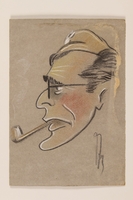
Self portrait caricature by a Jewish soldier, 2nd Polish Corps
Object
Self portrait caricature in pastel created by 25 year old Edward Herzbaum in Italy in 1945. Edward was a soldier in the 2nd Polish Corps which joined the 8th British Army in the Italian campaign in 1944. The Corps participated in the four month long Battle of Monte Cassino from January -May 1944 and led the mountain assault in the May 1944 victory, the fourth battle by Allied forces since January to break through German defenses. Edward, 19, left Łódź, Poland, shortly after Germany occupied the country in September 1939 to stay with family in Soviet controlled Lvov. In June 1940, he was arrested by Soviet security police and exiled to a forced labor camp. Germany invaded the Soviet Union in June 1941. Edward was released as part of an amnesty granted to Polish prisoners. He joined the Polish Army of the East, known as Anders Army, a volunteer unit formed by General Anders per agreement with Stalin. In August 1942, the unit left Soviet territory and became the 2nd Polish Corps, British Army. In February 1944, they deployed to join the 8th British Army in the Italian Campaign. They fought their way north and were in Italy in May 1945 when the war ended. Edward learned that his mother had died in the Łódź Ghetto in 1943. He studied architecture in Rome until the British decided to allow Polish Corps veterans to immigrate to England in October 1946. He then worked for two years with the Polish Resettlement Corps and completed his architectural degree.
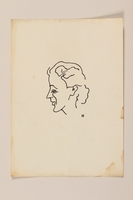
Portrait sketch in ink of a woman in left profile by a Jewish soldier, 2nd Polish Corps
Object
Line drawing of a young woman in profile created by 24 year old Edward Herzbaum in Italy in 1944. See 2012.471.82 for another version of this drawing. Edward was a soldier in the Polish Army of the East and then 5th Kresowa, 2nd Polish Corps, British Army from 1941-1945. Edward, 19, left Łódź, Poland, shortly after Germany occupied the country in September 1939 to stay with family in Soviet controlled Lvov. In June 1940, he was arrested by Soviet security police and exiled to a forced labor camp. Germany invaded the Soviet Union in June 1941. Edward was released as part of an amnesty granted to Polish prisoners. He headed south to join the Polish Army of the East, known as Anders Army, a volunteer unit formed by General Anders per agreement with Stalin. In August 1942, the unit left Soviet territory and became the 2nd Polish Corps, British Army. In February 1944, they deployed to join the 8th British Army in the Italian Campaign. The unit fought its way north and was honored for bravery in May 1944 victory in the Battle of Monte Cassino. They were in Italy in May 1945 when the war ended. Edward learned that his mother had died in the Łódź Ghetto in 1943. He studied architecture in Rome until the British decided to allow Polish Corps veterans to immigrate to England in October 1946. He then worked for two years with the Polish Resettlement Corps and completed his architectural degree.

Portrait sketch in pencil of a woman in left profile by a Jewish soldier, 2nd Polish Corps
Object
Pencil line drawing of a young woman in profile created by 24 year old Edward Herzbaum in Italy in 1944. See 2012.471.81 for another version of this drawing. Edward was a soldier in the Polish Army of the East and then the 5th Kresowa, 2nd Polish Corps, British Army from 1941-1945. Edward, 19, had left Łódź, Poland, shortly after Germany occupied the country in September 1939 to stay with family in Soviet controlled Lvov. In June 1940, he was arrested by Soviet security police and exiled to a forced labor camp. Germany invaded the Soviet Union in June 1941. Edward was released as part of an amnesty granted to Polish prisoners. He headed south to join the Polish Army of the East, known as Anders Army, a volunteer unit formed by General Anders per agreement with Stalin. In August 1942, the unit left Soviet territory and became the 2nd Polish Corps, British Army. In February 1944, they deployed to join the 8th British Army in the Italian Campaign. The unit fought its way north and was honored for bravery in May 1944 victory in the Battle of Monte Cassino. They were in Italy in May 1945 when the war ended. Edward learned that his mother had died in the Łódź Ghetto in 1943. He studied architecture in Rome until the British decided to allow Polish Corps veterans to immigrate to England in October 1946. He then worked for two years with the Polish Resettlement Corps and completed his architectural degree.

Line drawing of a woman's face by a Jewish soldier, 2nd Polish Corps
Object
Drawing that creates the face of a young woman in six pencilled lines drawn by 24 year old Edward Herzbaum in Italy in 1944. Edward was a soldier in the Polish Army of the East and then the 5th Kresowa, 2nd Polish Corps, British Army from 1941-1945. Edward, 19, had left Łódź, Poland, shortly after Germany occupied the country in September 1939 to stay with family in Soviet controlled Lvov. In June 1940, he was arrested by Soviet security police and exiled to a forced labor camp. Germany invaded the Soviet Union in June 1941. Edward was released as part of an amnesty granted to Polish prisoners. He headed south to join the Polish Army of the East, known as Anders Army, a volunteer unit formed by General Anders per agreement with Stalin. In August 1942, the unit left Soviet territory and became the 2nd Polish Corps, British Army. In February 1944, they deployed to join the 8th British Army in the Italian Campaign. The unit fought its way north and was honored for bravery in May 1944 victory in the Battle of Monte Cassino. They were in Italy in May 1945 when the war ended. Edward learned that his mother had died in the Łódź Ghetto in 1943. He studied architecture in Rome until the British decided to allow Polish Corps veterans to immigrate to England in October 1946. He then worked for two years with the Polish Resettlement Corps and completed his architectural degree.
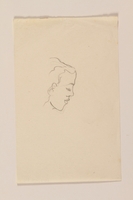
Portrait sketch in ink of a sensual woman's face in right profile by a Jewish soldier, 2nd Polish Corps
Object
Line drawing of a young woman in right profile created by 24 year old Edward Herzbaum in Italy in 1944. Edward was a soldier in the Polish Army of the East and then the 5th Kresowa, 2nd Polish Corps, British Army from 1941-1945. Edward, 19, had left Łódź, Poland, shortly after Germany occupied the country in September 1939 to stay with family in Soviet controlled Lvov. In June 1940, he was arrested by Soviet security police and exiled to a forced labor camp. Germany invaded the Soviet Union in June 1941. Edward was released as part of an amnesty granted to Polish prisoners. He headed south to join the Polish Army of the East, known as Anders Army, a volunteer unit formed by General Anders per agreement with Stalin. In August 1942, the unit left Soviet territory and became the 2nd Polish Corps, British Army. In February 1944, they deployed to join the 8th British Army in the Italian Campaign. The unit fought its way north and was honored for bravery in May 1944 victory in the Battle of Monte Cassino. They were in Italy in May 1945 when the war ended. Edward learned that his mother had died in the Łódź Ghetto in 1943. He studied architecture in Rome until the British decided to allow Polish Corps veterans to immigrate to England in October 1946. He then worked for two years with the Polish Resettlement Corps and completed his architectural degree.

Line drawing of two men looking right with amusement by a Jewish soldier, 2nd Polish Corps
Object
Pencil line drawing of two men's faces side and side in profile looking right with amused expressions created by 24 year old Edward Herzbaum in Italy in 1944. Edward was a soldier in the Polish Army of the East and then the 5th Kresowa, 2nd Polish Corps, British Army from 1941-1945. Edward, 19, had left Łódź, Poland, shortly after Germany occupied the country in September 1939 to stay with family in Soviet controlled Lvov. In June 1940, he was arrested by Soviet security police and exiled to a forced labor camp. Germany invaded the Soviet Union in June 1941. Edward was released as part of an amnesty granted to Polish prisoners. He headed south to join the Polish Army of the East, known as Anders Army, a volunteer unit formed by General Anders per agreement with Stalin. In August 1942, the unit left Soviet territory and became the 2nd Polish Corps, British Army. In February 1944, they deployed to join the 8th British Army in the Italian Campaign. The unit fought its way north and was honored for bravery in May 1944 victory in the Battle of Monte Cassino. They were in Italy in May 1945 when the war ended. Edward learned that his mother had died in the Łódź Ghetto in 1943. He studied architecture in Rome until the British decided to allow Polish Corps veterans to immigrate to England in October 1946. He then worked for two years with the Polish Resettlement Corps and completed his architectural degree.
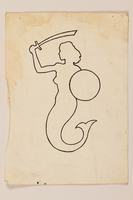
Drawing of the Warsaw Mermaid, emblem of Warsaw, and of the 2nd Polish Corps by a Jewish soldier
Object
Ink drawing of the Warsaw Mermaid, Syrenka, the coat of arms of Warsaw, also used by the 2nd Polish Corps, drawn by Edward Herzbaum. Edward was a soldier in the Polish Army of the East and then the 5th Kresowa, 2nd Polish Corps, British Army from 1941-1945. Edward, 19, had left Łódź, Poland, shortly after Germany occupied the country in September 1939 to stay with family in Soviet controlled Lvov. In June 1940, he was arrested by Soviet security police and exiled to a forced labor camp. Germany invaded the Soviet Union in June 1941. Edward was released as part of an amnesty granted to Polish prisoners. He headed south to join the Polish Army of the East, known as Anders Army, a volunteer unit formed by General Anders per agreement with Stalin. In August 1942, the unit left Soviet territory and became the 2nd Polish Corps, British Army. In February 1944, they deployed to join the 8th British Army in the Italian Campaign. The unit fought its way north and was honored for bravery in May 1944 victory in the Battle of Monte Cassino. They were in Italy in May 1945 when the war ended. Edward learned that his mother had died in the Łódź Ghetto in 1943. He studied architecture in Rome until the British decided to allow Polish Corps veterans to immigrate to England in October 1946. He then worked for two years with the Polish Resettlement Corps and completed his architectural degree.
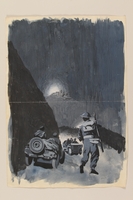
Eyewitness drawing of troops advancing near Monte Cassino by a Jewish soldier, 2nd Polish Corps
Object
Vivid black and gray illustration of Allied troops advancing toward Monte Cassino created by Edward Herzbaum, 24, on May 31, 1944. Several works created by Edward were published during the war in military produced magazines. Edward was a soldier in the 2nd Polish Corps, British Army, which was honored for bravery during the four month 1944 Battle of Monte Cassino in Italy. The Allies bombed the 1349 abbey in February and the resulting ruins provided protected defensive positions for German troops, blocking the northward progress of the Allies. The 2nd Polish Corps led the mountain assault in the May victory, the fourth battle waged to break through the German stronghold. Edward, 19, left Łódź, Poland, shortly after Germany occupied the country in September 1939 for Soviet controlled Lvov. In June 1940, he was exiled to a gulag by Soviet security police. Germany invaded the Soviet Union in June 1941. Edward was released in an amnesty of Polish prisoners. He headed south to join the Polish Army of the East, known as Anders Army. In August 1942, the unit left Soviet territory and became the 2nd Polish Corps. In February 1944, they joined the 8th British Army in Italy. They were in Italy on VE Day, May 8, 1945 when the war ended. Edward learned that his mother died in Łódź Ghetto in 1943. He studied architecture in Rome until the British decided to allow Polish Corps veterans to immigrate to England in October 1946. He then worked for two years for the Polish Resettlement Corps and completed his degree.
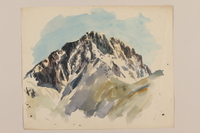
Watercolor of rocky snow covered mountains by a Jewish soldier, 2nd Polish corps
Object
Watercolor of a craggy, snow covered mountain in Castrocaro painted by Edward Herzbaum in March 1945 while a soldier in 2nd Corps, British Army. Edward, 19, left Łódź, Poland, shortly after Germany occupied the country in September 1939 for Soviet controlled Lvov. In June 1940, he was exiled to a gulag by Soviet security police. Germany invaded the Soviet Union in June 1941. Edward was released in an amnesty of Polish prisoners. He headed south to join the Polish Army of the East, known as Anders Army. In August 1942, the unit left Soviet territory and became the 2nd Polish Corps. In February 1944, they joined the 8th British Army in the Italian Campaign. The unit fought its way north and was honored for bravery in the 1944 Battle of Monte Cassino. They were in Italy on VE Day, in May 8, 1945, when the war ended. Edward learned that his mother had died in Łódź Ghetto in 1943. He studied architecture in Rome until the British decided to allow Polish Corps veterans to immigrate to England in October 1946. He then worked for two years with the Polish Resettlement Corps and completed his architectural degree.
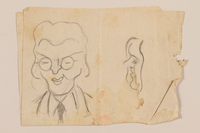
Double sided drawing with sketches of four friends by a Jewish soldier, 2nd Polish corps
Object
Quicly drawn sketches on both sides of folded papaer: a man and woman on one side; two men on the reverse, drawn by Edward Herzbaum circa 1944-1945. Edward was a soldier in the Polish Army of the East and then the 5th Kresowa, 2nd Polish Corps, British Army from 1941-1945. Edward, 19, had left Łódź, Poland, shortly after Germany occupied the country in September 1939 to stay with family in Soviet controlled Lvov. In June 1940, he was arrested by Soviet security police and exiled to a forced labor camp. Germany invaded the Soviet Union in June 1941. Edward was released as part of an amnesty granted to Polish prisoners. He headed south to join the Polish Army of the East, known as Anders Army, a volunteer unit formed by General Anders per agreement with Stalin. In August 1942, the unit left Soviet territory and became the 2nd Polish Corps, British Army. In February 1944, they deployed to join the 8th British Army in the Italian Campaign. The unit fought its way north and was honored for bravery in May 1944 victory in the Battle of Monte Cassino. They were in Italy in May 1945 when the war ended. Edward learned that his mother had died in the Łódź Ghetto in 1943. He studied architecture in Rome until the British decided to allow Polish Corps veterans to immigrate to England in October 1946. He then worked for two years with the Polish Resettlement Corps and completed his architectural degree.

Muted watercolor of two trees in a green, overgrown field by a Jewish soldier, 2nd Polish corps
Object
Impressionistic watercolor of two scraggly, bare trees in a brown and green field near Castrocaro, a small spa town near Bologna, Italy. It was painted by Edward Herzbaum in March 1945 while his unit of the 2nd Polish Corps advanced through Italy during the war. Edward, 19, left Łódź, Poland, shortly after Nazi Germany occupied the country in September 1939 to stay with family in Soviet controlled Lvov. In June 1940, Edward was arrested by Soviet security police and exiled to a forced labor camp. Germany invaded the Soviet Union in June 1941. Edward was released as part of an amnesty granted to Polish prisoners. He headed south to join the Polish Army of the East, known as Anders Army, a volunteer Polish military unit formed by Generals Sikorski and Anders per agreement with Stalin. In August 1942, the unit left Soviet territory and became the 2nd Polish Corps in the British Army. In February 1944, they deployed to join the British 8th Army in the Italian Campaign. The Corps fought its way north and was honored for its heroic service in the May 1944 Battle of Monte Cassino. They were in Italy on VE Day, May 8, 1945, when the war ended. Edward learned that his mother had died in the Łódź Ghetto in 1943. He studied architecture in Rome until the British decided to allow Polish Corps veterans to immigrate to England in October 1946. He then served in the Polish Resettlement Corps for two years and completed his degree.
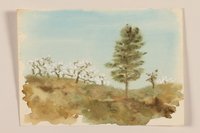
Impressionistic watercolor of a tall green tree near a field of white blossomed trees painted by a Jewish soldier, 2nd Polish corps
Object
Muted, pastel hued watercolor depicting a tall, green bushy tree near a small orchard of white flowering trees near Castrocaro, a small spa town near Bologna, Italy. It was painted by Edward Herzbaum in March 1945 while his unit of the 2nd Polish Corps advanced through Italy during the war. Edward was a soldier in the 2nd Polish Corps from 1941-1945. Edward, 19, left Łódź, Poland, shortly after Nazi Germany occupied the country in September 1939 to stay with family in Soviet controlled Lvov. In June 1940, Edward was arrested by Soviet security police and exiled to a forced labor camp. Germany invaded the Soviet Union in June 1941. Edward was released as part of an amnesty granted to Polish prisoners. He headed south to join the Polish Army of the East, known as Anders Army, a volunteer Polish military unit formed by General Anders per agreement with Stalin. In August 1942, the unit left Soviet territory and became the 2nd Polish Corps in the British Army. In February 1944, they deployed to join the British 8th Army in the Italian Campaign. The Corps fought its way north and was honored for bravery in the May 1944 Battle of Monte Cassino. They were in Italy on VE Day, May 8, 1945, when the war ended. Edward learned that his mother had died in the Łódź Ghetto in 1943. He studied architecture in Rome until the British decided to allow Polish Corps veterans to immigrate to England in October 1946. He then served in the Polish Resettlement Corps for two years and completed his degree.
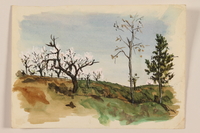
Watercolor of three trees on an Italian hillside by a Jewish soldier, 2nd Polish corps
Object
Watercolor of three trees in a rolling, barren landscape near Castrocaro, a small spa town near Bologna, Italy. It was painted by Edward Herzbaum in March 1945 while his unit of the 2nd Polish Corps advanced through Italy during the war. Edward was a soldier in the 2nd Polish Corps from 1941-1945. Edward, 19, left Łódź, Poland, shortly after Nazi Germany occupied the country in September 1939 to stay with family in Soviet controlled Lvov. In June 1940, Edward was arrested by Soviet security police and exiled to a forced labor camp. Germany invaded the Soviet Union in June 1941. He was released as part of an amnesty granted to Polish prisoners. He headed south to join the Polish Army of the East, known as Anders Army, a volunteer Polish military unit formed by General Anders per agreement with Stalin. In August 1942, the unit left Soviet territory and became the 2nd Polish Corps in the British Army. In February 1944, they deployed to join the British 8th Army in the Italian Campaign. The Corps fought its way north and was honored for bravery in the May 1944 Battle of Monte Cassino. They were in Italy on VE Day, May 8, 1945, when the war ended. Edward learned that his mother had died in the Łódź Ghetto in 1943. He studied architecture in Rome until the British decided to allow Polish Corps veterans to immigrate to England in October 1946. He then served in the Polish Resettlement Corps for two years and completed his degree.

Watercolor of two haystacks and a pink flowering tree by a Jewish soldier, 2nd Polish corps
Object
Watercolor of two tall haystacks with a pink flowered tree near Castrocaro, a small spa town near Bologna, Italy. It was painted by Edward Herzbaum in March 1945 while his unit of the 2nd Polish Corps, the 5th Kresowa, advanced through Italy during the war. Edward, 19, left Łódź, Poland, shortly after Nazi Germany occupied the country in September 1939 to stay with family in Soviet controlled Lvov. In June 1940, he was arrested by Soviet security police and exiled to a forced labor camp. Germany invaded the Soviet Union in June 1941. Edward was released as part of an amnesty granted to Polish prisoners. He headed south to join the Polish Army of the East, known as Anders Army, a volunteer Polish military unit formed by General Anders per agreement with Stalin. In August 1942, the unit left Soviet territory and became the 2nd Polish Corps, British Army. In February 1944, they deployed to join the British 8th Army in the Italian Campaign. The Corps fought its way north and was honored for bravery in the May 1944 Battle of Monte Cassino. They were in Italy on VE Day, May 8, 1945, when the war ended. Edward learned that his mother had died in the Łódź Ghetto in 1943. He studied architecture in Rome until the British decided to allow Polish Corps veterans to immigrate to England in October 1946. He then served in the Polish Resettlement Corps for two years and completed his degree.
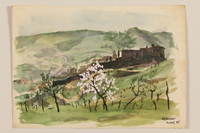
Watercolor of a white flowering tree at the foot of a hill by a Jewish soldier, 2nd Polish corps
Object
Watercolor of a large white flowering tree at the foot of a hill near Castrocaro, a small spa town near Bologna, Italy. It was painted by Edward Herzbaum in March 1945 while his unit of the 2nd Polish Corps, the 5th Kresowa, advanced through Italy during the war. Edward, 19, left Łódź, Poland, shortly after Nazi Germany occupied the country in September 1939 to stay with family in Soviet controlled Lvov. In June 1940, he was arrested by Soviet security police and exiled to a forced labor camp. Germany invaded the Soviet Union in June 1941. Edward was released as part of an amnesty granted to Polish prisoners. He headed south to join the Polish Army of the East, known as Anders Army, a volunteer Polish military unit formed by General Anders per agreement with Stalin. In August 1942, the unit left Soviet territory and became the 2nd Polish Corps,British Army. In February 1944, they deployed to join the British 8th Army in the Italian Campaign. The Corps fought their way north and was honored for its heroic service in the May 1944 Battle of Monte Cassino. They were in Italy on May 8, 1945, when the war ended. Edward learned that his mother had died in the Łódź Ghetto in 1943. He studied architecture in Rome until the British decided to allow Polish Corps veterans to immigrate to England in October 1946. He then served in the Polish Resettlement Corps for two years and completed his degree.
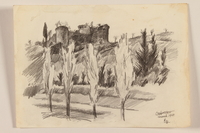
Pencil sketch of four Italian cypresses and a nearby castle by a Jewish soldier, 2nd Polish corps
Object
Pencil drawing in diagonal parallel strokes of three cypress trees at the foot of a hill with a fortress near Castrocaro, a small spa town near Bologna, Italy. It was drawn by Edward Herzbaum in March 1945 while his unit of the 2nd Polish Corps, the 5th Kresowa, advanced through Italy during the war. See 2012.471.102 for another view of this scene. Edward, 19, left Łódź, Poland, shortly after Nazi Germany occupied the country in September 1939 to stay with family in Soviet controlled Lvov. In June 1940, he was arrested by Soviet security police and exiled to a forced labor camp. Germany invaded the Soviet Union in June 1941. He was released as part of an amnesty granted to Polish prisoners. He headed south to join the Polish Army of the East, known as Anders Army, a volunteer Polish military unit formed by General Anders per agreement with Stalin. In August 1942, the unit left Soviet territory and became the 2nd Polish Corps in the British Army. In February 1944, they deployed to join the British 8th Army in the Italian Campaign. The Corps fought their way north and was honored for its heroic service in the May 1944 Battle of Monte Cassino. They were in Italy on May 8, 1945, when the war ended. Edward learned that his mother had died in the Łódź Ghetto in 1943. He studied architecture in Rome until the British decided to allow Polish Corps veterans to immigrate to England in October 1946. He then served in the Polish Resettlement Corps for two years and completed his degree.
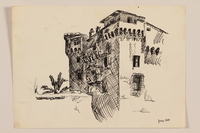
Drawing of a castle with palm trees created by a Jewish soldier, 2nd Polish corps
Object
Drawing of a villa near San Severo, Italy, created by Edward Herzbaum in June 1945 when he traveled around Italy after the war before studying architecture in Rome. During World War II, Edward served in the Polish Army of the East, which became the Second Polish Corps, British Army. See 2012.471.97, 100, and 101 for other versions of this palace. Edward, 19, left Łódź, Poland, shortly after Nazi Germany occupied the country in September 1939 to stay with family in Soviet controlled Lvov. In June 1940, he was arrested by Soviet security police and exiled to a forced labor camp. Germany invaded the Soviet Union in June 1941. Edward was released as part of an amnesty granted to Polish prisoners. He headed south to join the Polish Army of the East, known as Anders Army, a volunteer Polish military unit formed by General Anders per agreement with Stalin. In August 1942, the unit left Soviet territory and became the 2nd Polish Corps, British Army. In February 1944, they deployed to join the British 8th Army in the Italian Campaign. The Corps fought its way north and was honored for bravery in the May 1944 Battle of Monte Cassino. They were in Italy on VE Day, May 8, 1945, when the war ended. Edward learned that his mother had died in the Łódź Ghetto in 1943. He studied architecture in Rome until the British decided to allow Polish Corps veterans to immigrate to England in October 1946. He then served in the Polish Resettlement Corps for two years and completed his degree.

Watercolor of a palace along a rocky shore created by a Jewish soldier, 2nd Polish corps
Object
Impressionistic watercolor of a castle on a rocky shoreline in San Severo, Italy, created by Edward Herzbaum in June 1945 when he traveled around Italy after the war before studying architecture in Rome. During World War II, Edward served in the Polish Army of the East, which became the Second Polish Corps, British Army. See 2012.471.97, 100, and 101 for other versions of this palace. Edward, 19, left Łódź, Poland, shortly after Nazi Germany occupied the country in September 1939 to stay with family in Soviet controlled Lvov. In June 1940, he was arrested by Soviet security police and exiled to a forced labor camp. Germany invaded the Soviet Union in June 1941. Edward was released as part of an amnesty granted to Polish prisoners. He headed south to join the Polish Army of the East, known as Anders Army, a volunteer Polish military unit formed by General Anders per agreement with Stalin. In August 1942, the unit left Soviet territory and became the 2nd Polish Corps, British Army. In February 1944, they deployed to join the British 8th Army in the Italian Campaign. The Corps fought its way north and was honored for bravery in the May 1944 Battle of Monte Cassino. They were in Italy on VE Day, May 8, 1945, when the war ended. Edward learned that his mother had died in the Łódź Ghetto in 1943. He studied architecture in Rome until the British decided to allow Polish Corps veterans to immigrate to England in October 1946. He then served in the Polish Resettlement Corps for two years and completed his degree.
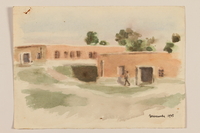
Watercolor of two single story buildings by a Jewish soldier, 2nd Polish corps
Object
Watercolor of a man walking past two buildings in Macerata, a hilltop city in central Italy, painted by Edward Herzbaum circa June 1945 when he traveled around Italy after the war before studying architecture in Rome. During World War II, Edward served in the Polish Army of the East, which became the Second Polish Corps, British Army. Edward, 19, left Łódź, Poland, shortly after Nazi Germany occupied the country in September 1939 to stay with family in Soviet controlled Lvov. In June 1940, he was arrested by Soviet security police and exiled to a forced labor camp. Germany invaded the Soviet Union in June 1941. Edward was released as part of an amnesty granted to Polish prisoners. He headed south to join the Polish Army of the East, known as Anders Army, a volunteer Polish military unit formed by General Anders per agreement with Stalin. In August 1942, the unit left Soviet territory and became the 2nd Polish Corps, British Army. In February 1944, they deployed to join the British 8th Army in the Italian Campaign. The Corps fought its way north and was honored for bravery in the May 1944 Battle of Monte Cassino. They were in Italy on VE Day, May 8, 1945, when the war ended. Edward learned that his mother had died in the Łódź Ghetto in 1943. He studied architecture in Rome until the British decided to allow Polish Corps veterans to immigrate to England in October 1946. He then served in the Polish Resettlement Corps for two years and completed his degree.

Watercolor with a distant view of a hilltop town framed by foliage by a Jewish soldier, 2nd Polish corps
Object
Watercolor with green tree tops framing a faraway view of Macerata, a hilltop city in central Italy. It was painted by by Edward Herzbaum circa June 1945 when he traveled around Italy after the war before studying architecture in Rome. During World War II, Edward served in the Polish Army of the East, which became the Second Polish Corps, British Army. Edward, 19, left Łódź, Poland, shortly after Nazi Germany occupied the country in September 1939 to stay with family in Soviet controlled Lvov. In June 1940, he was arrested by Soviet security police and exiled to a forced labor camp. Germany invaded the Soviet Union in June 1941. Edward was released as part of an amnesty granted to Polish prisoners. He headed south to join the Polish Army of the East, known as Anders Army, a volunteer Polish military unit formed by General Anders per agreement with Stalin. In August 1942, the unit left Soviet territory and became the 2nd Polish Corps, British Army. In February 1944, they deployed to join the British 8th Army in the Italian Campaign. The Corps fought its way north and was honored for bravery in the May 1944 Battle of Monte Cassino. They were in Italy on VE Day, May 8, 1945, when the war ended. Edward learned that his mother had died in the Łódź Ghetto in 1943. He studied architecture in Rome until the British decided to allow Polish Corps veterans to immigrate to England in October 1946. He then served in the Polish Resettlement Corps for two years and completed his degree.

Muted watercolor of an Italian castle seen from offshore created by a Jewish soldier, 2nd Polish corps
Object
Impressionistic watercolor of a castle on the shoreline near San Severo, Italy, created by Edward Herzbaum in June 1945 when he traveled around Italy after the war before studying architecture in Rome. During World War II, Edward served in the Polish Army of the East, which became the Second Polish Corps, British Army. See 2012.471.96, .97, and 101 for other versions of this palace. Edward, 19, left Łódź, Poland, shortly after Nazi Germany occupied the country in September 1939 to stay with family in Soviet controlled Lvov. In June 1940, Edward was arrested by Soviet security police and exiled to a forced labor camp. Germany invaded the Soviet Union in June 1941. Edward was released as part of an amnesty granted to Polish prisoners. He headed south to join the Polish Army of the East, known as Anders Army, a volunteer Polish military unit formed by General Anders per agreement with Stalin. In August 1942, the unit left Soviet territory and became the 2nd Polish Corps in the British Army. In February 1944, they deployed to join the British 8th Army in the Italian Campaign. The Corps fought its way north and was honored for bravery in the May 1944 Battle of Monte Cassino. They were in Italy on VE Day, May 8, 1945, when the war ended. Edward learned that his mother had died in the Łódź Ghetto in 1943. He studied architecture in Rome until the British decided to allow Polish Corps veterans to immigrate to England in October 1946. He then served in the Polish Resettlement Corps for two years and completed his degree.

Watercolor study of a seaside castle created by a Jewish soldier, 2nd Polish corps
Object
Exterior view of a castle near the sea in San Severo, Italy, created by Edward Herzbaum in June 1945 when he traveled around Italy after the war before studying architecture in Rome. During World War II, Edward served in the Polish Army of the East, which became the Second Polish Corps, British Army. See 2012.471.96, .97, and 101 for other versions of this palace. Edward, 19, left Łódź, Poland, shortly after Nazi Germany occupied the country in September 1939 to stay with family in Soviet controlled Lvov. In June 1940, Edward was arrested by Soviet security police and exiled to a forced labor camp. Germany invaded the Soviet Union in June 1941. Edward was released as part of an amnesty granted to Polish prisoners. He headed south to join the Polish Army of the East, known as Anders Army, a volunteer Polish military unit formed by General Anders per agreement with Stalin. In August 1942, the unit left Soviet territory and became the 2nd Polish Corps in the British Army. In February 1944, they deployed to join the British 8th Army in the Italian Campaign. The Corps fought its way north and was honored for bravery in the May 1944 Battle of Monte Cassino. They were in Italy on VE Day, May 8, 1945, when the war ended. Edward learned that his mother had died in the Łódź Ghetto in 1943. He studied architecture in Rome until the British decided to allow Polish Corps veterans to immigrate to England in October 1946. He then served in the Polish Resettlement Corps for two years and completed his degree.
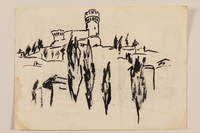
Ink drawing of a hilltop castle created by a Jewish soldier, 2nd Polish corps
Object
Contour ink drawing of a castle with a tower near Castrocaro, a small spa town near Bologna, Italy. It was drawn by Edward Herzbaum in March 1945 while his unit of the 2nd Polish Corps advanced through Italy during the war. See 2012.471.95 for another view of this scene. Edward, 19, left Łódź, Poland, shortly after Nazi Germany occupied the country in September 1939 to stay with family in Soviet controlled Lvov. In June 1940, he was arrested by Soviet security police and exiled to a forced labor camp. Germany invaded the Soviet Union in June 1941. Edward was released as part of an amnesty granted to Polish prisoners. He headed south to join the Polish Army of the East, known as Anders Army, a volunteer Polish military unit formed by General Anders per agreement with Stalin. In August 1942, the unit left Soviet territory and became the 2nd Polish Corps, British Army. In February 1944, they deployed to join the British 8th Army in the Italian Campaign. The Corps fought its way north and was honored for bravery in the May 1944 Battle of Monte Cassino. They were in Italy on VE Day, May 8, 1945, when the war ended. Edward learned that his mother had died in the Łódź Ghetto in 1943. He studied architecture in Rome until the British decided to allow Polish Corps veterans to immigrate to England in October 1946. He then served in the Polish Resettlement Corps for two years and completed his degree.
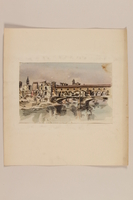
Watercolor of the Ponte Vecchio, Florence by a Jewish soldier, 2nd Polish Corps
Object
Watercolor of the Ponte Vecchio in Florence, Italy, created by Edward Herzbaum in 1945-1946 when he was studying architecture in Rome after war service as a soldier in the 2nd Polish Corps, British Army, from 1942-1945. When Edward was 19, he left Łódź, Poland, shortly after Nazi Germany occupied the country in September 1939 for Soviet controlled Lvov. In June 1940, Edward was exiled to a gulag by Soviet security police. Germany invaded the Soviet Union in June 1941. Edward was released in an amnesty of Polish prisoners. He joined the Polish Army of the East, known as Anders Army. In August 1942, the unit left Soviet territory and became the 2nd Polish Corps, British Army. In February 1944, they joined the British 8th Army in Italy. The Corps fought its way north and was honored for heroism in the Battle of Monte Cassino. They celebrated VE Day, May 8, 1945, in Italy. Edward learned that his mother died in Łódź Ghetto in 1943. He studied architecture in Rome until the British decided to allow Polish Corps veterans to immigrate to England in October 1946. He then served in the Polish Resettlement Corps for two years, completed his degree, and eventually set up his own architecture firm.

Pastel drawing of the Ponte Vecchio, Florence by a Jewish soldier, 2nd Polish Corps
Object
Pastel study of the Ponte Vecchio in Florence, Italy, created by Edward Herzbaum in 1945-1946 when he was studying architecture in Rome after war service as a soldier in the 2nd Polish Corps, British Army, from 1942-1945. When Edward was 19, he left Łódź, Poland, shortly after Nazi Germany occupied the country in September 1939 for Soviet controlled Lvov. In June 1940, Edward was exiled to a gulag by Soviet security police. Germany invaded the Soviet Union in June 1941. Edward was released in an amnesty of Polish prisoners. He joined the Polish Army of the East, known as Anders Army. In August 1942, the unit left Soviet territory and became the 2nd Polish Corps, British Army. In February 1944, they joined the British 8th Army in Italy. The Corps fought its way north and was honored for heroism in the Battle of Monte Cassino. They celebrated VE Day, May 8, 1945, in Italy. Edward learned that his mother died in Łódź Ghetto in 1943. He studied architecture in Rome until the British decided to allow Polish Corps veterans to immigrate to England in October 1946. He then served in the Polish Resettlement Corps for two years, completed his degree, and eventually set up his own architecture firm.

Architectural study of the facade of the Castle Nuovo by a Jewish soldier, 2nd Polish Corps
Object
Pencil drawing of the Arch of Aragon, the triumphal arch at the Castle Nuovo, or Maschio Angioino, a medieval castle in Naples, Italy. created by Edward Herzbaum on October 29, 1946, during the voyage from Italy to England with other veterans of the 2nd Polish Corps. The Corps, a unit of the British Army, was in Italy when the war ended May 7, 1945. In October 1946, the British government finally granted the veterans permission to immigrate to England. Edward served as a soldier in the 5th Kresowa Infantry Division. Edward, age 19, left Łódź, Poland, shortly after Nazi Germany occupied the country in September 1939 to stay with family in Soviet controlled Lvov. In June 1940, he was arrested by Soviet security police and exiled to a forced labor camp. Germany invaded the Soviet Union in June 1941. Edward was released as part an amnesty granted to Polish prisoners. He headed south to join the Polish Army of the East, known as Anders Army, a volunteer Polish military unit formed by General Anders per agreement with Stalin. In August 1942, the unit left Soviet territory and became the 2nd Polish Corps, British Army. In February 1944, they deployed to join the 8th British Army in the Italian Campaign. The unit fought its their way north and was honored for bravery in the May 1944 Battle of Monte Cassino. Edward learned that his mother had died in the Łódź Ghetto in 1943. After the war, he studied architecture in Rome until the British decided to allow Polish Corps veterans to immigrate to England in October 1946. He then served in the Polish Resettlement Corps for two years.

Architectural study of the Arch of Aragon, Castle Nuovo by a Jewish soldier, 2nd Polish Corps
Object
Pencil drawing of the Arch of Aragon, the triumphal arch at the Castle Nuovo, or Maschio Angioino, a medieval castle in Naples, Italy. It was created by Edward Herzbaum on October 30, 1946, during the voyage from Italy to England with other veterans of the 2nd Polish Corps. The Corps, a unit of the British Army, was in Italy when the war ended May 7, 1945. In October 1946, the British government finally granted the veterans permission to immigrate to England. Edward had served as a soldier in the Polish Army of the East, which became the 2nd Polish Corps,in the 5th Kresowa Infantry Division. Edward, at age 19, left Łódź, Poland, shortly after Nazi Germany occupied the country in September 1939 to stay with family in Soviet controlled Lvov. In June 1940, he was arrested by Soviet security police and exiled to a forced labor camp. Germany invaded the Soviet Union in June 1941. Edward was released as part an amnesty granted to Polish prisoners. He headed south to join the Polish Army of the East, known as Anders Army, a volunteer Polish military unit formed by General Anders per agreement with Stalin. In August 1942, the unit left Soviet territory and became the 2nd Polish Corps, British Army. In February 1944, they deployed to join the 8th British Army in the Italian Campaign. The Corps fought its way north and was honored for heroism in the May 1944 Battle of Monte Cassino. Edward learned that his mother had died in the Łódź Ghetto in 1943. After the war, he studied architecture in Rome until Polish Corps veterans were able to immigrate to England in October 1946. He then served in the Polish Resettlement Corps for two years and completed his degree.

Pencil drawing of the city of Naples coastline by a Jewish soldier, 2nd Polish Corps
Object
Pencil drawing of the harbor and port terminus building at Naples, Italy, created by Edward Herzbaum on October 30, 1946, during the voyage from Italy to England with other veterans of the 2nd Polish Corps. The Corps, a unit of the British Army, was in Italy when the war ended May 7, 1945. In October 1946, the British government finally granted the veterans permission to immigrate to England. Edward had served as a soldier in the Polish Army of the East, which became the 2nd Polish Corps,in the 5th Kresowa Infantry Division. Edward, at age 19, left Łódź, Poland, shortly after Nazi Germany occupied the country in September 1939 to stay with family in Soviet controlled Lvov. In June 1940, he was arrested by Soviet security police and exiled to a forced labor camp. Germany invaded the Soviet Union in June 1941. Edward was released as part an amnesty granted to Polish prisoners. He headed south to join the Polish Army of the East, known as Anders Army, a volunteer Polish military unit formed by General Anders per agreement with Stalin. In August 1942, the unit left Soviet territory and became the 2nd Polish Corps, British Army. In February 1944, they deployed to join the 8th British Army in the Italian Campaign. The Corps fought its way north and was honored for heroism in the May 1944 Battle of Monte Cassino. Edward learned that his mother had died in the Łódź Ghetto in 1943. After the war, he studied architecture in Rome until Polish Corps veterans were able to immigrate to England in October 1946. He then served in the Polish Resettlement Corps for two years and completed his degree.

Pencil drawing of a ship hoist and the harbor by a Jewish soldier, 2nd Polish Corps
Object
Close-up view of a ship hoist framing a view of the busy Naples port in the background created by Edward Herzbaum on October 31, 1946, during the voyage from Italy to England with other veterans of the 2nd Polish Corps. The Corps, a unit of the British Army, was in Italy when the war ended May 7, 1945. In October 1946, the British government finally granted the veterans permission to immigrate to England. Edward had served as a soldier in the Polish Army of the East, which became the 2nd Polish Corps,in the 5th Kresowa Infantry Division. Edward, at age 19, left Łódź, Poland, shortly after Nazi Germany occupied the country in September 1939 to stay with family in Soviet controlled Lvov. In June 1940, he was arrested by Soviet security police and exiled to a forced labor camp. Germany invaded the Soviet Union in June 1941. Edward was released as part an amnesty granted to Polish prisoners. He headed south to join the Polish Army of the East, known as Anders Army, a volunteer Polish military unit formed by General Anders per agreement with Stalin. In August 1942, the unit left Soviet territory and became the 2nd Polish Corps, British Army. In February 1944, they deployed to join the 8th British Army in the Italian Campaign. The Corps fought its way north and was honored for heroism in the May 1944 Battle of Monte Cassino. Edward learned that his mother had died in the Łódź Ghetto in 1943. After the war, he studied architecture in Rome until Polish Corps veterans were able to immigrate to England in October 1946. He then served in the Polish Resettlement Corps for two years and completed his degree.

Pencil drawing of a man at a ship's rail with Mt. Vesuvius in the distance by a Jewish soldier, 2nd Polish Corps
Object
Pencil drawing of a man standing at a ship's rail with a view of ships and Mount Vesuvius in the distance created by 26 year old Edward Herzbaum on October 31, 1946, during the voyage from Italy to England with other veterans of the 2nd Polish Corps. The Corps, a unit of the British Army, was in Italy when the war ended May 7, 1945. In October 1946, the British government finally granted the veterans permission to immigrate to England. Edward had served as a soldier in the Polish Army of the East, which became the 2nd Polish Corps,in the 5th Kresowa Infantry Division. Edward, at age 19, left Łódź, Poland, shortly after Nazi Germany occupied the country in September 1939 to stay with family in Soviet controlled Lvov. In June 1940, he was arrested by Soviet security police and exiled to a forced labor camp. Germany invaded the Soviet Union in June 1941. Edward was released as part an amnesty granted to Polish prisoners. He headed south to join the Polish Army of the East, known as Anders Army, a volunteer Polish military unit formed by General Anders per agreement with Stalin. In August 1942, the unit left Soviet territory and became the 2nd Polish Corps, British Army. In February 1944, they deployed to join the 8th British Army in the Italian Campaign. The Corps fought its way north and was honored for heroism in the May 1944 Battle of Monte Cassino. Edward learned that his mother had died in the Łódź Ghetto in 1943. After the war, he studied architecture in Rome until Polish Corps veterans were able to immigrate to England in October 1946. He then served in the Polish Resettlement Corps for two years and completed his degree.

Pencil drawing of a soldier napping on board a ship by a Jewish soldier, 2nd Polish Corps
Object
Pencil drawing of a man sleeping on board a transport ship created by 26 year old Edward Herzbaum on November 1, 1946, during the voyage from Italy to England with other veterans of the 2nd Polish Corps. The Corps, a unit of the British Army, was in Italy when the war ended May 7, 1945. In October 1946, the British government finally granted the veterans permission to immigrate to England. Edward had served as a soldier in the 5th Kresowa Infantry Division. Edward, age 19, left Łódź, Poland, shortly after Nazi Germany occupied the country in September 1939 to stay with family in Soviet controlled Lvov. In June 1940, he was arrested by Soviet security police and exiled to a forced labor camp. Germany invaded the Soviet Union in June 1941. Edward was released as part an amnesty granted to Polish prisoners. He headed south to join the Polish Army of the East, known as Anders Army, a volunteer Polish military unit formed by General Anders per agreement with Stalin. In August 1942, the unit left Soviet territory and became the 2nd Polish Corps, British Army. In February 1944, they deployed to join the 8th British Army in the Italian Campaign. The unit fought its way north and was honored for heroism in the May 1944 Battle of Monte Cassino. Edward learned that his mother had died in the Łódź Ghetto in 1943. After the war, he studied architecture in Rome until the British decided to allow Polish Corps veterans to immigrate to England where he served in the Polish Resettlement Corps for two years and completed his degree.

Pencil drawing of four uniformed soldiers smoking on a ship deck by a Jewish soldier, 2nd Polish Corps
Object
Pencil drawing of a four uniformed soldiers gathered on a ship deck with a lifeboat suspended overhead created by 26 year old Edward Herzbaum on November 1, 1946, during the voyage from Italy to England with other veterans of the 2nd Polish Corps. The Corps, a unit of the British Army, was in Italy when the war ended May 7, 1945. In October 1946, the British government finally granted the veterans permission to immigrate to England. Edward had served as a soldier in the 5th Kresowa Infantry Division. Edward, age 19, left Łódź, Poland, shortly after Nazi Germany occupied the country in September 1939 to stay with family in Soviet controlled Lvov. In June 1940, he was arrested by Soviet security police and exiled to a forced labor camp. Germany invaded the Soviet Union in June 1941. Edward was released as part an amnesty granted to Polish prisoners. He headed south to join the Polish Army of the East, known as Anders Army, a volunteer Polish military unit formed by General Anders per agreement with Stalin. In August 1942, the unit left Soviet territory and became the 2nd Polish Corps, British Army. In February 1944, they deployed to join the 8th British Army in the Italian Campaign. The unit fought its way north and was honored for heroism in the May 1944 Battle of Monte Cassino. Edward learned that his mother had died in the Łódź Ghetto in 1943. After the war, he studied architecture in Rome until the British decided to allow Polish Corps veterans to immigrate to England where he served in the Polish Resettlement Corps for two years and completed his degree.

Pencil drawing of soldiers sitting on a ship deck with the Rock of Gibraltar behind them by a Jewish veteran, 2nd Polish Corps
Object
Pencil sketch of ten uniformed men sitting on the ship deck with a view of Gibraltar behind them drawn by 26 year old Edward Herzbaum on November 3, 1946, during the voyage from Italy to England with other veterans of the 2nd Polish Corps. The Corps, a unit of the British Army, was in Italy when the war ended May 7, 1945. In October 1946, the British government finally granted the veterans permission to immigrate to England. Edward had served as a soldier in the 5th Kresowa Infantry Division. Edward, age 19, left Łódź, Poland, shortly after Nazi Germany occupied the country in September 1939 to stay with family in Soviet controlled Lvov. In June 1940, he was arrested by Soviet security police and exiled to a forced labor camp. Germany invaded the Soviet Union in June 1941. Edward was released as part an amnesty granted to Polish prisoners. He headed south to join the Polish Army of the East, known as Anders Army, a volunteer Polish military unit formed by General Anders per agreement with Stalin. In August 1942, the unit left Soviet territory and became the 2nd Polish Corps, British Army. In February 1944, they deployed to join the 8th British Army in the Italian Campaign. The unit fought its way north and was honored for heroism in the May 1944 Battle of Monte Cassino. Edward learned that his mother had died in the Łódź Ghetto in 1943. After the war, he studied architecture in Rome until the British decided to allow Polish Corps veterans to immigrate to England where he served in the Polish Resettlement Corps for two years and completed his degree.
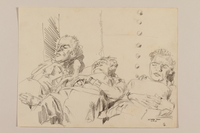
Pencil portrait of three soldiers sleeping on a ship deck by a Jewish veteran, 2nd Polish Corps
Object
Pencil drawing of three uniformed soldiers sleeping on board the SS Marine Raven created by Edward Herzbaum on November 4, 1946, during the voyage from Italy to England with other veterans of the 2nd Polish Corps. The Corps, a unit of the British Army, was in Italy when the war ended May 7, 1945. In October 1946, the British government finally granted the veterans permission to immigrate to England. Edward served as a soldier in the 5th Kresowa Infantry Division. Edward, age 19, left Łódź, Poland, shortly after Nazi Germany occupied the country in September 1939 to stay with family in Soviet controlled Lvov. In June 1940, he was arrested by Soviet security police and exiled to a forced labor camp. Germany invaded the Soviet Union in June 1941. Edward was released as part an amnesty granted to Polish prisoners. He headed south to join the Polish Army of the East, known as Anders Army, a volunteer Polish military unit. In August 1942, the Army left Soviet territory and became the 2nd Polish Corps, British Army. In February 1944, they deployed to join the 8th British Army in the Italian Campaign. They fought their way north and were honored for their bravery in the May 1944 Battle of Monte Cassino. Edward learned that his mother had died in the Łódź Ghetto in 1943. After the war, he resumed the study of architecture in Rome until leaving for England in October 1946. He then served in the Polish Resettlement Corps for two years and completed his degree.

Self-portrait in uniform and beret with pipe created by a young Jewish soldier, 2nd Polish Corps
Object
Pen and ink wash self-portrait with two images recalling wartime memories drawn by 25 year old Edward Herzbaum in 1946. Edward was a soldier in the 2nd Polish Corps, British Army, from 1941-1945. Edward, 19, left Łódź, Poland, shortly after Nazi Germany occupied the country in September 1939 to stay with family in Soviet controlled Lvov. In June 1940, Edward was arrested by Soviet security police and exiled to a forced labor camp. Germany invaded the Soviet Union in June 1941. Edward was released as part of an amnesty granted to Polish prisoners. He headed south to join the Polish Army of the East, known as Anders Army, a volunteer Polish military unit formed by General Anders per agreement with Stalin. In August 1942, the unit left Soviet territory and became the 2nd Polish Corps in the British Army. In February 1944, they deployed to join the British 8th Army in the Italian Campaign. The Corps fought its way north and was honored for its heroism in the May 1944 Battle of Monte Cassino. They were in Italy on VE Day, May 8, 1945, when the war ended. Edward learned that his mother had died in the Łódź Ghetto in 1943. He studied architecture in Rome until the British decided to allow Polish Corps veterans to immigrate to England in October 1946. He then served in the Polish Resettlement Corps for two years and completed his degree.

Sketchbook with studies of architecture and human figures by a Jewish veteran, 2nd Polish Corps
Object
Oversize sketchbook with 17 pages of gesture drawings of male and female nudes as well as architectural studies created by Edward Herzbaum in September 1949 in France where the notebook was purchased. During the war, Edward was a soldier in the 5th Kresowa, 2nd Polish Corps, British Army, 1942-1945. When Edward was 19, he left Łódź, Poland, shortly after Nazi Germany occupied the country in September 1939 for Soviet controlled Lvov. In June 1940, Edward was exiled to a gulag by Soviet security police. Germany invaded the Soviet Union in June 1941. Edward was released in an amnesty of Polish prisoners. He joined the Polish Army of the East, known as Anders Army. In August 1942, the unit left Soviet territory and became the 2nd Polish Corps, British Army. In February 1944, they joined the British 8th Army in Italy. The Corps fought its way north and was honored for heroism in the Battle of Monte Cassino. They celebrated VE Day, May 8, 1945, in Italy. Edward learned that his mother died in Łódź Ghetto in 1943. He studied architecture in Rome until the British decided to allow Polish Corps veterans to immigrate to England in October 1946. He then served in the Polish Resettlement Corps for two years, completed his degree, and eventually set up his own architecture firm.

Portfolio of architectural drawings of Italy done by a Jewish soldier, 2nd Polish Corps
Object
Portfolio of drawings of cites and buildings throughout Italy created by Edward Herzbaum in 1947 while he studied architecture at Polish University College in London, following service as a soldier in the 2nd Polish Corps from 1942-1945. When Edward was 19, he left Łódź, Poland, shortly after Nazi Germany occupied the country in September 1939 for Soviet controlled Lvov. In June 1940, Edward was exiled to a gulag by Soviet security police. Germany invaded the Soviet Union in June 1941. Edward was released in an amnesty of Polish prisoners. He joined the Polish Army of the East, known as Anders Army. In August 1942, the unit left Soviet territory and became the 2nd Polish Corps, British Army. In February 1944, they joined the British 8th Army in Italy. The Corps fought its way north and was honored for heroism in the Battle of Monte Cassino. They celebrated VE Day, May 8, 1945, in Italy. Edward learned that his mother died in Łódź Ghetto in 1943. He studied architecture in Rome until the British decided to allow Polish Corps veterans to immigrate to England in October 1946. He then served in the Polish Resettlement Corps for two years, completed his degree, and eventually set up his own architecture firm.

Portfolio of 4 drawings of London buildings by a Jewish veteran, 2nd Polish Corps
Object
Portfolio of four architectural studies of buildings in London, England, created by Edward Herzbaum in 1947 while he studied architecture at Polish University College in London, following service as a soldier in the 2nd Polish Corps from 1942-1945. When Edward was 19, he left Łódź, Poland, shortly after Nazi Germany occupied the country in September 1939 for Soviet controlled Lvov. In June 1940, Edward was exiled to a gulag by Soviet security police. Germany invaded the Soviet Union in June 1941. Edward was released in an amnesty of Polish prisoners. He joined the Polish Army of the East, known as Anders Army. In August 1942, the unit left Soviet territory and became the 2nd Polish Corps, British Army. In February 1944, they joined the British 8th Army in Italy. The Corps fought its way north and was honored for heroism in the Battle of Monte Cassino. They celebrated VE Day, May 8, 1945, in Italy. Edward learned that his mother died in Łódź Ghetto in 1943. He studied architecture in Rome until the British decided to allow Polish Corps veterans to immigrate to England in October 1946. He then served in the Polish Resettlement Corps for two years, completed his degree, and eventually set up his own architecture firm.
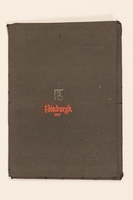
Portfolio of drawings of Edinburgh by a Jewish veteran, 2nd Polish Corps
Object
Portfolio of 28 drawings of buildings and scenes of Edinburgh, Scotland, created by Edward Herzbaum in 1947 when he studied architecture at Polish University College, London, following service as a soldier in the 2nd Polish Corps from 1942-1945. When Edward was 19, he left Łódź, Poland, shortly after Nazi Germany occupied the country in September 1939 for Soviet controlled Lvov. In June 1940, Edward was exiled to a gulag by Soviet security police. Germany invaded the Soviet Union in June 1941. Edward was released in an amnesty of Polish prisoners. He joined the Polish Army of the East, known as Anders Army. In August 1942, the unit left Soviet territory and became the 2nd Polish Corps, British Army. In February 1944, they joined the British 8th Army in Italy. The Corps fought its way north and was honored for heroism in the Battle of Monte Cassino. They celebrated VE Day, May 8, 1945, in Italy. Edward learned that his mother died in Łódź Ghetto in 1943. He studied architecture in Rome until the British decided to allow Polish Corps veterans to immigrate to England in October 1946. He then served in the Polish Resettlement Corps for two years, completed his degree, and eventually set up his own architecture firm.r had died in Łódź Ghetto in 1943. He studied architecture in Rome until the British decided to allow Polish Corps veterans to immigrate to England in October 1946. He then served in the Polish Resettlement Corps for two years and completed his degree.

Portfolio of architectural studies of Rome by a Jewish soldier, 2nd Polish Corps
Object
Portfolio of architectural drawings of Rome created by Edward Herzbaum, a soldier in the 2nd Polish Corps from 1941-1945. Edward, 19, left Łódź, Poland, shortly after Nazi Germany occupied the country in September 1939 to stay with family in Soviet controlled Lvov. In June 1940, Edward was arrested by Soviet security police and exiled to a forced labor camp. Germany invaded the Soviet Union in June 1941. Edward was released as part of an amnesty granted to Polish prisoners. He headed south to join the Polish Army of the East, known as Anders Army, a volunteer Polish military unit formed by Generals Sikorski and Anders per agreement with Stalin. In August 1942, the unit left Soviet territory and became the 2nd Polish Corps in the British Army. In February 1944, they deployed to join the British 8th Army in the Italian Campaign. The Corps fought their way north and was honored for its heroism in the May 1944 Battle of Monte Cassino. They were in Italy on May 8, 1945, when the war ended. Edward learned that his mother had died in the Łódź Ghetto in 1943. He resumed the study of architecture in Rome until the British decided to allow Polish Corps veterans to immigrate to England in October 1946. He then served in the Polish Resettlement Corps for two years and completed his degree.
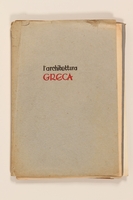
Portfolio of architectural studies of Greece by a Jewish soldier, 2nd Polish Corps
Object
Portfolio of architectural drawings of Greece created by Edward Herzbaum, a soldier in the 2nd Polish Corps from 1941-1945. Edward, 19, left Łódź, Poland, shortly after Nazi Germany occupied the country in September 1939 to stay with family in Soviet controlled Lvov. In June 1940, Edward was arrested by Soviet security police and exiled to a forced labor camp. Germany invaded the Soviet Union in June 1941. Edward was released as part of an amnesty granted to Polish prisoners. He headed south to join the Polish Army of the East, known as Anders Army, a volunteer Polish military unit formed by Generals Sikorski and Anders per agreement with Stalin. In August 1942, the unit left Soviet territory and became the 2nd Polish Corps in the British Army. In February 1944, they deployed to join the British 8th Army in the Italian Campaign. The Corps fought their way north and was honored for its heroism in the May 1944 Battle of Monte Cassino. They were in Italy on May 8, 1945, when the war ended. Edward learned that his mother had died in the Łódź Ghetto in 1943. He resumed the study of architecture in Rome until the British decided to allow Polish Corps veterans to immigrate to England in October 1946. He then served in the Polish Resettlement Corps for two years and completed his degree.

Occupation currency note, 500 Karbowanez, acquired by Jewish soldier, 2nd Polish Corps
Object
Germany occupation currency note, 500 karbowanez, issued in March 1942 in Rovno in German occupied eastern Poland (Rivne, Ukraine) acquired by Edward Herzbaum, a soldier in the 2nd Polish Corps from 1942-1945. Edward, 19, left Łódź, Poland, shortly after Nazi Germany occupied the country in September 1939 for Soviet controlled Lvov. In June 1940, he was exiled to a gulag by Soviet security police. Germany invaded the Soviet Union in June 1941. Edward was released in an amnesty granted to Polish prisoners. He headed south to join the Polish Army of the East, known as Anders Army. In August 1942, the unit left Soviet territory and became the 2nd Polish Corps, British Army. In February 1944, they joined the British 8th Army in the Italian Campaign. The Corps fought their way north and was honored for its heroism in the 1944 Battle of Monte Cassino. They were in Italy on VE May 8, 1945. Edward learned that his mother had died in Łódź Ghetto in 1943. He resumed the study of architecture in Rome until the British decided to allow Polish Corps veterans to immigrate to England in October 1946. He then served in the Polish Resettlement Corps for two years and completed his degree.
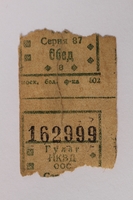
Gulag ration coupon issued to a Polish Jewish prisoner
Object
Gulag ration coupon issued to Edward Herzbaum, when he was interned in a Soviet slave labor camp from June 1940 - 1941/2. Edward, 19, left Łódź, Poland, shortly after Nazi Germany occupied the country in September 1939 for Soviet controlled Lvov. In June 1940, he was exiled to a gulag by Soviet security police. Germany invaded the Soviet Union in June 1941. Edward was released in an amnesty granted to Polish prisoners. He headed south to join the Polish Army of the East, known as Anders Army. In August 1942, the unit left Soviet territory and became the 2nd Polish Corps, British Army. In February 1944, they joined the British 8th Army in the Italian Campaign. The Corps fought their way north and was honored for its heroism in the 1944 Battle of Monte Cassino. They were in Italy on VE May 8, 1945. Edward learned that his mother had died in Łódź Ghetto in 1943. He resumed the study of architecture in Rome until the British decided to allow Polish Corps veterans to immigrate to England in October 1946. He then served in the Polish Resettlement Corps for two years and completed his degree.
Humorous drawing of an English officer and Soviet soldiers by a Jewish soldier, 2nd Polish Corps
Object
Cartoon style drawing of a British officer in conversation with his orderly in front of a group of soldiers created by Edward Herzbaum, possibly in spring 1945. The armed and uniformed troop wear overcoats and have cap badges with a 5-pointed star. The drawing comments on the cultural clash between the British and their new Soviet allies circa mid-1941. Edward, 19, left Łódź, Poland, shortly after Germany occupied the country in September 1939 to stay with family in Soviet controlled Lvov. In June 1940, Edward was arrested by Soviet security police and exiled to a forced labor camp. Germany invaded the Soviet Union in June 1941. Edward was released as part of an amnesty granted to Polish prisoners. He headed south to join the Polish Army of the East, known as Anders Army, a volunteer unit formed by General Anders per agreement with Stalin. In August 1942, the unit left Soviet territory and became the 2nd Polish Corps, British Army. In February 1944, they deployed to join the 8th British Army in the Italian Campaign. The unit fought its way north and was honored for bravery in the May 1944 victory at Monte Cassino. The unit was in Italy on VE Day, May 8 1945. Edward learned that his mother died in the Łódź Ghetto in 1943. He studied architecture in Rome until the British decided to allow Polish Corps veterans to immigrate to England in October 1946. He then worked for two years with the Polish Resettlement Corps and completed his architectural degree.
Watercolor of tents in a forest clearing by a Jewish soldier, 2nd Polish Corps
Object
Watercolor of two large white tents viewed against a green forest backdrop painted by Edward Herzbaum, probably in 1945 in Italy. Edward was a soldier in the 2nd Polish Corps, British Army, which fought with the British 8th Army in the Italian campaign. The Corps led the mountain assault in the May 1944 victory at Monte Cassino, a four month struggle that had stalemated the Allies's northern advance. Edward, 19, left Łódź, Poland, shortly after Germany occupied the country in September 1939 for
Double sided portrait sketch of a man reading a paper by a Jewish veteran, 2nd Polish Corps
Object
Two sided sketch of a man with glasses created by Edward Herzbaum whle traveling in northern Europe in 1949. During World War II, Edward had served as a soldier from 1941-1945 in the Polish Army of the East, which became the 5th Kresowa, 2nd Polish Corps, British Army. Edward, 19, left Łódź, Poland, shortly after Nazi Germany occupied the country in September 1939 to stay with family in Soviet controlled Lvov. In June 1940, he was arrested by Soviet security police and exiled to a forced labor camp. Germany invaded the Soviet Union in June 1941. Edward was released as part of an amnesty granted to Polish prisoners. He headed south to join the Polish Army of the East, known as Anders Army, a volunteer Polish military unit. In August 1942, the unit left Soviet territory and became the 2nd Polish Corps, British Army. In February 1944, they deployed to join the British 8th Army in the Italian Campaign. The Corps fought their way north and was honored for heroism in the May 1944 Battle of Monte Cassino. They were in Italy on May 7, 1945, when the war ended. Edward learned that his mother had died in the Łódź Ghetto in 1943. He studied architecture in Rome until the British decided to allow Polish Corps veterans to immigrate to England in October 1946. He then served in the Polish Resettlement Corps for two years and completed his degree.
Watercolor illustration of a structure nestled in hill by a Jewish veteran, 2nd Polish Corps
Object
Watercolor painting of a building perched on a hill near a large body of blue water created by Edward Herzbaum circa 1945 near the end or after the war. During World War II, Edward served as a soldier from 1941-1945 in the Polish Army of the East, which became the 5th Kresowa, 2nd Polish Corps, British Army. Edward, 19, left Łódź, Poland, shortly after Nazi Germany occupied the country in September 1939 to stay with family in Soviet controlled Lvov. In June 1940, he was arrested by Soviet security police and exiled to a forced labor camp. Germany invaded the Soviet Union in June 1941. Edward was released as part of an amnesty granted to Polish prisoners. He headed south to join the Polish Army of the East, known as Anders Army, a volunteer Polish military unit. In August 1942, the unit left Soviet territory and became the 2nd Polish Corps, British Army. In February 1944, they deployed to join the British 8th Army in the Italian Campaign. The Corps fought their way north and was honored for its heroic service in the May 1944 Battle of Monte Cassino. They were in Italy on May 7, 1945, when the war ended. Edward learned that his mother had died in the Łódź Ghetto in 1943. He studied architecture in Rome until the British decided to allow Polish Corps veterans to immigrate to England in October 1946. He then served in the Polish Resettlement Corps for two years and completed his degree.
Architectural study of a cathedral exterior by a Jewish veteran, 2nd Polish Corps
Object
Detailed architectural study of a cathedral exterior created by Edward Herzbaum, possibly in 1949 while traveling in Europe. During World War II, Edward was a soldier from 1941-1945 in the Polish Army of the East, which became the 2nd Polish Corps, British Army. Edward, 19, left Łódź, Poland, shortly after Nazi Germany occupied the country in September 1939 to stay with family in Soviet controlled Lvov. In June 1940, he was arrested by Soviet security police and exiled to a forced labor camp. Germany invaded the Soviet Union in June 1941. Edward was released as part of an amnesty granted to Polish prisoners. He headed south to join the Polish Army of the East, known as Anders Army, a volunteer Polish military unit. In August 1942, the unit left Soviet territory and became the 2nd Polish Corps, British Army. In February 1944, they deployed to join the British 8th Army in the Italian Campaign. The Corps fought their way north and was honored for its heroic service in the May 1944 Battle of Monte Cassino. They were in Italy on May 7, 1945, when the war ended. Edward learned that his mother had died in the Łódź Ghetto in 1943. He studied architecture in Rome until the British decided to allow Polish Corps veterans to immigrate to England in October 1946. He then served in the Polish Resettlement Corps for two years and completed his degree.
Study sketch of a reclining nude female by a Jewish veteran, 2nd Polish Corps
Object
Study sketch of a reclining female nude created by Edward Herzbaum during life drawing classes in August/September 1949 in Paris, France. During the war, Edward served as a soldier in the Polish Army of the East and the 5th Kresowa, 2nd Polish Corps, British Army, from 1941-1945. Edward, 19, left Łódź, Poland, shortly after Nazi Germany occupied the country in September 1939 to stay with family in Soviet controlled Lvov. In June 1940, he was arrested by Soviet security police and exiled to a forced labor camp. Germany invaded the Soviet Union in June 1941. Edward was released as part of an amnesty granted to Polish prisoners. He headed south to join the Polish Army of the East, known as Anders Army, a volunteer Polish military unit. In August 1942, the unit left Soviet territory and became the 2nd Polish Corps, British Army. In February 1944, they deployed to join the British 8th Army in the Italian Campaign. The Corps fought their way north and was honored for heroism in the May 1944 Battle of Monte Cassino. They were in Italy on May 7, 1945, when the war ended. Edward learned that his mother had died in the Łódź Ghetto in 1943. He studied architecture in Rome until the British decided to allow Polish Corps veterans to immigrate to England in October 1946. He then served in the Polish Resettlement Corps for two years and completed his degree.
Study sketch of a female nude sitting on a bench drawn by a Jewish veteran, 2nd Polish Corps
Object
Gesture sketch of a nude female seated on a bench created by Edward Herzbaum in 1949 while traveling in Europe. During World War II, Edward was a soldier from 1941-1945 in the Polish Army of the East, which became the 2nd Polish Corps, British Army. Edward, 19, left Łódź, Poland, shortly after Nazi Germany occupied the country in September 1939 to stay with family in Soviet controlled Lvov. In June 1940, he was arrested by Soviet security police and exiled to a forced labor camp. Germany invaded the Soviet Union in June 1941. Edward was released as part of an amnesty granted to Polish prisoners. He headed south to join the Polish Army of the East, known as Anders Army, a volunteer Polish military unit. In August 1942, the unit left Soviet territory and became the 2nd Polish Corps, British Army. In February 1944, they deployed to join the British 8th Army in the Italian Campaign. The Corps fought their way north and was honored for its heroic service in the May 1944 Battle of Monte Cassino. They were in Italy on May 7, 1945, when the war engs fwd, bentded. Edward learned that his mother had died in the Łódź Ghetto in 1943. He studied architecture in Rome until the British decided to allow Polish Corps veterans to immigrate to England in October 1946. He then served in the Polish Resettlement Corps for two years and completed his degree.
Small sketch of a bear drawn by a Jewish veteran, 2nd Polish Corps
Object
Small realistic sketch of a bear created by Edward Herzbaum in 1949 while traveling in Europe. During World War II, Edward was a soldier from 1941-1945 in the Polish Army of the East, which became the 2nd Polish Corps, British Army. Edward, 19, left Łódź, Poland, shortly after Nazi Germany occupied the country in September 1939 to stay with family in Soviet controlled Lvov. In June 1940, he was arrested by Soviet security police and exiled to a forced labor camp. Germany invaded the Soviet Union in June 1941. Edward was released as part of an amnesty granted to Polish prisoners. He headed south to join the Polish Army of the East, known as Anders Army, a volunteer Polish military unit. In August 1942, the unit left Soviet territory and became the 2nd Polish Corps, British Army. In February 1944, they deployed to join the British 8th Army in the Italian Campaign. The Corps fought their way north and was honored for its heroic service in the May 1944 Battle of Monte Cassino. They were in Italy on May 7, 1945, when the war ended. Edward learned that his mother had died in the Łódź Ghetto in 1943. He studied architecture in Rome until the British decided to allow Polish Corps veterans to immigrate to England in October 1946. He then served in the Polish Resettlement Corps for two years and completed his degree.
Architectural rendering of the facade of Peterborough Cathedral by a Jewish veteran, 2nd Polish Corps
Object
Ink wash drawing of Peterborough Cathedral in England created by Edward Herzbaum on August 1, 1949. During World War II, Edward was a soldier from 1941-1945 in the Polish Army of the East, which became the 2nd Polish Corps, British Army. Edward, 19, left Łódź, Poland, shortly after Nazi Germany occupied the country in September 1939 to stay with family in Soviet controlled Lvov. In June 1940, he was arrested by Soviet security police and exiled to a forced labor camp. Germany invaded the Soviet Union in June 1941. Edward was released as part of an amnesty granted to Polish prisoners. He headed south to join the Polish Army of the East, known as Anders Army, a volunteer Polish military unit. In August 1942, the unit left Soviet territory and became the 2nd Polish Corps, British Army. In February 1944, they deployed to join the British 8th Army in the Italian Campaign. The Corps fought their way north and was honored for its heroic service in the May 1944 Battle of Monte Cassino. They were in Italy on May 7, 1945, when the war ended. Edward learned that his mother had died in the Łódź Ghetto in 1943. He studied architecture in Rome until the British decided to allow Polish Corps veterans to immigrate to England in October 1946. He then served in the Polish Resettlement Corps for two years and completed his degree.
Study sketches with three views of a nude male seated with crossed legs by a Jewish veteran, 2nd Polish Corps
Object
Three quick sketches of a male nude seated with crossed legs and arms created by Edward Herzbaum in life drawing classes in August/September 1949 in Paris, France. During World War II, Edward was a soldier from 1941-1945 in the Polish Army of the East, which became the 2nd Polish Corps, British Army. Edward, 19, left Łódź, Poland, shortly after Nazi Germany occupied the country in September 1939 to stay with family in Soviet controlled Lvov. In June 1940, he was arrested by Soviet security police and exiled to a forced labor camp. Germany invaded the Soviet Union in June 1941. Edward was released as part of an amnesty granted to Polish prisoners. He headed south to join the Polish Army of the East, known as Anders Army, a volunteer Polish military unit. In August 1942, the unit left Soviet territory and became the 2nd Polish Corps, British Army. In February 1944, they deployed to join the British 8th Army in the Italian Campaign. The Corps fought their way north and was honored for its heroic service in the May 1944 Battle of Monte Cassino. They were in Italy on May 7, 1945, when the war ended. Edward learned that his mother had died in the Łódź Ghetto in 1943. He studied architecture in Rome until the British decided to allow Polish Corps veterans to immigrate to England in October 1946. He then served in the Polish Resettlement Corps for two years and completed his degree.
Double sided sketches of a male lion and giraffes by a Jewish veteran, 2nd Polish Corps
Object
Small drawing of a lion created by Edward Herzbaum in August/September 1949 in France. During World War II, Edward was a soldier from 1941-1945 in the Polish Army of the East, which became the 2nd Polish Corps, British Army. Edward, 19, left Łódź, Poland, shortly after Nazi Germany occupied the country in September 1939 to stay with family in Soviet controlled Lvov. In June 1940, he was arrested by Soviet security police and exiled to a forced labor camp. Germany invaded the Soviet Union in June 1941. Edward was released as part of an amnesty granted to Polish prisoners. He headed south to join the Polish Army of the East, known as Anders Army, a volunteer Polish military unit. In August 1942, the unit left Soviet territory and became the 2nd Polish Corps, British Army. In February 1944, they deployed to join the British 8th Army in the Italian Campaign. The Corps fought their way north and was honored for its heroic service in the May 1944 Battle of Monte Cassino. They were in Italy on May 7, 1945, when the war ended. Edward learned that his mother had died in the Łódź Ghetto in 1943. He studied architecture in Rome until the British decided to allow Polish Corps veterans to immigrate to England in October 1946. He then served in the Polish Resettlement Corps for two years and completed his degree.
Double sided drawing with multiple figure drawings drawn by a Jewish veteran, 2nd Polish Corps
Object
Two sided drawings with 3 life drawings, 2 woman on one side, an older male on the other, sketched by Edward Herzbaum in September 1949 in France. During World War II, Edward was a soldier from 1941-1945 in the Polish Army of the East, which became the 2nd Polish Corps, British Army. Edward, 19, left Łódź, Poland, shortly after Nazi Germany occupied the country in September 1939 to stay with family in Soviet controlled Lvov. In June 1940, he was arrested by Soviet security police and exiled to a forced labor camp. Germany invaded the Soviet Union in June 1941. Edward was released as part of an amnesty granted to Polish prisoners. He headed south to join the Polish Army of the East, known as Anders Army, a volunteer Polish military unit. In August 1942, the unit left Soviet territory and became the 2nd Polish Corps, British Army. In February 1944, they deployed to join the British 8th Army in the Italian Campaign. The Corps fought their way north and was honored for its heroic service in the May 1944 Battle of Monte Cassino. They were in Italy on May 7, 1945, when the war ended. Edward learned that his mother had died in the Łódź Ghetto in 1943. He studied architecture in Rome until the British decided to allow Polish Corps veterans to immigrate to England in October 1946. He then served in the Polish Resettlement Corps for two years and completed his degree.
Sketch of a slender nude male from the back by a Jewish veteran, 2nd Polish Corps
Object
Ink gesture drawing of a partially nude male created by Edward Herzbaum during life drawing classes in September 1949 in Paris, France. During World War II, Edward was a soldier from 1941-1945 in the Polish Army of the East, which became the 2nd Polish Corps, British Army. Edward, 19, left Łódź, Poland, shortly after Nazi Germany occupied the country in September 1939 to stay with family in Soviet controlled Lvov. In June 1940, he was arrested by Soviet security police and exiled to a forced labor camp. Germany invaded the Soviet Union in June 1941. Edward was released as part of an amnesty granted to Polish prisoners. He headed south to join the Polish Army of the East, known as Anders Army, a volunteer Polish military unit. In August 1942, the unit left Soviet territory and became the 2nd Polish Corps, British Army. In February 1944, they deployed to join the British 8th Army in the Italian Campaign. The Corps fought their way north and was honored for its heroic service in the May 1944 Battle of Monte Cassino. They were in Italy on May 7, 1945, when the war ended. Edward learned that his mother had died in the Łódź Ghetto in 1943. He studied architecture in Rome until the British decided to allow Polish Corps veterans to immigrate to England in October 1946. He then served in the Polish Resettlement Corps for two years and completed his degree.
Study of male nudes by Jewish veteran, 2nd Polish Corps
Object
Ink gesture drawing of two similarly posed nude males created by Edward Herzbaum during life drawing classes in September 1949 in Paris, France. During World War II, Edward was a soldier from 1941-1945 in the Polish Army of the East, which became the 2nd Polish Corps, British Army. Edward, 19, left Łódź, Poland, shortly after Nazi Germany occupied the country in September 1939 to stay with family in Soviet controlled Lvov. In June 1940, he was arrested by Soviet security police and exiled to a forced labor camp. Germany invaded the Soviet Union in June 1941. Edward was released as part of an amnesty granted to Polish prisoners. He headed south to join the Polish Army of the East, known as Anders Army, a volunteer Polish military unit. In August 1942, the unit left Soviet territory and became the 2nd Polish Corps, British Army. In February 1944, they deployed to join the British 8th Army in the Italian Campaign. The Corps fought their way north and was honored for its heroic service in the May 1944 Battle of Monte Cassino. They were in Italy on May 7, 1945, when the war ended. Edward learned that his mother had died in the Łódź Ghetto in 1943. He studied architecture in Rome until the British decided to allow Polish Corps veterans to immigrate to England in October 1946. He then served in the Polish Resettlement Corps for two years and completed his degree.
Portrait of standing nude male by Jewish veteran, 2nd Polish Corps
Object
Portrait drawing of a nude male in red conte crayon created by Edward Herzbaum during life drawing classes in September 1949 in Paris, France. During World War II, Edward was a soldier from 1941-1945 in the Polish Army of the East, which became the 2nd Polish Corps, British Army. Edward, 19, left Łódź, Poland, shortly after Nazi Germany occupied the country in September 1939 to stay with family in Soviet controlled Lvov. In June 1940, he was arrested by Soviet security police and exiled to a forced labor camp. Germany invaded the Soviet Union in June 1941. Edward was released as part of an amnesty granted to Polish prisoners. He headed south to join the Polish Army of the East, known as Anders Army, a volunteer Polish military unit. In August 1942, the unit left Soviet territory and became the 2nd Polish Corps, British Army. In February 1944, they deployed to join the British 8th Army in the Italian Campaign. The Corps fought their way north and was honored for its heroic service in the May 1944 Battle of Monte Cassino. They were in Italy on May 7, 1945, when the war ended. Edward learned that his mother had died in the Łódź Ghetto in 1943. He studied architecture in Rome until the British decided to allow Polish Corps veterans to immigrate to England in October 1946. He then served in the Polish Resettlement Corps for two years and completed his degree.
Potrait of a seated nude male by Jewish veteran, 2nd Polish Corps
Object
Portrait on gray paper of a seated nude male created by Edward Herzbaum during life drawing classes in September 1949 in Paris, France. During World War II, Edward was a soldier from 1941-1945 in the Polish Army of the East, which became the 2nd Polish Corps, British Army. Edward, 19, left Łódź, Poland, shortly after Nazi Germany occupied the country in September 1939 to stay with family in Soviet controlled Lvov. In June 1940, he was arrested by Soviet security police and exiled to a forced labor camp. Germany invaded the Soviet Union in June 1941. Edward was released as part of an amnesty granted to Polish prisoners. He headed south to join the Polish Army of the East, known as Anders Army, a volunteer Polish military unit. In August 1942, the unit left Soviet territory and became the 2nd Polish Corps, British Army. In February 1944, they deployed to join the British 8th Army in the Italian Campaign. The Corps fought their way north and was honored for its heroic service in the May 1944 Battle of Monte Cassino. They were in Italy on May 7, 1945, when the war ended. Edward learned that his mother had died in the Łódź Ghetto in 1943. He studied architecture in Rome until the British decided to allow Polish Corps veterans to immigrate to England in October 1946. He then served in the Polish Resettlement Corps for two years and completed his degree.
Double sided studies of nude males by a Jewish veteran, 2nd Polish Corps
Object
Two sided sketch with two images of a seated male nude and, on the other side, a standing nude male created by Edward Herzbaum during life drawing classes in August/September 1949 in Paris, France. During World War II, Edward was a soldier from 1941-1945 in the Polish Army of the East, which became the 2nd Polish Corps, British Army. Edward, 19, left Łódź, Poland, shortly after Nazi Germany occupied the country in September 1939 to stay with family in Soviet controlled Lvov. In June 1940, he was arrested by Soviet security police and exiled to a forced labor camp. Germany invaded the Soviet Union in June 1941. Edward was released as part of an amnesty granted to Polish prisoners. He headed south to join the Polish Army of the East, known as Anders Army, a volunteer Polish military unit. In August 1942, the unit left Soviet territory and became the 2nd Polish Corps, British Army. In February 1944, they deployed to join the British 8th Army in the Italian Campaign. The Corps fought their way north and was honored for its heroic service in the May 1944 Battle of Monte Cassino. They were in Italy on May 7, 1945, when the war ended. Edward learned that his mother had died in the Łódź Ghetto in 1943. He studied architecture in Rome until the British decided to allow Polish Corps veterans to immigrate to England in October 1946. He then served in the Polish Resettlement Corps for two years and completed his degree.
Double sided studies of nude males by Jewish veteran, 2nd Polish Corps
Object
Gestural drawings on two sides of the paper depicting seated nude male figures created by Edward Herzbaum during life drawing classes in August/September 1949 in Paris, France. During World War II, Edward was a soldier from 1941-1945 in the Polish Army of the East, which became the 2nd Polish Corps, British Army. Edward, 19, left Łódź, Poland, shortly after Nazi Germany occupied the country in September 1939 to stay with family in Soviet controlled Lvov. In June 1940, he was arrested by Soviet security police and exiled to a forced labor camp. Germany invaded the Soviet Union in June 1941. Edward was released as part of an amnesty granted to Polish prisoners. He headed south to join the Polish Army of the East, known as Anders Army, a volunteer Polish military unit. In August 1942, the unit left Soviet territory and became the 2nd Polish Corps, British Army. In February 1944, they deployed to join the British 8th Army in the Italian Campaign. The Corps fought their way north and was honored for heroism in the May 1944 Battle of Monte Cassino. They were in Italy on May 7, 1945, when the war ended. Edward learned that his mother had died in the Łódź Ghetto in 1943. He studied architecture in Rome until the British decided to allow Polish Corps veterans to immigrate to England in October 1946. He then served in the Polish Resettlement Corps for two years and completed his degree.
Multiple studies of nude males by Jewish veteran, 2nd Polish Corps
Object
Gestural drawings of five male nudes created by Edward Herzbaum during life drawing classes in August/September 1949 in Paris, France. During World War II, Edward was a soldier from 1941-1945 in the Polish Army of the East, which became the 2nd Polish Corps, British Army. Edward, 19, left Łódź, Poland, shortly after Nazi Germany occupied the country in September 1939 to stay with family in Soviet controlled Lvov. In June 1940, he was arrested by Soviet security police and exiled to a forced labor camp. Germany invaded the Soviet Union in June 1941. Edward was released as part of an amnesty granted to Polish prisoners. He headed south to join the Polish Army of the East, known as Anders Army, a volunteer Polish military unit. In August 1942, the unit left Soviet territory and became the 2nd Polish Corps, British Army. In February 1944, they deployed to join the British 8th Army in the Italian Campaign. The Corps fought their way north and was honored for its heroic service in the May 1944 Battle of Monte Cassino. They were in Italy on May 7, 1945, when the war ended. Edward learned that his mother had died in the Łódź Ghetto in 1943. He studied architecture in Rome until the British decided to allow Polish Corps veterans to immigrate to England in October 1946. He then served in the Polish Resettlement Corps for two years and completed his degree.
Double sided studies of nudes and building elevations by Jewish veteran, 2nd Polish Corps
Object
Gesture drawings of female nudes drawn on the back of an architecture class assignment by Edward Herzbaum during life drawing classes in August-September 1949 in Paris, France. During World War II, Edward was a soldier in the Polish Army of the East, which became the 2nd Polish Corps, British Army. Edward, 19, left Łódź, Poland, shortly after Nazi Germany occupied the country in September 1939 for Soviet controlled Lvov. In June 1940, he was exiled to a gulag by Soviet security police. Germany invaded the Soviet Union in June 1941. Edward was released in an amnesty of Polish prisoners. He headed south to join the Polish Army of the East, known as Anders Army. In August 1942, the unit left Soviet territory and became the 2nd Polish Corps. In February 1944, they joined the British 8th Army in Italy. The Corps fought their way north and was honored for its heroic service in the May 1944 Battle of Monte Cassino. They were in Italy on May 7, 1945, when the war ended. Edward learned that his mother had died in Łódź Ghetto in 1943. He studied architecture in Rome until the British decided to allow Polish Corps veterans to immigrate to England in October 1946. He then served in the Polish Resettlement Corps for two years and completed his degree.
Double sided studies of female nudes by a Jewish veteran, 2nd Polish Corps
Object
Two sided drawing featuring ink gesture sketches of several nude female figures created by Edward Herzbaum during life drawing classes in August/September 1949 in Paris, France. During World War II, Edward was a soldier from 1941-1945 in the Polish Army of the East, which became the 2nd Polish Corps, British Army. Edward, 19, left Łódź, Poland, shortly after Nazi Germany occupied the country in September 1939 to stay with family in Soviet controlled Lvov. In June 1940, he was arrested by Soviet security police and exiled to a forced labor camp. Germany invaded the Soviet Union in June 1941. Edward was released as part of an amnesty granted to Polish prisoners. He headed south to join the Polish Army of the East, known as Anders Army, a volunteer Polish military unit. In August 1942, the unit left Soviet territory and became the 2nd Polish Corps, British Army. In February 1944, they deployed to join the British 8th Army in the Italian Campaign. The Corps fought their way north and was honored for its heroic service in the May 1944 Battle of Monte Cassino. They were in Italy on May 7, 1945, when the war ended. Edward learned that his mother had died in the Łódź Ghetto in 1943. He studied architecture in Rome until the British decided to allow Polish Corps veterans to immigrate to England in October 1946. He then served in the Polish Resettlement Corps for two years and completed his degree.
Double sided drawing of nude females by Jewish veteran, 2nd Polish Corps
Object
Two sided drawing with ink gesture sketches of nude females created by Edward Herzbaum during life drawing classes in August/September 1949 in Paris, France. During World War II, Edward was a soldier from 1941-1945 in the Polish Army of the East, which became the 2nd Polish Corps, British Army. Edward, 19, left Łódź, Poland, shortly after Nazi Germany occupied the country in September 1939 to stay with family in Soviet controlled Lvov. In June 1940, he was arrested by Soviet security police and exiled to a forced labor camp. Germany invaded the Soviet Union in June 1941. Edward was released as part of an amnesty granted to Polish prisoners. He headed south to join the Polish Army of the East, known as Anders Army, a volunteer Polish military unit. In August 1942, the unit left Soviet territory and became the 2nd Polish Corps, British Army. In February 1944, they deployed to join the British 8th Army in the Italian Campaign. The Corps fought their way north and was honored for its heroic service in the May 1944 Battle of Monte Cassino. They were in Italy on May 7, 1945, when the war ended. Edward learned that his mother had died in the Łódź Ghetto in 1943. He studied architecture in Rome until the British decided to allow Polish Corps veterans to immigrate to England in October 1946. He then served in the Polish Resettlement Corps for two years and completed his degree.
Drawing of timbered cathedral ceiling by Jewish veteran, 2nd Polish Corps
Object
Watercolor of a Gothic cathedral with a wooden ceiling created by Edward Herzbaum in August 1949. It may be Peterborough in England which he visited at that time, or another timber ceiling cathedral in the region, such as Ely. During World War II, Edward was a soldier in the Polish Army of the East, which became the 2nd Polish Corps, British Army. Edward, 19, left Łódź, Poland, shortly after Nazi Germany occupied the country in September 1939 for Soviet controlled Lvov. In June 1940, he was exiled to a gulag by Soviet security police. Germany invaded the Soviet Union in June 1941. Edward was released in an amnesty of Polish prisoners. He headed south to join the Polish Army of the East, known as Anders Army. In August 1942, the unit left Soviet territory and became the 2nd Polish Corps. In February 1944, they joined the British 8th Army in Italy. The Corps fought their way north and was honored for its heroic service in the May 1944 Battle of Monte Cassino. They were in Italy on VE Day, May 8, 1945, the war's end. Edward learned that his mother had died in Łódź Ghetto in 1943. He studied architecture in Rome until the British decided to allow Polish Corps veterans to immigrate to England in October 1946. He then served in the Polish Resettlement Corps for two years and completed his degree.
Two studies of nude male figures by Jewish veteran, 2nd Polish Corps
Object
Ink gesture drawings of a two separate male nudes created by Edward Herzbaum during life drawing classes in August/September 1949 in Paris, France. During World War II, Edward was a soldier from 1941-1945 in the Polish Army of the East, which became the 2nd Polish Corps, British Army. Edward, 19, left Łódź, Poland, shortly after Nazi Germany occupied the country in September 1939 to stay with family in Soviet controlled Lvov. In June 1940, he was arrested by Soviet security police and exiled to a forced labor camp. Germany invaded the Soviet Union in June 1941. Edward was released as part of an amnesty granted to Polish prisoners. He headed south to join the Polish Army of the East, known as Anders Army, a volunteer Polish military unit. In August 1942, the unit left Soviet territory and became the 2nd Polish Corps, British Army. In February 1944, they deployed to join the British 8th Army in the Italian Campaign. The Corps fought their way north and was honored for its heroic service in the May 1944 Battle of Monte Cassino. They were in Italy on May 7, 1945, when the war ended. Edward learned that his mother had died in the Łódź Ghetto in 1943. He studied architecture in Rome until the British decided to allow Polish Corps veterans to immigrate to England in October 1946. He then served in the Polish Resettlement Corps for two years and completed his degree.
Double sided drawing of nude female by Jewish veteran, 2nd Polish Corps
Object
Gesture drawings of several female nudes on both sides of thick dark green paper created by Edward Herzbaum during life drawing classes in August/September 1949 in Paris, France. During World War II, Edward was a soldier from 1941-1945 in the Polish Army of the East, which became the 2nd Polish Corps, British Army. Edward, 19, left Łódź, Poland, shortly after Nazi Germany occupied the country in September 1939 to stay with family in Soviet controlled Lvov. In June 1940, he was arrested by Soviet security police and exiled to a forced labor camp. Germany invaded the Soviet Union in June 1941. Edward was released as part of an amnesty granted to Polish prisoners. He headed south to join the Polish Army of the East, known as Anders Army, a volunteer Polish military unit. In August 1942, the unit left Soviet territory and became the 2nd Polish Corps, British Army. In February 1944, they deployed to join the British 8th Army in the Italian Campaign. The Corps fought their way north and was honored for its heroic service in the May 1944 Battle of Monte Cassino. They were in Italy on May 7, 1945, when the war ended. Edward learned that his mother had died in the Łódź Ghetto in 1943. He studied architecture in Rome until the British decided to allow Polish Corps veterans to immigrate to England in October 1946. He then served in the Polish Resettlement Corps for two years and completed his degree.
Study of a partially nude male by Jewish veteran, 2nd Polish Corps
Object
Pencil drawing of a partially nude male on thick, dark blue paper created by Edward Herzbaum during life drawing classes in August/September 1949 in Paris, France. During World War II, Edward was a soldier from 1941-1945 in the Polish Army of the East, which became the 2nd Polish Corps, British Army. Edward, 19, left Łódź, Poland, shortly after Nazi Germany occupied the country in September 1939 to stay with family in Soviet controlled Lvov. In June 1940, he was arrested by Soviet security police and exiled to a forced labor camp. Germany invaded the Soviet Union in June 1941. Edward was released as part of an amnesty granted to Polish prisoners. He headed south to join the Polish Army of the East, known as Anders Army, a volunteer Polish military unit. In August 1942, the unit left Soviet territory and became the 2nd Polish Corps, British Army. In February 1944, they deployed to join the British 8th Army in the Italian Campaign. The Corps fought their way north and was honored for its heroic service in the May 1944 Battle of Monte Cassino. They were in Italy on May 7, 1945, when the war ended. Edward learned that his mother had died in the Łódź Ghetto in 1943. He studied architecture in Rome until the British decided to allow Polish Corps veterans to immigrate to England in October 1946. He then served in the Polish Resettlement Corps for two years and completed his degree.
Study of nude male with raised arms by Jewish veteran, 2nd Polish Corps
Object
Ink gesture drawing of a nude male with his arms raised created by Edward Herzbaum during life drawing classes in August/September 1949 in Paris, France. During World War II, Edward was a soldier from 1941-1945 in the Polish Army of the East, which became the 2nd Polish Corps, British Army. Edward, 19, left Łódź, Poland, shortly after Nazi Germany occupied the country in September 1939 to stay with family in Soviet controlled Lvov. In June 1940, he was arrested by Soviet security police and exiled to a forced labor camp. Germany invaded the Soviet Union in June 1941. Edward was released as part of an amnesty granted to Polish prisoners. He headed south to join the Polish Army of the East, known as Anders Army, a volunteer Polish military unit. In August 1942, the unit left Soviet territory and became the 2nd Polish Corps, British Army. In February 1944, they deployed to join the British 8th Army in the Italian Campaign. The Corps fought their way north and was honored for its heroic service in the May 1944 Battle of Monte Cassino. They were in Italy on May 7, 1945, when the war ended. Edward learned that his mother had died in the Łódź Ghetto in 1943. He studied architecture in Rome until the British decided to allow Polish Corps veterans to immigrate to England in October 1946. He then served in the Polish Resettlement Corps for two years and completed his degree.
Sketches of penguin, lions, and faces by Jewish veteran, 2nd Polish Corps
Object
Conte crayon drawings of penguins and lions, and on the back, three sketches of male heads created by Edward Herzbaum after the war. During the war, Edward served as a soldier in the 5th Kresowa, 2nd Polish Corps, British Army, from 1941-1945. Edward, 19, left Łódź, Poland, shortly after Nazi Germany occupied the country in September 1939 to stay with family in Soviet controlled Lvov. In June 1940, he was arrested by Soviet security police and exiled to a forced labor camp. Germany invaded the Soviet Union in June 1941. Edward was released as part of an amnesty granted to Polish prisoners. He headed south to join the Polish Army of the East, known as Anders Army, a volunteer Polish military unit. In August 1942, the unit left Soviet territory and became the 2nd Polish Corps, British Army. In February 1944, they deployed to join the British 8th Army in the Italian Campaign. The Corps fought their way north and was honored for its heroic service in the May 1944 Battle of Monte Cassino. They were in Italy on May 7, 1945, when the war ended. Edward learned that his mother had died in the Łódź Ghetto in 1943. He studied architecture in Rome until the British decided to allow Polish Corps veterans to immigrate to England in October 1946. He then served in the Polish Resettlement Corps for two years and completed his degree.
Architectural study of Pazzi Chapel by a Jewish veteran, 2nd Polish Corps
Object
Drawing of the Pazzi Chapel in the Basilica of Sante Croce in Florence, Italy, created by Edward Herzbaum in August 1946. During the war, Edward served as a soldier in the Polish Army of the East which became the 2nd Polish Corps, British Army, from 1941-1945. Edward, 19, left Łódź, Poland, shortly after Nazi Germany occupied the country in September 1939 to stay with family in Soviet controlled Lvov. In June 1940, he was arrested by Soviet security police and exiled to a forced labor camp. Germany invaded the Soviet Union in June 1941. Edward was released as part of an amnesty granted to Polish prisoners. He headed south to join the Polish Army of the East, known as Anders Army, a volunteer Polish military unit. In August 1942, the unit left Soviet territory and became the 2nd Polish Corps, British Army. In February 1944, they deployed to join the British 8th Army in the Italian Campaign. The Corps fought its way north and was honored for bravery in the May 1944 Battle of Monte Cassino. They were in Italy on May 8, 1945, when the war ended. Edward learned that his mother had died in the Łódź Ghetto in 1943. He studied architecture in Rome until the British decided to allow Polish Corps veterans to immigrate to England in October 1946. He then served in the Polish Resettlement Corps for two years and completed his degree.
Double sided sketches of female nudes by Jewish veteran, 2nd Polish Corps
Object
Gestural ink drawings of a various females nudes on both sides of the paper by Edward Herzbaum during life drawing classes in Paris, France, in August-September 1949. During the war, Edward served as a soldier in the Polish Army of the East which became the 2nd Polish Corps, British Army, from 1941-1945. Edward, 19, left Łódź, Poland, shortly after Nazi Germany occupied the country in September 1939 to stay with family in Soviet controlled Lvov. In June 1940, he was arrested by Soviet security police and exiled to a forced labor camp. Germany invaded the Soviet Union in June 1941. Edward was released as part of an amnesty granted to Polish prisoners. He headed south to join the Polish Army of the East, known as Anders Army, a volunteer Polish military unit. In August 1942, the unit left Soviet territory and became the 2nd Polish Corps, British Army. In February 1944, they deployed to join the British 8th Army in the Italian Campaign. The Corps fought its way north and was honored for bravery in the May 1944 Battle of Monte Cassino. They were in Italy on May 8, 1945, when the war ended. Edward learned that his mother had died in the Łódź Ghetto in 1943. He studied architecture in Rome until the British decided to allow Polish Corps veterans to immigrate to England in October 1946. He then served in the Polish Resettlement Corps for two years and completed his degree.
Double sided drawing of nude females by Jewish veteran, 2nd Polish Corps
Object
Ink gesture sketches of nude females, one on the front and two on the back, created by Edward Herzbaum during life drawing classes in August/September 1949 in Paris, France. During World War II, Edward was a soldier from 1941-1945 in the Polish Army of the East, which became the 2nd Polish Corps, British Army. Edward, 19, left Łódź, Poland, shortly after Nazi Germany occupied the country in September 1939 to stay with family in Soviet controlled Lvov. In June 1940, he was arrested by Soviet security police and exiled to a forced labor camp. Germany invaded the Soviet Union in June 1941. Edward was released as part of an amnesty granted to Polish prisoners. He headed south to join the Polish Army of the East, known as Anders Army, a volunteer Polish military unit. In August 1942, the unit left Soviet territory and became the 2nd Polish Corps, British Army. In February 1944, they deployed to join the British 8th Army in the Italian Campaign. The Corps fought their way north and was honored for its heroic service in the May 1944 Battle of Monte Cassino. They were in Italy on May 7, 1945, when the war ended. Edward learned that his mother had died in the Łódź Ghetto in 1943. He studied architecture in Rome until the British decided to allow Polish Corps veterans to immigrate to England in October 1946. He then served in the Polish Resettlement Corps for two years and completed his degree.
Architectural study of Pantheon by Jewish veteran, 2nd Polish Corps
Object
Drawing of the Pantheon in Paris, France, created by Edward Herzbaum while traveling in northern Europe in September 1949. During World War II, Edward was a soldier from 1941-1945 in the Polish Army of the East, which became the 2nd Polish Corps, British Army. Edward, 19, left Łódź, Poland, shortly after Nazi Germany occupied the country in September 1939 to stay with family in Soviet controlled Lvov. In June 1940, he was arrested by Soviet security police and exiled to a forced labor camp. Germany invaded the Soviet Union in June 1941. Edward was released as part of an amnesty granted to Polish prisoners. He headed south to join the Polish Army, known as Anders Army, a volunteer Polish military unit. In August 1942, the unit left Soviet territory and became the 2nd Polish Corps, British Army. In February 1944, they deployed to join the British 8th Army in the Italian Campaign. The Corps fought its way north and was honored for bravery in the May 1944 Battle of Monte Cassino. They were in Italy on May 8, 1945, when the war ended. Edward learned that his mother had died in the Łódź Ghetto in 1943. He studied architecture in Rome until the British decided to allow Polish Corps veterans to immigrate to England in October 1946. He then served in the Polish Resettlement Corps for two years and completed his degree.
Architectural study of Pavillon Richelieu by Jewish veteran, 2nd Polish Corps
Object
Drawing of the Pavilion Richelieu in the Louvre Museum in Paris, France, created by Edward Herzbaum in September 1949. During World War II, Edward was a soldier from 1941-1945 in the Polish Army of the East, which became the 2nd Polish Corps, British Army. Edward, 19, left Łódź, Poland, shortly after Nazi Germany occupied the country in September 1939 to stay with family in Soviet controlled Lvov. In June 1940, he was arrested by Soviet security police and exiled to a forced labor camp. Germany invaded the Soviet Union in June 1941. Edward was released as part of an amnesty granted to Polish prisoners. He headed south to join the Polish Army, known as Anders Army, a volunteer Polish military unit. In August 1942, the unit left Soviet territory and became the 2nd Polish Corps, British Army. In February 1944, they deployed to join the British 8th Army in the Italian Campaign. The Corps fought its way north and was honored for bravery in the May 1944 Battle of Monte Cassino. They were in Italy on May 8, 1945, when the war ended. Edward learned that his mother had died in the Łódź Ghetto in 1943. He studied architecture in Rome until the British decided to allow Polish Corps veterans to immigrate to England in October 1946. He then served in the Polish Resettlement Corps for two years and completed his degree.
Architectural study, interior of St-Pierre Cathedral by Jewish veteran, 2nd Polish Corps
Object
Ink drawing of the interior of the Cathedral of St. Peter in Beauvais, France, created by Edward Herzbaum while traveling in Europe in September 1949. During World War II, Edward was a soldier from 1941-1945 in the Polish Army of the East, which became the 2nd Polish Corps, British Army. Edward, 19, left Łódź, Poland, shortly after Nazi Germany occupied the country in September 1939 to stay with family in Soviet controlled Lvov. In June 1940, he was arrested by Soviet security police and exiled to a forced labor camp. Germany invaded the Soviet Union in June 1941. Edward was released as part of an amnesty granted to Polish prisoners. He headed south to join the Polish Army, known as Anders Army, a volunteer Polish military unit. In August 1942, the unit left Soviet territory and became the 2nd Polish Corps, British Army. In February 1944, they deployed to join the British 8th Army in the Italian Campaign. The Corps fought its way north and was honored for bravery in the May 1944 Battle of Monte Cassino. They were in Italy on May 8, 1945, when the war ended. Edward learned that his mother had died in the Łódź Ghetto in 1943. He studied architecture in Rome until the British decided to allow Polish Corps veterans to immigrate to England in October 1946. He then served in the Polish Resettlement Corps for two years and completed his degree.
Sketch of facade of Notre Dame by Jewish veteran, 2nd Polish Corps
Object
Partial drawing of the cathedral of Notre Dame in Paris created by Edward Herzbaum while traveling in France in August 1949. During World War II, Edward was a soldier from 1941-1945 in the Polish Army of the East, which became the 2nd Polish Corps, British Army. Edward, 19, left Łódź, Poland, shortly after Nazi Germany occupied the country in September 1939 to stay with family in Soviet controlled Lvov. In June 1940, he was arrested by Soviet security police and exiled to a forced labor camp. Germany invaded the Soviet Union in June 1941. Edward was released as part of an amnesty granted to Polish prisoners. He headed south to join the Polish Army, known as Anders Army, a volunteer Polish military unit. In August 1942, the unit left Soviet territory and became the 2nd Polish Corps, British Army. In February 1944, they deployed to join the British 8th Army in the Italian Campaign. The Corps fought its way north and was honored for bravery in the May 1944 Battle of Monte Cassino. They were in Italy on May 8, 1945, when the war ended. Edward learned that his mother had died in the Łódź Ghetto in 1943. He studied architecture in Rome until the British decided to allow Polish Corps veterans to immigrate to England in October 1946. He then served in the Polish Resettlement Corps for two years and completed his degree.
Drawing of village square by a Jewish veteran, 2nd Polish Corps
Object
Drawing of the town square near the cathedral in Beauvais, France, created by Edward Herzbaum on September 26, 1949 while traveling in Europe. During World War II, Edward was a soldier from 1941-1945 in the Polish Army of the East, which became the 2nd Polish Corps, British Army. Edward, 19, left Łódź, Poland, shortly after Nazi Germany occupied the country in September 1939 to stay with family in Soviet controlled Lvov. In June 1940, he was arrested by Soviet security police and exiled to a forced labor camp. Germany invaded the Soviet Union in June 1941. Edward was released as part of an amnesty granted to Polish prisoners. He headed south to join the Polish Army, known as Anders Army, a volunteer Polish military unit. In August 1942, the unit left Soviet territory and became the 2nd Polish Corps, British Army. In February 1944, they deployed to join the British 8th Army in the Italian Campaign. The Corps fought its way north and was honored for bravery in the May 1944 Battle of Monte Cassino. They were in Italy on May 8, 1945, when the war ended. Edward learned that his mother had died in the Łódź Ghetto in 1943. He studied architecture in Rome until the British decided to allow Polish Corps veterans to immigrate to England in October 1946. He then served in the Polish Resettlement Corps for two years and completed his degree.
Architectural study of upper section of St-Pierre Cathedral by Jewish veteran, 2nd Polish Corps
Object
Unfinished drawing of St-Pierre Cathedral in Beauvais, created by Edward Herzbaum while traveling in France in late September 1949. During World War II, Edward was a soldier from 1941-1945 in the Polish Army of the East, which became the 2nd Polish Corps, British Army. Edward, 19, left Łódź, Poland, shortly after Nazi Germany occupied the country in September 1939 to stay with family in Soviet controlled Lvov. In June 1940, he was arrested by Soviet security police and exiled to a forced labor camp. Germany invaded the Soviet Union in June 1941. Edward was released as part of an amnesty granted to Polish prisoners. He headed south to join the Polish Army, known as Anders Army, a volunteer Polish military unit. In August 1942, the unit left Soviet territory and became the 2nd Polish Corps, British Army. In February 1944, they deployed to join the British 8th Army in the Italian Campaign. The Corps fought its way north and was honored for bravery in the May 1944 Battle of Monte Cassino. They were in Italy on May 8, 1945, when the war ended. Edward learned that his mother had died in the Łódź Ghetto in 1943. He studied architecture in Rome until the British decided to allow Polish Corps veterans to immigrate to England in October 1946. He then served in the Polish Resettlement Corps for two years and completed his degree.
Architectural study of St-Pierre Cathedral by Jewish veteran, 2nd Polish Corps
Object
Drawing of the exterior of the Cathedral of St. Peter in Beauvais, France, created by Edward Herzbaum in September 1949. During World War II, Edward was a soldier from 1941-1945 in the Polish Army of the East, which became the 2nd Polish Corps, British Army. Edward, 19, left Łódź, Poland, shortly after Nazi Germany occupied the country in September 1939 to stay with family in Soviet controlled Lvov. In June 1940, he was arrested by Soviet security police and exiled to a forced labor camp. Germany invaded the Soviet Union in June 1941. Edward was released as part of an amnesty granted to Polish prisoners. He headed south to join the Polish Army, known as Anders Army, a volunteer Polish military unit. In August 1942, the unit left Soviet territory and became the 2nd Polish Corps, British Army. In February 1944, they deployed to join the British 8th Army in the Italian Campaign. The Corps fought its way north and was honored for bravery in the May 1944 Battle of Monte Cassino. They were in Italy on May 8, 1945, when the war ended. Edward learned that his mother had died in the Łódź Ghetto in 1943. He studied architecture in Rome until the British decided to allow Polish Corps veterans to immigrate to England in October 1946. He then served in the Polish Resettlement Corps for two years and completed his degree.
Architectural study of Hotel des Invalides by Jewish veteran, 2nd Polish Corps
Object
Detailed ink drawing of the Hotel des Invalides in Paris, France, created by Edward Herzbaum while traveling in Europe in August/September 1949. During World War II, Edward was a soldier from 1941-1945 in the Polish Army of the East, which became the 2nd Polish Corps, British Army. Edward, 19, left Łódź, Poland, shortly after Nazi Germany occupied the country in September 1939 to stay with family in Soviet controlled Lvov. In June 1940, he was arrested by Soviet security police and exiled to a forced labor camp. Germany invaded the Soviet Union in June 1941. Edward was released as part of an amnesty granted to Polish prisoners. He headed south to join the Polish Army, known as Anders Army, a volunteer Polish military unit. In August 1942, the unit left Soviet territory and became the 2nd Polish Corps, British Army. In February 1944, they deployed to join the British 8th Army in the Italian Campaign. The Corps fought its way north and was honored for bravery in the May 1944 Battle of Monte Cassino. They were in Italy on May 8, 1945, when the war ended. Edward learned that his mother had died in the Łódź Ghetto in 1943. He studied architecture in Rome until the British decided to allow Polish Corps veterans to immigrate to England in October 1946. He then served in the Polish Resettlement Corps for two years and completed his degree.
Architectural study of Gothic tower and graveyard by Jewish veteran, 2nd Polish Corps
Object
Drawing of St. Mary's Church and graveyard in West Anglia created by Edward Herzbaum in England after 1946. During the war, Edward was a soldier in the Polish Army of the East which became the 2nd Polish Corps, British Army, from 1941-1945. Edward, 19, left Łódź, Poland, shortly after Nazi Germany occupied the country in September 1939 to stay with family in Soviet controlled Lvov. In June 1940, he was arrested by Soviet security police and exiled to a forced labor camp. Germany invaded the Soviet Union in June 1941. Edward was released as part of an amnesty granted to Polish prisoners. He headed south to join the Polish Army of the East, known as Anders Army. In August 1942, the unit left Soviet territory and became the 2nd Polish Corps, British Army. In February 1944, they deployed to join the British 8th Army in the Italian Campaign. The Corps fought its way north and was honored for bravery in the May 1944 Battle of Monte Cassino. They were in Italy on May 7, 1945, when the war ended. Edward learned that his mother had died in the Łódź Ghetto in 1943. He studied architecture in Rome until the British decided to allow Polish Corps veterans to immigrate to England in October 1946. He then served in the Polish Resettlement Corps for two years and completed his degree.
Six study sketches of a nude female figure by a Jewish veteran, 2nd Polish Corps
Object
Ink gesture sketches of six poses of a nude female created by Edward Herzbaum in life drawing classes in August/September 1949 when he was traveling in France. During the war, Edward was a soldier in the Polish Army of the East which became the 2nd Polish Corps, British Army, from 1941-1945. Edward, 19, left Łódź, Poland, shortly after Nazi Germany occupied the country in September 1939 to stay with family in Soviet controlled Lvov. In June 1940, he was arrested by Soviet security police and exiled to a forced labor camp. Germany invaded the Soviet Union in June 1941. Edward was released as part of an amnesty granted to Polish prisoners. He headed south to join the Polish Army of the East, known as Anders Army. In August 1942, the unit left Soviet territory and became the 2nd Polish Corps, British Army. In February 1944, they deployed to join the British 8th Army in the Italian Campaign. The Corps fought its way north and was honored for bravery in the May 1944 Battle of Monte Cassino. They were in Italy on May 7, 1945, when the war ended. Edward learned that his mother had died in the Łódź Ghetto in 1943. He studied architecture in Rome until the British decided to allow Polish Corps veterans to immigrate to England in October 1946. He then served in the Polish Resettlement Corps for two years and completed his degree.
Three studies of nude female by Jewish veteran, 2nd Polish Corps
Object
Ink gesture sketches with three increasingly abstract views of a female nude created by Edward Herzbaum in life drawing classes in August/September 1949 when he was traveling in France. During the war, Edward was a soldier in the Polish Army of the East which became the 2nd Polish Corps, British Army, from 1941-1945. Edward, 19, left Łódź, Poland, shortly after Nazi Germany occupied the country in September 1939 to stay with family in Soviet controlled Lvov. In June 1940, he was arrested by Soviet security police and exiled to a forced labor camp. Germany invaded the Soviet Union in June 1941. Edward was released as part of an amnesty granted to Polish prisoners. He headed south to join the Polish Army of the East, known as Anders Army. In August 1942, the unit left Soviet territory and became the 2nd Polish Corps, British Army. In February 1944, they deployed to join the British 8th Army in the Italian Campaign. The Corps fought its way north and was honored for bravery in the May 1944 Battle of Monte Cassino. They were in Italy on May 7, 1945, when the war ended. Edward learned that his mother had died in the Łódź Ghetto in 1943. He studied architecture in Rome until the British decided to allow Polish Corps veterans to immigrate to England in October 1946. He then served in the Polish Resettlement Corps for two years and completed his degree.
Studies of nude females reclining by Jewish veteran, 2nd Polish Corps
Object
Ink gesture drawings of female nudes in sitting and reclining poses created by Edward Herzbaum during life drawing classes in Paris in August/September 1949. During the war, Edward was a soldier in the Polish Army of the East which became the 2nd Polish Corps, British Army, from 1941-1945. Edward, 19, left Łódź, Poland, shortly after Nazi Germany occupied the country in September 1939 to stay with family in Soviet controlled Lvov. In June 1940, he was arrested by Soviet security police and exiled to a forced labor camp. Germany invaded the Soviet Union in June 1941. Edward was released as part of an amnesty granted to Polish prisoners. He headed south to join the Polish Army of the East, known as Anders Army. In August 1942, the unit left Soviet territory and became the 2nd Polish Corps, British Army. In February 1944, they deployed to join the British 8th Army in the Italian Campaign. The Corps fought its way north and was honored for bravery in the May 1944 Battle of Monte Cassino. They were in Italy on May 7, 1945, when the war ended. Edward learned that his mother had died in the Łódź Ghetto in 1943. He studied architecture in Rome until the British decided to allow Polish Corps veterans to immigrate to England in October 1946. He then served in the Polish Resettlement Corps for two years and completed his degree.
Study of seated nude female by Jewish veteran, 2nd Polish Corps
Object
Ink gesture drawing of a seated female nude created by Edward Herzbaum during life drawing classes in Paris in August/September 1949 when he was traveling in France. During the war, Edward was a soldier in the Polish Army of the East which became the 2nd Polish Corps, British Army, from 1941-1945. Edward, 19, left Łódź, Poland, shortly after Nazi Germany occupied the country in September 1939 to stay with family in Soviet controlled Lvov. In June 1940, he was arrested by Soviet security police and exiled to a forced labor camp. Germany invaded the Soviet Union in June 1941. Edward was released as part of an amnesty granted to Polish prisoners. He headed south to join the Polish Army of the East, known as Anders Army. In August 1942, the unit left Soviet territory and became the 2nd Polish Corps, British Army. In February 1944, they deployed to join the British 8th Army in the Italian Campaign. The Corps fought its way north and was honored for bravery in the May 1944 Battle of Monte Cassino. They were in Italy on May 7, 1945, when the war ended. Edward learned that his mother had died in the Łódź Ghetto in 1943. He studied architecture in Rome until the British decided to allow Polish Corps veterans to immigrate to England in October 1946. He then served in the Polish Resettlement Corps for two years and completed his degree.
Study of seated female nude with bent leg by Jewish veteran, 2nd Polish Corps
Object
Ink gesture sketch of a nude female sitting with one leg drawn up beneath her created by Edward Herzbaum during life drawing classes in Paris in August/September 1949 when he was traveling in France. During the war, Edward was a soldier in the Polish Army of the East which became the 2nd Polish Corps, British Army, from 1941-1945. Edward, 19, left Łódź, Poland, shortly after Nazi Germany occupied the country in September 1939 to stay with family in Soviet controlled Lvov. In June 1940, he was arrested by Soviet security police and exiled to a forced labor camp. Germany invaded the Soviet Union in June 1941. Edward was released as part of an amnesty during life drawing classes in Paris in August/September 1949.granted to Polish prisoners. He headed south to join the Polish Army of the East, known as Anders Army. In August 1942, the unit left Soviet territory and became the 2nd Polish Corps, British Army. In February 1944, they deployed to join the British 8th Army in the Italian Campaign. The Corps fought its way north and was honored for bravery in the May 1944 Battle of Monte Cassino. They were in Italy on May 7, 1945, when the war ended. Edward learned that his mother had died in the Łódź Ghetto in 1943. He studied architecture in Rome until the British decided to allow Polish Corps veterans to immigrate to England in October 1946. He then served in the Polish Resettlement Corps for two years and completed his degree.
Two studies of seated nude female by Jewish veteran, 2nd Polish Corps
Object
Gestural ink sketches of a seated female nude in two poses created by Edward Herzbaum during life drawing classes in Paris in August/September 1949 when he was traveling in France. During the war, Edward was a soldier in the Polish Army of the East which became the 2nd Polish Corps, British Army, from 1941-1945. Edward, 19, left Łódź, Poland, shortly after Nazi Germany occupied the country in September 1939 to stay with family in Soviet controlled Lvov. In June 1940, he was arrested by Soviet security police and exiled to a forced labor camp. Germany invaded the Soviet Union in June 1941. Edward was released as part of an amnesty granted to Polish prisoners. He headed south to join the Polish Army of the East, known as Anders Army. In August 1942, the unit left Soviet territory and became the 2nd Polish Corps, British Army. In February 1944, they deployed to join the British 8th Army in the Italian Campaign. The Corps fought its way north and was honored for bravery in the May 1944 Battle of Monte Cassino. They were in Italy on May 7, 1945, when the war ended. Edward learned that his mother had died in the Łódź Ghetto in 1943. He studied architecture in Rome until the British decided to allow Polish Corps veterans to immigrate to England in October 1946. He then served in the Polish Resettlement Corps for two years and completed his degree.
Double sided studies of nude female by Jewish veteran, 2nd Polish Corps
Object
Ink gesture sketches of multiple views of nude females on both sides of the paper created by Edward Herzbaum during life drawing classes in Paris in August/September 1949 when he was traveling in France. During the war, Edward was a soldier in the Polish Army of the East which became the 2nd Polish Corps, British Army, from 1941-1945. Edward, 19, left Łódź, Poland, shortly after Nazi Germany occupied the country in September 1939 to stay with family in Soviet controlled Lvov. In June 1940, he was arrested by Soviet security police and exiled to a forced labor camp. Germany invaded the Soviet Union in June 1941. Edward was released as part of an amnesty granted to Polish prisoners. He headed south to join the Polish Army of the East, known as Anders Army. In August 1942, the unit left Soviet territory and became the 2nd Polish Corps, British Army. In February 1944, they deployed to join the British 8th Army in the Italian Campaign. The Corps fought its way north and was honored for bravery in the May 1944 Battle of Monte Cassino. They were in Italy on May 7, 1945, when the war ended. Edward learned that his mother had died in the Łódź Ghetto in 1943. He studied architecture in Rome until the British decided to allow Polish Corps veterans to immigrate to England in October 1946. He then served in the Polish Resettlement Corps for two years and completed his degree.
Double sided sketches of nude female figure by Jewish veteran, 2nd Polish Corps
Object
Three gestural ink sketches of the same female model and, on the other side, a nude female in a chaise, created by Edward Herzbaum during life drawing classes in Paris in August/September 1949 when he was traveling in France. During the war, Edward was a soldier in the Polish Army of the East which became the 2nd Polish Corps, British Army, from 1941-1945. Edward, 19, left Łódź, Poland, shortly after Nazi Germany occupied the country in September 1939 to stay with family in Soviet controlled Lvov. In June 1940, he was arrested by Soviet security police and exiled to a forced labor camp. Germany invaded the Soviet Union in June 1941. Edward was released as part of an amnesty granted to Polish prisoners. He headed south to join the Polish Army of the East, known as Anders Army. In August 1942, the unit left Soviet territory and became the 2nd Polish Corps, British Army. In February 1944, they deployed to join the British 8th Army in the Italian Campaign. The Corps fought its way north and was honored for bravery in the May 1944 Battle of Monte Cassino. They were in Italy on May 7, 1945, when the war ended. Edward learned that his mother had died in the Łódź Ghetto in 1943. He studied architecture in Rome until the British decided to allow Polish Corps veterans to immigrate to England in October 1946. He then served in the Polish Resettlement Corps for two years and completed his degree.
Study of a clothed male in a chair by Jewish veteran, 2nd Polish Corps
Object
Pencil sketch of a young man seated in a chair created by Edward Herzbaum in life drawing classes in August/September 1949 when he was traveling in France. During the war, Edward was a soldier in the Polish Army of the East which became the 2nd Polish Corps, British Army, from 1941-1945. Edward, 19, left Łódź, Poland, shortly after Nazi Germany occupied the country in September 1939 to stay with family in Soviet controlled Lvov. In June 1940, he was arrested by Soviet security police and exiled to a forced labor camp. Germany invaded the Soviet Union in June 1941. Edward was released as part of an amnesty granted to Polish prisoners. He headed south to join the Polish Army of the East, known as Anders Army. In August 1942, the unit left Soviet territory and became the 2nd Polish Corps, British Army. In February 1944, they deployed to join the British 8th Army in the Italian Campaign. The Corps fought its way north and was honored for bravery in the May 1944 Battle of Monte Cassino. They were in Italy on May 7, 1945, when the war ended. Edward learned that his mother had died in the Łódź Ghetto in 1943. He studied architecture in Rome until the British decided to allow Polish Corps veterans to immigrate to England in October 1946. He then served in the Polish Resettlement Corps for two years and completed his degree.
Two studies of a nude female model by Jewish veteran, 2nd Polish Corps
Object
Ink gesture drawings of a standing female nude in two similar poses created by Edward Herzbaum during life drawing classes in Paris in August/September 1949 when he was traveling in France. During the war, Edward was a soldier in the Polish Army of the East which became the 2nd Polish Corps, British Army, from 1941-1945. Edward, 19, left Łódź, Poland, shortly after Nazi Germany occupied the country in September 1939 to stay with family in Soviet controlled Lvov. In June 1940, he was arrested by Soviet security police and exiled to a forced labor camp. Germany invaded the Soviet Union in June 1941. Edward was released as part of an amnesty granted to Polish prisoners. He headed south to join the Polish Army of the East, known as Anders Army. In August 1942, the unit left Soviet territory and became the 2nd Polish Corps, British Army. In February 1944, they deployed to join the British 8th Army in the Italian Campaign. The Corps fought its way north and was honored for bravery in the May 1944 Battle of Monte Cassino. They were in Italy on May 7, 1945, when the war ended. Edward learned that his mother had died in the Łódź Ghetto in 1943. He studied architecture in Rome until the British decided to allow Polish Corps veterans to immigrate to England in October 1946. He then served in the Polish Resettlement Corps for two years and completed his degree.
Two studies of a male nude by Jewish veteran, 2nd Polish Corps
Object
Ink drawings of a male nude standing with one leg raised, front view and back view, created by Edward Herzbaum during life drawing classes in Paris in August/September 1949 when he was traveling in France. During the war, Edward was a soldier in the Polish Army of the East which became the 2nd Polish Corps, British Army, from 1941-1945. Edward, 19, left Łódź, Poland, shortly after Nazi Germany occupied the country in September 1939 to stay with family in Soviet controlled Lvov. In June 1940, he was arrested by Soviet security police and exiled to a forced labor camp. Germany invaded the Soviet Union in June 1941. Edward was released as part of an amnesty granted to Polish prisoners. He headed south to join the Polish Army of the East, known as Anders Army. In August 1942, the unit left Soviet territory and became the 2nd Polish Corps, British Army. In February 1944, they deployed to join the British 8th Army in the Italian Campaign. The Corps fought its way north and was honored for bravery in the May 1944 Battle of Monte Cassino. They were in Italy on May 7, 1945, when the war ended. Edward learned that his mother had died in the Łódź Ghetto in 1943. He studied architecture in Rome until the British decided to allow Polish Corps veterans to immigrate to England in October 1946. He then served in the Polish Resettlement Corps for two years and completed his degree.


